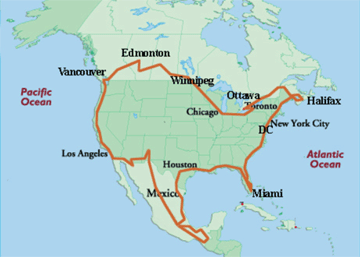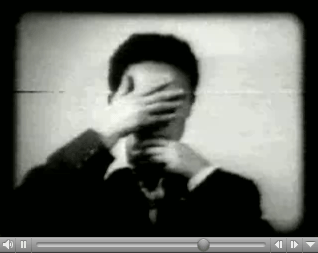« January 2006 | Main | March 2006 »
February 28, 2006
Engendering Urban Public Space

PUKAR Gender and Space Call for Papers
The PUKAR Gender and Space project has been researching the relationship between women and public space for the last two and a half years. We are currently at the writing stage of our research and would like to share our observations and analysis as well as receive inputs from the experiences of others who have been working on similar lines. To that end, we invite researchers, activists, advocates, journalists, architects, pedagogues and others working in the area of gender in relation to urban public space to a roundtable discussion of questions of engendering safety, infrastructure and citizenship.
We refer to public space as a part of the public sphere. Public spaces for the purposes of this roundtable refers to streets, market places (across class contexts – that is including bazaars and malls); recreational spaces such as parks, theatres, restaurants, coffee shops; infrastructure such as subways, foot-over-bridges and public toilets; and modes of public transport including railway stations and bus stops.
What we are looking for are presentations of research papers / studies / explorations that have engaged with questions of gender in relation to space, particularly urban public space. Each presentation is intended to be not longer than 15 minutes to leave more time for discussion. Presenters will receive an honorarium but the costs of travel and boarding will have to be covered by participants themselves. Date: 12 April 2006; Location: Mumbai. Please mail queries and abstracts of presentations to genderspace[at]pukar.org.in by March 10th, 2006.
Potential areas of focus could include:
Shrinking Public Spaces
Safety
Questions of Morality and Culture-policing
Sexuality and the City
Woman-friendly design
Legal concerns
Policy related matters
Infrastructure
For more information on the PUKAR Gender and Space project please see: www.pukar.org.in
PUKAR (Partners for Urban Knowledge Action and Research)
Address:: 1-4, 2nd Floor, Kamanwala Chambers, Sir P. M. Road, Fort, Mumbai 400 001
Telephone:: +91 (22) 5574 8152
Fax:: +91 (22) 5664 0561
Email:: pukar[at]pukar.org.in
Website:: www.pukar.org.in
Posted by jo at 10:48 AM | Comments (0)
Christian Nold

Greenwich Emotion Map
Greenwich Emotion Map by Christian Nold, Oct 2005 - March 2006: 6 month artist commission hosted by Independent Photography as part of 'Peninsula', a series of artist commissions on the Greenwich Peninsula.
Artist Christian Nold has been invited to collaborate with local residents from the Greenwich Peninsula to explore the area afresh and build an emotion map of the area that explores people's relationship with their local environment.
The project is set up as a series of participatory workshops that invite people to borrow a Bio Mapping device and go for a walk. The device measures the wearer's Galvanic Skin Response (GSR), which is an indicator of emotional arousal in conjunction with their geographical location. The resulting maps encourage personal reflection on the complex relationship between us, our environment and our fellow citizens. By sharing this information we can construct maps that visualise where we as a community feel stressed and excited.
As part of Node London, two separate public workshops will take place in March at Independent Photography, where people will be able to see the collective Greenwich Emotion Map as well as participate by going for their own walk in the local area.
A printed 'Greenwich Emotion Map' wall poster will be available from Independent Photography as well as a number of other local Node London venues.
"Will seeing other people's experiences, allow us to engage differently with our environment?"
Please contact us if you want to join in christian[at]emotionmap.net
Posted by jo at 10:39 AM | Comments (0)
AsylumNYC
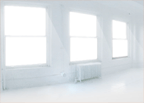
Call for Non-US Artists to Exhibit/Live in NYC
Wooloo Productions and White Box present AsylumNYC: an opportunity for non-US artists to exhibit and live in New York City. AsylumNYC will provide a talented artist with both a solo show at a recognized New York institution and the legal aid necessary to obtain an artists visa in the United States of America.
Location: White Box, 525 West 26th Street (between 10th and 11th Avenues), New York, New York 10001. Date: April 24, 2006, 8PM – April 29, 2006. All interested artists are encouraged to apply before April 1, 2006.
CREATIVE ASYLUM IN NEW YORK CITY: Based on the concept under exploration by Wooloo Productions in AsylumHOME.net, which addresses the difficulties faced by asylum seekers in Europe, AsylumNYC targets the challenge faced by artists interested in working in the United States.
After an online application process, White Box’s gallery space will become a creative asylum where successful applicants will be invited to develop a work/project from April 24 to April 29, 2006. Projects must actively challenge a regime(s) of exclusion in New York by including otherwise excluded individuals from cultural, economic or physical structures in the City.
Once an artist’s project is selected, AsylumNYC will provide a free lawyer to try to obtain a O- artist visa. If successful, the artist will be awarded the opportunity to stay in New York for three years.
February 8, 2006 marks the launch of the www.AsylumNYC.com where interested artists may apply until the April 1 deadline. To apply for asylum, artists must be able to be present at White Box, 525 West 26th Street (between 10th and 11th Avenues), New York, New York 10001 on April 24th, 2006 at 8 PM and STAY until 6:00pm on April 29th, 2006. While staying at White Box, the artists will be provided with lodging and food, but cannot leave the premises for the duration of the week.
ABOUT: Wooloo Productions is a provider of public and experimental spaces. Acting on the level of facilitation, every Wooloo production aims to encourage new forms of interaction and agency among members of diverse communities.
AsylumNYC is produced and organized by Wooloo Productions in close collaboration with White Box and the Franklin Furnace Archive in New York.
For more information, please email Martin Rosengaard, Media Manager: Martin[at]wooloo.org or call: +49 (0) 30 6676 3097
Please visit http://www.AsylumNYC.com for all project details.
Posted by jo at 10:30 AM | Comments (0)
Dowsing Poplar

Collaborative Mapping of Poplar
Saturday 4 March 2006 2-4 pm free: You are invited to join Melissa Bliss in creating a collaborative map of Poplar using dowsing and GPS. Full instruction in dowsing will be given. Please dress warm as we will be outside. Meet at Chrisp Street Idea Store (aka the library), 1 Vesey Path (south end of Chrisp Street Market), East India Dock Road, London E14 6BT--DLR All Saints, Bus 15 115 D6 D8. Info/booking: melissa[at]livingcinema.com
Posted by jo at 10:12 AM | Comments (0)
February 27, 2006
Report from the Inventor of the Flash Mob
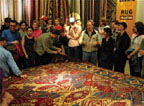
and Jane McGonigal's Response
" Not only was the flash mob a vacuous fad; it was, in its very form (pointless aggregation and then dispersal), intended as a metaphor for the hollow hipster culture that spawned it. I know this because I happen to have been the flash mob's inventor. My association with the fad has heretofore remained semi-anonymous, on a first-name- only basis to all but friends and acquaintances. For more than two years, I concealed my identity for scientific purposes, but now that my experiment is essentially complete, corporate America having fulfilled (albeit a year later than expected) its final phase, I finally feel compelled to offer a report: on the flash mob, its life and times, and its consummation this summer in the clutches of the Ford Motor Company." From My Crowd: Part 1 Or, Phase 5: A report from the inventor of the flash mob by Bill Wasik [via Interactive Media Division Weblog]
Jane McGonigal's Letter To the Editor: Bill Wasik’s account of the mob project is a fascinating perspective on eight of the thousands of flash mobs that were conducted worldwide in the summer and fall of 2003. However, as one of the San Francisco flash mob organizers, I have to take issue with his article as a definitive account of the phenomenon. Here in San Francisco, for instance, we consciously designed events that would be inclusive and inviting to passersby who hadn’t already received the secret “insider” instructions. When we whirled across a pedestrian crosswalk at a famous cable car stop, the mob grew larger over the course of the 10 minutes as tourists and locals joined in.
It was “transparent play”, not “dark play”—the rules were obvious to anyone who was watching, and there was ample opportunity to become a part of the experience. When we threw a massively multiplayer duck-duck-goose game in a public park, it was obvious to all nearby what we were up to—and that’s why many more people outside of the original network began to play with us. We picked a familiar childhood game so that as diverse a group as possible could jump in and take part. In short, we were explicitly working against what we perceived to be the exclusivity of the East Coast flash mobs. And that, I believe, is the true story of flash mobs—local organizers making their own decisions about which places are appropriate for play, and what kinds of play to design. Wasik invented the bones, the structure, of flash mobs—yes. But independent organizers in their own cities put their own flesh and blood on top of that skeleton. I have been enchanted and delighted by Capetown’s, Bogota’s, Montreal’s, and Warsaw’s interpretations of the flash mob, none of which looked like each other’s and each of which captured the imagination of local residents in their own site-specific, community-specific ways. That’s what makes the phenomenon interesting and meaningful in the long run: the diversity of spontaneous communities making their own public spectacles. Furthermore, I despaired to read Wasik be so dismissive of flash mobs, referring to them as a vacuous and forgettable trend. When I went to Singapore in the summer of 2004 to give a lecture about flash mobs—a lecture that was almost banned by the government because it was deemed a controversial subject matter—I met individuals who were profoundly moved and energized by the fact that three flash mobs had been successfully conducted in Singapore, despite the illegality of organizing more than four people in a public space without formal government permission. And when flash mobs were banned by the legislature in Mumbai, mobbers from all over the world joined together to offer the sole Mumbai organizer online advice and support (eventually, it was decided to move flash mobs to other cities in India.) Of course, I don’t mean to suggest that flash mobs are significant only in so far as they challenged local law. For me, the ultimate meaning lies in the lingering traces flash mob play has left in shared spaces. On more than one occasion, most recently a full two years after the fact, I have walked past the pedestrian crosswalk where we staged our first San Francisco flash mob and witnessed someone else whirling across it. I myself have continued to lead friends in whirling across it. Through our flash mob, we changed the source code of that site; a crosswalk at 4th and Market now frequently serves as a crosswhirl. Maybe I take play too seriously, but I am proud to have been a part of that change. Mr. Wasik, for many cities, flash mobs invigorated its cites and citizens for a great deal longer than the 10 minutes a traditional flash mob lasts. I’m sorry if ultimately that was not the point or the result of the flash mob experience in New York.
Sincerely,
Jane McGonigal
Posted by jo at 03:38 PM | Comments (0)
ROBOTIC ARTS, INFLATABLE AESTHETICISM
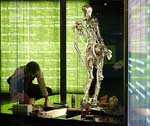
Uncovering the Primacy of Movement and Sound
EXPERIMENTAL ART FOUNDATION and the ADELAIDE BANK FESTIVAL OF ARTS 2006 present ROBOTIC ARTS, INFLATABLE AESTHETICISM.
Robotic Arts, Inflatable Aestheticism is a project comprising exhibition, workshop, and presentations by Chico MaMurtrie, one of the world's leading artists using robotic technologies. Chico MacMurtrie - born in New Mexico and now residing in New York - is the Artistic Director of Amorphic Robot Works (ARW). Formed in 1992, ARW is a group of artists, engineers and technicians working together to create robotic performances and installations. Chico MacMurtrie describes his vision, "The work is an ongoing endeavor to uncover the primacy of movement and sound. Each machine is inspired or influenced, both, by modern society, and what I physically experience and sense. The whole of this input informs my ideas and work."
3 MARCH-8 APRIL INFLATABLE BODIES A NEW GENERATION OF ROBOTIC SCULPTURE: Since its establishment, Amorphic Robot Works has investigated the nature of movement via the creation of multi-faceted machine-sculptures that play and interact in their uniquely designed environments. This artistic program has resulted in the creation of more than 250 mechanical sculptures of varying size, that assume anthropomorphic and abstract forms. One of the hallmark aspects of ARW's work is its direct contact with the audience. Rarely does the work appear on stage, behind ropes or behind glass. As the audience for the work has grown in size, so has the work itself.
To make performances visible, and yet still physically accessible to the audience, the work has been erected and performed upon integrated sculptures of increasing height. A new generation of permanent work from ARW will completely eliminate the metal and thus, the physically and logistically cumbersome weight. Humanoid forms will arise from high-tensile inflatable fabric skeletons, formless until air inflates the bones. The possibilities for range and kind of movement, are as broad as that for muscle and bone, but with little of the mass. This new generation of interactive performance sculpture from ARW allows not only for a broader exhibition base, but an interesting new robotic form that does not conform to the standard conception of either 'robotic' forms or the existing understanding of kinetic sculpture.
3-19 March: 10-5 Daily; 21 March-8 April: 11-5 Tues-Fri; 2-5 Sat; Admission Free
24 FEBRUARY-7 MARCH WORKSHOP THE CREATION OF ROBOTIC ARTS
The Robotic Arts Workshop will serve as a practical and theoretical platform for the creation of new generations of robotic sculpture and installation, developed by Chico MacMurtrie and Amorphic Robot Works. The event will urge the creation of robotic arts by Australian artists, as it provides hands-on exploration of robotic technologies. Drawn from national registration, artists and robot makers will assist in the building of the robotic structures for the exhibition.
24 February-7 March. Registrations closed.
6 & 7 MARCH FREE PRESENTATIONS
4-6pm Monday 6 March: Public lecture, Mercury Cinema, Lion Arts Centre, 13 Morphett Street, Adelaide
10.30am-12.30pm Tuesday 7 March: Artists' Week panel discussion "Emerging Fields" Elder Hall, University of Adelaide
PUBLICATION
A comprehensive catalogue with information about the project will be available.
FURTHER INFORMATION
Contact Experimental Art Foundation Director and Curator of ROBOTIC ARTS, INFLATABLE AESTHETICISM: Melentie Pandilovski: +61 (0)8 8311 7505.
EXPERIMENTAL ART FOUNDATION curates its exhibition program to represent new work that expands current debates and ideas in contemporary visual art. The EAF incorporates a gallery space, bookshop and artists studios.
Lion Arts Centre North Terrace at Morphett Street Adelaide * PO Box 8091 Station Arcade South Australia 5000 * Tel: +618 8211 7505 * Fax +618 8211 7323 * eaf[at]eaf.asn.au * Bookshop: eafbooks[at]eaf.asn.au * http://www.eaf.asn.au * Director: Melentie Pandilovski
The Experimental Art Foundation is assisted by the Commonwealth Government through the Australia Council, it arts funding and advisory body and by the South Australian Government through Arts SA. The EAF is also supported through the Visual Arts and Craft Strategy, an initiative of the Australian, State and Territory Governments.
Posted by jo at 12:36 PM | Comments (0)
Armin Medosch
![]()
Technological Determinism in Media Art
"Abstract: Technological determinism is the belief that science and technology are autonomous and the main force for change in society. It is neither new nor particularly original but has become an immensely powerful and largely orthodox view of the nature of social change in highly industrialised societies. In this paper I analyse the presence of technological determinism in general discourses about the relationship between social change and science and technology. I show that techno-determinist assumptions underlie developments in what is called technoscience, a term describing new practices in science and technology with particular relevancy for the related fields of genetic engineering and computer science. Those areas create a specific set of narratives, images and myths, which is called the techno-imaginary. The thesis of my paper is that the discourse on media art uncritically relies on many elements of the techno-imaginary. A specific type of media art, which is identifiable with people, institutions and a period in time, is particularly engaged with the tropes of the techno-imaginary. This strand, which I call high media art, successfully engaged in institution building by using techno-determinist language. It achieved its goals but was short lived, because it was built on false theoretical premises. It made wrong predictions about the future of a 'telematic society' and a 'telematic consciousness'; and it missed the chance to build the foundations of a theory of media art because it was and is contaminated by the false assumptions behind technological determinism.
Keywords: technological determinism, media art, techno-utopianism, artificial intelligence, artificial life, cybernetics, art, progress, critical theory." Technological Determinism in Media Art by Armin Medosch.
Posted by jo at 12:26 PM | Comments (0)
UpStage

Indigenous Maniacs
The next UpStage open walk-thru on Wednesday, 1 March, will include a short performance by participants of the recent UpStage workshop at the Computing Women's Congress in Hamilton, NZ.
The performance is called "Indigenous Maniacs" and was inspired by material presented at the congress, including Liz Bryce's MFA Master's project "Becoming Indigenous: an impossible necessity". Liz's work explores concepts inherited by Pakeha (white) New Zealanders through the desires of their colonial ancestors, and speculates on the paradox - to "become" indigenous. "Indigenous Maniacs" was created during 4 3-hour workshop sessions, and when it was presented at the conference we were all in the same room together - so it will be a new challenge to perform it with everyone in different locations, some on dial-up, and no physically present audience.
We'll meet in the Introduction Stage at the following times, then proceed to the Indigenous Maniacs stage: USA California: 12am; USA New York: 3am; UK: 8am; Western Europe: 9am; Finland: 10am; Australia NSW: 7pm; NZ: 9pm. For other local times, check http://www.worldtimeserver.com/.
Point your browser at http://upstage.org.nz:8081/stages/presentation; there's no need to log in for the performance (in fact we'd prefer it if you didn't), but if you'd like to log in and play afterwards, please email me for a log-in.
UpStage is a web-based venue for live performance; in this creative online environment, multiple players in remote locations work together to compile avatars, images, text, speech and web cams for real-time digital story-telling.
Helen Varley Jamieson: creative catalyst helen[at]creative-catalyst.com http://www.creative-catalyst.com; http://www.avatarbodycollision.org; http://www.writerfind.com/hjamieson.htm
Posted by jo at 12:12 PM | Comments (0)
SummerBranch
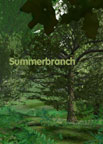
Truth and Artifice in Reproductions of Nature
Summerbranch is a new commission by Igloo that explores movement and stillness in nature. Using camouflage and other disguises, a person or a computer character can blend into a 'natural' environment captured and treated through the moving image. This installation uses the tools of the military-entertainment complex: computer gaming, motion capture, 3D environments and special effects to question what is truth and artifice in our attempts to reproduce nature. Through the creation of a computer generated virtual world Summerbranch seeks to address this through the use of disguise in dance and movement. Igloo not only investigate the role of the 'real' in virtual environments but also that of the reproduction of nature in the history of art and particularly landscape work.
4 March - 30 April 2006: Reception for the artists: Saturday 4 March 2006 2pm - 5pmSummerbranch: A Capture 4 co-commission between ArtSway, SCAN & Arts Council England.
Exhibition Related Events at ArtSway:
Motion Capture Demo Day: Monday 27 March 2006, 10:30am 3:30pm An opportunity for college students, lecturers and heads of departments to visit ArtSway for a demonstration day of Motion Capture Technology by experts Animazoo. Igloo will also be demonstrating this equipment in relation to their work. FREE
Gallery Talk: Saturday 8 April 2006 at 2pm: Join Igloo artists Ruth Gibson and Bruno Martelli on an informal tour of the exhibition as they discuss their work with SCAN Director Helen Sloan. FREE
AND
Digital Reality Flythrough: Tuesday 7 March, 6.30 - 8.30pm--DANA Centre, Queens Gate, London SW7 5HE: A seminar looking at realism in CG special effects and gaming. Representatives from software, gaming, arts and special effects will examine current trends in the real and hyper-real. As part of this seminar Igloo will present their research for Summerbranch. Organised by SCAN and Science Museum as part of Node.L Digital Media Festival, London (Free - Please contact DANA Centre for booking: 020 7942 4040 or tickets[at]danacentre.org.uk)
Summerbranch: Ruth Gibson & Bruno Martelli
Igloo Collaborators: Mark Bruce, Joanne Fong, Alex Jevremovic, John McCormick, Adam Nash, Alex Woolner
Many thanks to Henry Dalton, Lisette Punky Pixie, Matthew Andrews, Gillian Carnegie, Toby Zeigler, Verushka & everyone at ArtSway
Industry Support: Animazoo, RMIT, Coventry University, Bionatics, 3TRPD
PRESS + MEDIA:
If you require full press release, additional images or access to artists please contact Adelina Jedrzejczak on +44 (0)1590 682260 or by email adelina[at]artsway.org.uk
Additional information:
http://www.artsway.org.uk/email/summerbranch.htm
http://www.igloo.org.uk
http://www.scansite.org.uk
http://www.portlandgreen.com/capture4
http://www.ica.org.uk
http://www.artatwalsall.org.uk
ArtSway, Station Road, Sway, Hampshire SO41 6BA
Tel: +44 (0)1590 682260 E: mail[at]artsway.org.uk
Posted by jo at 11:56 AM | Comments (0)
desiredescape
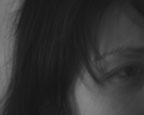
An Experiment in Community Building and Storytelling
Andrea, the creator of the website, is the fictional heroine of Shelly Silver's upcoming film project desiredescape.net. She starts the website as a means of escaping her life in a conservative Upstate New York town. In her own words:
"I want this to be a website for all of us who wish to escape some part of our lives (our job, famly, relationship, political or economic situation, city, country world), where we can share stories about our current lives, as well as our plans, hopes and strategies for our desired escape."
The stories Andrea receives will influence the trajectory of her story, and the images, sounds and videos uploaded to the site will be incorporated into the final film. So if you need to escape (or have successfully escaped already) please visit and contribute often! And if you've never wanted to escape, but are nevertheless curious about those of us who do, please visit too.
Posted by jo at 11:28 AM | Comments (0)
DiverseWorks Open call for netArt
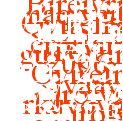
Expanding Awareness of netArt
Open call for netArt for online exhibition and inaugural premiere on the DiverseWorks website and DiverseWorks Artspace1. Submission deadline on March 25, 2006, midnight CDT. Selected projects will receive an honorarium and will officially premiere at the DiverseWorks Visual Arts opening event on April 28, 2006.
About the open call: DiverseWorks is seeking to bring greater awareness for netArt through this open call. Projects should use the web to its inherent (decentralized) distribution advantages and/or address current artistic, technological and social concerns related to web-based activity or visual culture at large.
The DiverseWorks Visual Arts Director and New Media committee will review projects based upon their topicality and technical feasibility. Selected projects will receive a $100 honorarium and will officially premiere at the DiverseWorks Visual Arts opening event on April 28, 2006. After the inaugural debut, DiverseWorks will have non-exclusive rights to display winning projects indefinitely on the DiverseWorks website.
Posted by jo at 09:16 AM | Comments (0)
February 24, 2006
The Franklin Furnace Fund for Performance Art
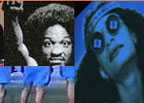
OPEN CALL TO ALL ARTISTS
DEADLINE: April 1st, 2006 (postmark date)
Each year Franklin Furnace awards grants in two categories. (1) “The Franklin Furnace Fund for Performance Art” supports emerging performance artists, allowing them to produce major works in New York; and (2) “The Future of the Present” funds the creation of "live art on the Internet," works which engage the Internet as an art medium and/or venue. Grants from either fund range between $2,000 and $5,000. Artists from all areas of the world are encouraged to apply.
Franklin Furnace has no curator; each year a new panel of artists reviews all proposals. We believe this peer panel system allows all kinds of artists from all over the world an equal shot at presenting their work. All applicants are automatically considered for both categories of awards. Every year the panel changes, as do the definitions of "emerging artist," "performance art" and "live art on the Internet." So if at first you don't succeed, please try again.
THE FRANKLIN FURNACE FUND FOR PERFORMANCE ART 2006: Supported by Jerome Foundation and the New York State Council on the Arts, Franklin Furnace awards grants between $2,000 and $5,000 to emerging performance artists, allowing them to produce major works in New York. Artists from all areas of the world are encouraged to apply.
THE FUTURE OF THE PRESENT 2006: Franklin Furnace awards artists an honorarium and offers its resources to facilitate the creation of "live art on the Internet," work which engages the Internet as an art medium and/or venue. Artists from all areas of the world are encouraged to apply.
HOW TO APPLY:
(THERE IS NO APPLICATION FORM)
1) You MUST submit a 100-word summary of your proposed work, as clearly written and complete as possible. You may also send more detailed description of your proposed work on additional pages.
2) All proposals to “The Franklin Furnace Fund for Performance Art” or “The Future of the Present” MUST be accompanied by documentation of your past work and/or work in progress. We prefer ½ inch videotape (VHS - NTSC American format) but you may submit DVDs, slides, photos, CD-ROMS, or URLs (either MAC or PC format) cued or burned to show the panel two to five minutes of your strongest work or work that is relevant to your proposal. If you submit a URL, it is recommended that you supply a navigation guide to all the sections of the website you would like us to visit. If you do not specify which fund you are applying for, you will automatically be evaluated for both funds.
3) You MUST include a self-addressed, stamped envelope for return of materials, or indicate that you will pick up your packet at our office.
4) You MUST include your Contact Information: Name, Mailing Address, Phone number/Fax number, Email/WWW.
5) You MAY also include a budget (i.e. space rental, equipment, tech personnel). If you have other funding sources for your project please indicate this in your budget.
6) You MAY also submit your resume, reviews of previous work, and any other support materials.
7) Every object you submit MUST be labeled with your name. It is helpful to indicate if the sample work you submit is previous work or part of your proposed work.
8) You MUST send your complete packet to:
2006-7 Proposals
Franklin Furnace Archive, Inc.
80 Arts - The James E. Davis Arts Building
80 Hanson Place #301
Brooklyn, NY 11217-1506
USA
You may also email your proposal to: dolores[at]franklinfurnace.org (url proposals only, please don't send large attachments)
Questions? Contact us via email at info[at]franklinfurnace.org or call us at 718
398 7255, or fax us at 718 398 7256
Privacy Policy: Unless otherwise specified herein, Franklin Furnace Archive, Inc. will not disseminate personal information obtained from donors, members, artists, visitors and others without their permission. Donors' names and donation levels will be publicized, although donors will be given the option to make their donations anonymous. As a condition of funding, recipients of funding from Franklin Furnace Archive, Inc. must permit Franklin Furnace Archive, Inc. to publicize their names and the amount of funding they received.
Franklin Furnace Archive, Inc.
80 Arts - The James E. Davis Arts Building
80 Hanson Place, #301
Brooklyn, NY 11217-1506
T 718 398 7255
F 718 398 7256
http://www.franklinfurnace.org
mail[at]franklinfurnace.org
JOIN TODAY! http://www.franklinfurnace.org/about/memb2005/index.html
Martha Wilson, Founding Director
Michael Katchen, Senior Archivist
Harley Spiller, Administrator
Dolores Zorreguieta, Program Coordinator
Posted by jo at 03:39 PM | Comments (0)
My Crowd: Part 1
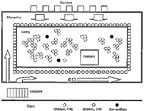
Or, Phase 5: A Report from the Inventor of the Flash Mob
[Left. Fig. 2—Schematic, MOB #3 in Grand Hyatt Hotel.] [...] "The basic hypothesis behind the Mob Project was as follows: seeing how all culture in New York was demonstrably commingled with scenesterism, the appeal of concerts and plays and readings and gallery shows deriving less from the work itself than from the social opportunities the work might engender, it should theoretically be possible to create an art project consisting of pure scene—meaning the scene would be the entire point of the work, and indeed would itself constitute the work.
At its best, the Mob Project brought to this task a sort of formal unity, as can be illustrated in MOB #3, which took place fifteen days after #2 and was set in the Grand Hyatt, a hotel fronting on Forty-second Street adjacent to Grand Central Station. Picture a lobby a whole block long sporting well-maintained fixtures in the high Eighties style, gold-chrome railings and sepia-mirror walls and a fountain in marblish stone, with a mezzanine ringed overhead. The time was set for 7:07 P.M., the tail end of the evening rush hour; the train station next door was thick with commuters, as was (visible through the hotel's tinted-glass facade) the sidewalk outside, but the lobby was nearly empty: only a few besuited types, guests presumably, sunk here and there into armchairs.
Starting five minutes beforehand the mob members slipped in, in twos and threes and tens, milling around in the lobby and making stylish small talk..." From My Crowd: Part 1 Or, Phase 5: A report from the inventor of the flash mob by Bill Wasik, Harpers Magazine.
Posted by jo at 11:44 AM | Comments (0)
Sonic Acts XI

The Anthology of Computer Art
Sonic Acts XI: Anthology of Computer Art--23 - 26 februari 2006, Paradiso / De Balie, Amsterdam. Live Streaming: For those of you who won't be able to make it to the festival, the performances at the festival nights will be streamed live through FabChannel. The conference will be streamed through de Balie.
Day 2: Friday 24-02-2006, Conferences:
Stephen Wilson - Artists at the Frontiers of Research [US]; 13:00 - 13:45 / Balie big hall: Stephen Wilson is a San Francisco author, artist and professor who explores the cultural implications of new technologies. The presentation is based on material from his MIT Press book, Information Arts: Intersections of Art, Science, and Technology.
Andreas Broeckmann - Image, Process, Performance, Machine. Aspects of an Aesthetics of the Machinic [DE]; 13:45 - 14:30 / Balie big hall--Andreas Broeckmann has been the Artistic Director of transmediale - international media art festival, Berlin since 2000. In texts and lectures he deals with post-medial practices and the possibilities for a machinic aesthetics of media art.
Matthias Weiß - Provides a micronanalysis of computer code fruitful insights on Computer arts? [DE]; 15:00 - 15:45 / Balie big hall--Matthias Weiß is specialized in computer art and net art, subjects on which he wrote various texts. The lecture provides an analysis within the realm of the micro-structure of each work will be presented, in order to discover the level of awareness of aesthetic problems, depicted via the means of programming language and programming itself as an artistic practice.
Ben Fry - Computational Information Design [US]; 15:45 - 16:30 / Paradiso small hall--The ability to collect, store, and manage data is increasing quickly, yet our ability to understand it remains constant. To gain better understanding Ben Fry proposes the solution that the individual fields be brought together as part of a single process which he calls Computational Information Design.
Rob Young - We are Dancing Mechanik: Computers, Pop and Embedded Chips [UK] 17:00 - 17:45 / Balie big hall--Rob Young is Editor at Large of the English music magazine The Wire. In his lecture he will speak about the role of the computer in pop music.
Discussion - moderated by Rutger Wolfson [NL]; 17:45 - 18:30 / Balie big hall--Rutger Wolfson is director of the museum for contemporary art De Vleeshal in Middelburg (NL). In 2003 he edited the book 'Kunst in Crisis', which gave rise to quite a bit of debate in the Dutch contemporary arts world.
Films: Concrete Cinema from the Groupe de Recherches des Images - part II [VAR] 19:30 - 20:30 / Balie small hall-- This compilation of short computer graphics films from the 1960's and early 70's is particularly interesting in that the filmmakers were heavily involved in designing both the hardware and the software that was used to create the images. Many of them were made in academic or scientific research facilities such as Bell laboratories, IBM or the National Research Council of Canada.
John Whitney in close-up [US]; 21:00 - 22:00 / Balie small hall--The computer pioneer, programmer and film-animator, John Whitney seamlessly combined these disparate disciplines for the journey of discovery which he called 'The Complementarity of Music and Visual Art
Live Performances
20:30 - 04:00 / Paradiso small hall and Paradiso big hall. The Friday programme is being compiled in collaboration with Jace Clayton (a.k.a. DJ/rupture), founder of Negrophonic and Soot Records. Jayce Clayton about the programme: I'm proud to say we've put together a Very Strong Lineup... a wildly international group of men & women responsible for some of the most exciting sounds in recent memory, from grime/dubstep to bellydance punk to mutant hiphop to ragga, breakcore, to accordeon+voice electronica.
grime / dubstep
Vex'D (UK - Rephlex)
Earz & Jammer (UK - Jah Mek the World)
DJ/rupture (US - Tigerbeat 6)
& No Lay + G-Kid (UK - Unorthodox)
Shadetek & Sheen (US - Warp)
dancehall / mutant hiphop
The Bug ft. Ras B (UK - Rephlex)
Beans (US - Warp)
Ghislain Poirier (CA - Chocolate Industries)
Filastine (US - Soot)
breakcore / jungle / freakstep / gabba
Hrvatski (US - Planet Mu)
Drop the Lime (US - Tigerbeat 6)
Aaron Spectre (US - Death$ucker)
Ove-Naxx & Doddodo (JP - Adaadat)
Scotch Egg (JP - Wrong Music)
bellydance punks / militant orientalists
Nettle (ES - theAgriculture)
2/5 BZ (TU - Gözel)
electronica / improv
Gustav (AU - Mosz)
PlanningtoRock (DE - Twisted Nerve)
Toktek & MNK (NL)
Andy Moor (NL - The Ex)
with additional visuals by
Daniel Perlin (US)
MNK (NL)
For more information visit: www.sonicacts.com
Posted by jo at 11:16 AM | Comments (0)
POLYLOGUE session

GAME ENGINES/SOCIAL ENGINES
29. March from 17:30 GMT (12:30 - New York, 18:30 - Prague): Details on HOW TO INSTALL AND USE THE ACCESS GRID
Game Engines/Social Engines: polylogue session about game engines, their social and political aspects. The interdisciplinary meeting should create an open space for deeper theoretical reflection on the recent development in the field of serious games. We are looking for various perspectives, examples and thoughts on social, political and artistic aspects of videogames. Researchers, theoreticians, game designers, programmers and artists are welcome to join the discussion. List of topics:
Videogames & Politics: - Political aspects of videogames - Representation and self-representation - Digital emancipation and creation of heroes (Middle East, China) - Persuasive games and games as means of propaganda.
Social Engines: - Social aspects of videogames - Activism and virus campaigns - Social networking in games - Educational videogames.
Abstracts of papers (15 to 20 min) should reach us before 20th March 2006 in order to facilitate moderation. Short presentations (10 min) are also possible, send us only the title. Please send us you telephone number, ICQ,
Skype etc..
Moderators: Vít Sisler, New Media Studies & Institute of Near Eastern and African Studies, Charles University of Prague. vsisler[at]gmail.com. Denisa Kera, New Media Studies Charles University of Prague, denisa.kera[at]ff.cuni.cz
This session is a part of a series entitled POLYLOGUES organized by the International center for art and new technologies (CIANT) in Prague & New media studies (Charles University) in cooperation with Georgia Institute of Technology & MARCEL network. It aims to stimulate interdisciplinary exchange of ideas via sessions moderated from Prague while having guest speakers from all over the world.
We hope to create a bridge between countries that will facilitate intercultural or rather intercontinental and interdisciplinary exchanges in the fields of art and new technologies. All sessions will be recorded and made available to general public in the archive.
Denisa Kera / New Media Studies, Charles University / kera[at]ff.cuni.cz/ +420
777 817 774
Pavel Sedlak / CIANT / sedlak[at]ciant.cz/ +420 737 731 347
CIANT & Charles University node http://www.ciant.cz/ag
Posted by jo at 11:01 AM | Comments (0)
February 23, 2006
Brooke A. Knight

Every Environment is Text-Rich: Framingham
Every Environment is Text-Rich: Framingham, by Brooke A. Knight, is one of a growing series of artworks that concern themselves with the interaction between the landscape and our reading of it. I believe that every place carries with it a history -- either social, political, natural, or geologic -- and that the history becomes a "text" that is inscribed onto the landscape.
The piece uses a remote robotic camera that is trained on downtown Framingham. While the image is of a typical Massachusetts downtown square, the camera moves to spell out letters that write a text onto the scene. That text is the grant that gave Danforth (after whom the museum is named) two-thirds of current day Framingham. In essence, EEITR:F is writing the history of the town directly onto the town. It is a kind of ephemeral grafitti, making the historical current, and tying the past to the place.
At the Danforth Museum, Framingham, Massachusetts; February 22-April 19, 2006. Reception and Artist Talk on February 26, 1:00 p.m.
Posted by jo at 05:54 PM | Comments (0)
aMAZElab

GOING PUBLIC '06
GOING PUBLIC is a mobile open platform, a network of production, reflection and cultural exchange, that establishes itself in peripherical areas. GOING PUBLIC invites artists to work on places of the city, such as railway stations, public libraries, schools, ect…. The project develops an attitude for intervention in social issues, together with local communities, in the fold of public policy, nomadism, of today’s precarious and temporary settlements. The researches are addressed to contemprary subjects such as: mobility, borders, new geographies, new EU, mediterranean and eastern cultures, micro-geographies, ect. At its 5° edition, the Going Public project will develop, over the year, a series of activities and appointments for reflection and research, such as:
"Cyprus Day. Rebuilding geographies" : 25th February 2006, at Fondazione Pistoletto/Cittadellarte, Biella--For the first time in Italy, there will be a “study day” dedicated to Cyprus, its culture and its human and territorial geography, the social issues, the green line”, the wall crossing the town of Nicosia, the co-operation activities between the communities in the North and South of the Island, as well as its artistic events and cultural exchanges.
A round table to bring creativity into the problems of one of the ‘hottest’ spots in the Mediterranean area. The subject will be discussed with contributions from:
- Michelangelo Pistoletto, artist and art director of Cittadellarte, a foundation working to inspire a responsible change in society through artistic ideas and creative projects.
- Claudia Zanfi, art director of aMAZelab, creator of the Going Public social and public art project.
- Socrates Stratis, architect and urban designer in Nicosia, offering his research experience in to subject of territories in transformation.
- Sophia Karamani, art critic, part of the cypriot Social Gym collective, protagonist of creative projects targeted toward responsible transformation of the social sphere.
- H. Meyric Hughes, Chairman of Manifesta, who will present the 6° edition of the contemporary art event in Nicosia.
The round table will be introduced by Chiara Bertola (co-founder Love Difference project); it begins at 4 pm, via Serralunga 27, Biella, and is open to the public. From 10 pm the evening will continue with a number of films and video on the subject of the Mediterranean area and its cultures.
The meeting is organised by aMAZElab , which has been working since 3 years on the theme of cultural interchange in Cyprus, together with Fondazione Pistoletto/ Cittadellarte and Love Difference, Artistic Movement for an InterMediterranean Policy.
For info: aMAZElab, ph/fax +39.02 6071623, info[at].it,
Posted by jo at 05:34 PM | Comments (0)
STRP Festival

Art, Technology and Popular Culture
The STRP Festival will take place between the 24th and 26th of March 2006 in the former industrial area, Strijp S, in Eindhoven, the Netherlands. STRP is a festival at the intersection of art, technology and popular culture in the full context of all art disciplines. A festival where the public is treated to a broad palette of works through in-depth presentations and large spectacles, which provide an image of how visual art, design, stage arts, film, architecture and popular culture develop themselves through the means or appliance of both new and existing technology.
ROBOTICS: Amorphic RobotWorks (USA) - Inflatable Bodies, Robotlab (GER) - Juke_bots, Bill Vorn (CAN) - Hysterical Machines, Pascal Glissmann, Martina Höfflin (GER) - Electronic Life Forms (ELF), Garnet Hertz (CAN) - Cockroach Controlled Mobile Robot #3, Gijs van Bon - Arabesk #23, Time's up/HRL (AUT), Bar Bot - Dr. Christoph Bartneck (GER) - eMuu, Robbert Smit, Graham Smith, HKU - Telemoby, Björn Schülke (GER) - Nervous, Markus Lerner, Andre Stubbe (GER) - Outerspace, Michiel van Overbeek - Nazarenos, Lara Greene (UK) - You Move Me, Fred Abels & Mirjam Langemeijer - Dirk.
INTERACTIVE ART: Marnix de Nijs - RMR (runmotherfuckerrun), C6 (UK) - Want Need, //////////fur//// art entertainment interfaces (GER) - PainStation, Marnix de Nijs & Edwin van der Heide - Spatial Sounds, Mateusz Herczka - 44\13, Debbie does art - Cockroachlounge, Walter Langelaar - SUB-OBJECT_2.1, Raymond Deirkauf, Beyond Expression - Ray's, Aldje van Meer en Radboud Mens - Realsound, Kim Boekhout van Solinge - Ruissimulatie, David Kousemaker - TouchMe, Prohaska, Sägmüller, Demblin (AUT) - Unplugger v1.1/Plug In to Black Out, Prohaska (AUT) - KRFTWRK, Crew (BE) - Degenerator 2.0, Paul Klotz - 3D-Quoter.
MUSIC: Dj's--Jeff Mills (DVJ-set, USA) - Derrick May (USA) - Daniel Wang (USA) - DJ Krust (UK) - Addictive TV (DVJ Set, UK) - Dick El Demasiado - Lady Aida - Steffi - Martyn (DJ Pan) - Robob - Rick Angel - Ari Daily - Caz One Live: Karl Bartos (Ex-Kraftwerk, GER) - Mouse on Mars (GER) - DMX Krew (UK) - Atom Heart (GER / CHI) - Octave One (USA) - Joris Voorn - Secret Cinema - Zeena Parkins & Ikue Mori (USA) - Beautyon (UK) - Daniel Wang (USA) - Kettel - Geigercounting - Dijf Sanders (BE) - Dexter - Like a Tim - Vert (GER/UK) - Drillem - Taeji Sawai (JPN) - Ella Bandita - Yutaka Makino (JPN) - RA-X and the Raiders of the Lost Cause - David Grubbs (USA) - Solid Decay - Hrvatski.
VISUALS: Live Cinema--Peter Greenaway (UK): Tulse Luper VJ performance - Skoltz Kolgen (CAN) - Telcosystems - Addictive TV (UK): The Eye of the Pilot - Boris en Brecht Debackere (BE): Rotor - Optical Machines - SXNDRX: Videoboxing; Video-art/art videoclips--Cinefeel: Music Videos - Addictive TV (UK): Mixmasters - Optronica (UK): Visual Music on the Screen - WORM: Live Cinema DVD 1 - NOTV: Visual Music 2 - Floris Kaayk: The Order Electrus; Vj's--VJ Oxygen others. Live visuals & presentations by Holland-Interactive. Special outdoor light installation by Har Hollands.
Films: Fritz Lang (GER) - Metropolis, Fred M. Wilcox (USA) - Forbidden Planet, Mamoru Oshii (JPN) - Ghost in the Shell 2, Het uur van de wolf - Op zoek naar een vergeten toepassing, Lesic, Lindgreen & Pancras, When I sold my soul to the machine, Len Lye (NZL) - Birth of a Robot, Lillian Schwartz (USA) - Pixilliation, Robert Seidel(GER) -Grau, Phillipp Hirsch (GER) - Inside, Alexander Rutterford (UK) - Gantz Graf, Alexander Rutterford (UK) - 3Space, Johnny Hardstaff (UK) - Future of Gaming, George Melies (FRA) - Le Voyage dans la Lune
OTHER: Theatre: Pipslab: The washing powder conspiracy, produced by Paradiso-Melkweg Productiehuis - Crew (BE): _U - Eboman: SampleMadnesS
Workshop: Ralf Schreiber, Tina Tonagel and Christian Faubel (GER) 'Chirping and Crawling' Robotworkshop
Lectures: Karl Bartos (Ex Kraftwerk, GER) - Bas Haring - Dirk van Weelde - Dr. Christoph Bartneck (GER) - Kees Tazelaar - Koert van Mensvoort Peter Verhelst (BE) - Hans Beekmans - Waag Society
STRP Foundation
P.O. Box 272 / 5600 AG Eindhoven / The Netherlands
Tel: +31 40 2367228 / Fax: +31 40 2377676
Posted by jo at 05:20 PM | Comments (0)
11-12 March 2006 Utrecht:
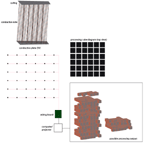
Interaction is the Crystalpunk Drug
A Crystalpunk Workshop for Soft Architecture event Oudenoord 275, Utrecht, NL: Essentially it was William Butler Yeats who defined soft architecture as early as 1888 when he wrote: "Behind the visible are chains on chains of conscious beings, who are not of heaven but of earth, who have no inherent form but change according to their whim, or the mind that sees them. You cannot lift your hand without influencing and being influenced by hoards. The visible world is merely their skin.". Yeats was talking about magic, but we are thinking about technology (and pointing out their similarities is pointing out the obvious) that is promising to make this worldview into a reality: equipping mindless objects with in silico brains, turning rooms into artificially intelligent machines.
Gargoyle computational processes evolving the optimal design solution to a problem and printing it in 3D, in real size. Every time you wave your hand a pandemonium of software agents start to reason on what they could do for you. Objects can sense and act and acquire personalities of which the complexity rises as their ecosphere becomes richer and more connected. Architecture is at the forefront in applying these ideas, at the same time it will pose new challenges to the practise.
Between September and December 2005 the Crystalpunk Workshop for Soft Architecture brought together a large international group of people to think about what all this means for spatial design and experience. Looking back at what we learned some underlying threads emerged. From the beginning we had only a peripheral interest in the technology itself; we proved it's donkey stuff of which the basics you can learn yourself for cheap and without teachers. But what had our real interest was what to do with it. A room that does things for you may sound like a good idea, at least to some, but what if locks you out of the control structure in your own room: the inability to switch off the lights, say. We are not interested in silly input-output control situations of the kind architects and product designers come up with, but in rich Yeatsian entities that have their own life independent of us.
For so long the marketing department can understand it we are not interested; we want technology to become BacterioPoetic.
In the weekend of 11 and 12 March the workshop will open for the last time to follow up on some leads left unexplored. Other niceties, activities and installations by Tao Sambolic and Thomas Laureyssens, we are like a tapas bar, will be presented on the side.
Saturday 11 March: 14.00- 18.00-- BOT / AIML workshop by Mario Campanella. From the early days of computer based interaction bots, interfaces through which you interact with software in normal language, have been one recurrent strategy. Recently a new wave of interest in them has taken place, this time to allow seamless communication with all sorts of devices. In this informal hands-on workshop, Mario Campanella, will first explain about the history of bots before getting into AIML. This "Artificial Intelligence Markup Language" provides a framework for Bot designers to capture knowledge. The aim of the workshop is to give you the knowledge on how to build the 'brain' of a Chatbot: using the general purpose AIML database, you will create new entries for an existing one, or create your own chatbot with a special purpose 'persona'.
It is advised to bring your own laptop and have one of the Alice programs installed: http://aitools.org/downloads. There are versions in most popular programming languages.
Here you can find some of the existing AIML sets: http://aitools.org/aiml-sets/
Presentations by:
Mirjam Struppek was trained as an urban planner. Right now she is organising the second URBAN SCREENS conference which is the crucial event in the ongoing formation of a new field of expertise: the (growing) infrastructure of large digital moving displays, that increasingly influence the visual sphere of our public spaces. The main question being whether these screens can become a tool to contribute to a lively urban society, involving its audience interactively?
Z-25 is Utrecht based group of artists who will present their recent "Indoor RFID" project. RFID chips allow object to be tagged and monitored. The expectations (fuelled by industrial rhetoric and citizens paranoia) is that these will become an explosively present part of society. Z-25 will show some of its power. Who needs Amsterdam when there is Z-25?
Adam Somlai-Fischer is part of Aether, one of the hottest design studios working in interactive architecture. His work is part research and part design, often beautiful always thought provoking. During a previous Crystalpunk workshop he has proven himself to be exceptionally skilled with the soldering-iron too.
Pablo Miranda Carranza runs Army Of Clerks, which explores generative and algorithmic approaches in architecture and design. Hoping to find utter bliss in the relentless accumulation of unintelligent calculations, mindless arithmetic performed by computational armies of clerks. Carranza's work on the electro-chemical devices by Gordon Pask unwittingly (and after a long process of confabulation) gave the crystalpunk movement its notion of crystals as entities encoding data in form from which it owes the name, for this alone he deserves his place in heaven.
Nocolas Nova is a key blogger in the world of locative media. Recently he has been taking up an interest in Blogjects: an example of the 'Internet of Things', i.e. a network of tangible, mobile, chatty things enabled by miniaturization. In its most basic form, a blogject is not dissimilar to people that blog - it is an artefact that can disseminate a record of its experiences to the web. He even organised a workshop on them.
Jelle Feringa of the Paris based design agency EZCT is crystalpunk's guru for Voronoi-crystals and genetic design. Always ready to discuss radical uses of new technology, instead of making them do old things different, EZCT is slowly claiming fame with their evolved chairs. Right now they are building a 3D printer.
All event are free. Check the website for further details, the same applies for technical details of the BOT workshop.
CPWfSA initiated by socialfiction.org, produced by IMPAKT
Posted by jo at 04:18 PM | Comments (0)
Dynamics of Human Interaction Articulated by Technology
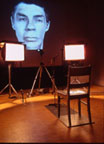
CROWDS / CONVERSATIONS / CONFESSIONS
March 11–June 10--Max Dean and Kristan Horton, Atom Egoyan, Laiwan, George Bures Miller, Don Ritter and David Rosetzky.
Crowds/Conversations/Confessions brings together the work of seven international artists who explore the dynamics of human interaction, articulated by the use of technology. Their works play with modes of interpersonal communication, from the discursive structure of conversations to the one-sided delivery of confessions and public addresses. Each of the works promises a form of engagement, communication and personal contact, but each also suggests that this is a fiction, a promise of technology that can never be fulfilled.
In George Bures Miller’s installation Conversation/Interrogation an office chair faces a suspended television. As a viewer sits in the chair a shot of a man (the artist) appears on the screen and begins a conversation. The viewer quickly realizes that the interviewer is talking to them. The questions asked by the on-screen interviewer shift between the banal and the manipulative, so it is never quite obvious what the intent of the conversation is.
Vox Populi is a responsive installation by Don Ritter that provides the opportunity of leadership to anyone. Visitors are invited to speak from a lectern equipped with a microphone and teleprompter that displays the text of a number of speeches by historical figures such as John F. Kennedy, Martin Luther King Jr. and George W. Bush. When assuming the role of leader and depending on how well one delivers the scripted texts, the video-taped crowd responds with various degrees of support, ridicule or hostility.
Be Me by Max Dean and Kristan Horton is an interactive video installation that uses new animation software to investigate the idea of self-image and the inviolate nature of personal identity. The viewer takes a seat, and a projected image of the artist asks, “So, do you want to be me?” “Then say something”. The participant’s response, their voice, expression and movement animate the projected image. Dean’s face thus becomes a site onto which the words, sounds and gestures of another are projected.
In Australian artist David Rosetzky’s installation, Custom Made, a series of videotaped characters move in and out of focus, addressing the camera and then dissolving away. Each character seems to be confessing to us, offering a deeply personal description of an important relationship. In each case we try to imagine the unseen other and empathize with the speaker. Through their words we have a glimpse into another life, one that is very familiar and intimate, yet always separate from ours.
Canadian Filmmaker, Atom Egoyan’s installation, Hors d’usage: Le recit de Marie- France Marcil, was derived from a soundscape exhibition created for the Musée d’art contemporain de Montréal based on old sound recording machines and private tapes contributed by Montréal residents. In this work, a woman is confronted with long forgotten memories, a time from her past that is only recalled through her interaction with the recording. Hors d’usage continues Egoyan’s exploration of the relationship between technology, memory and human relationships.
Using similar “low” technology, in this case 16m film, Vancouver artist Laiwan’s installation, Kiss, speaks of how true intimacy may not be possible when mediated by technology. In this work, a couple is endlessly denied the culmination of their affection, the two projections being structured to ensure that their images can never meet.
Opening Reception Friday, March 10, 7 pm
Posted by jo at 10:24 AM | Comments (0)
Human Avatars
![]()
The Guilt Eye
Human Avatars, a multimedia installation created by Andrea Zapp with the Vini Reilly's music, plays on two classic levels: the real and the virtual. The visitors have to walk through the installation's space, discovering a small wood cabin, which they are asked to enter. Once inside, the bodies are shot and projected into a scaled down model of the same cabin. Peeking through a small window the visitors can look at the movements of their own projections and at others made by other persons. The crossed game of shooting and projecting pushes everybody to have a visual contact with a different 'self', that could equally be a real person or his own avatar, assuming the role of a spy and, unconsciously, of a person kept under surveillance. Despite the architectures and the scenario are friendly and accessible, the interactive experience immediacy remains pending and ambiguous. Probably one of the inhibiting elements is the same interactive fulcrum. The eye and its artificial replacement often carry uneasiness, because they are connected to the surveillance and control feeling. Furthermore, in this case, the holistic lyricism, made by the consciousness raising of one's own being in the world is suffocated by the voyer's sense of guilt. This role is evidently assumed by the observer, enhanced because it's not a hidden spying activity, but an a vile act, made for all the world to see." Francesca Tomassini, Neural.
Posted by jo at 10:17 AM | Comments (0)
DANUBE UNIVERSITY KREMS, AUSTRIA 2006/07 Program
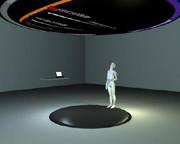

MediaArtHistories MA
Danube University's Department for Applied Cultural Studies, Center for Image Science is now accepting applications for the 2006/07 class of their MA Program in MediaArtHistories starting november. This two year low-residency degree provides students with deeper understanding of the most important developments of contemporary art through a network of renowned international theorists, artists and curators like Steve DIETZ, Erkki HUHTAMO, Lev MANOVICH, Christiane PAUL, Paul SERMON, Oliver GRAU, Gregor LECHNER, Jens HAUSER and many others.
Artists and programers give new insights into the latest and most controversal software, interface developments and their interdisciplinary and intercultural praxis. Keywords are: Strategies of Interaction & Interface Design, Social Software, Immersion & Emotion, Artistic Invention.
Using online databases and other modern aids, knowledge of computer animation, net art, interactive, telematic and genetic art as well as the most recent reflections on bio & nano art, CAVE installations, augmented reality and locative media are introduced.
Historical derivations that go far back into art and media history are tied in intriguing ways to digital art. Key approaches and methods from Image Science, Media Archaeology and the History of Science & Technology will be discussed. Media Art History offers a basis for understanding evolutionary history of audiovisual media, from the Laterna Magica to the Panorama, Phantasmagoria, Film, and the Virtual Art of recent decades.
The MA MediaArtHistories is located in the the Center for Image Science, housed in a 14th century Monastary, which holds also the historic G*ttweig collection, with more than 30.000 original graphics, etchings, prints etc., dating from the Renaissance and Baroque era until today. It contains works of various German, Italian, Dutch, French and British artists (from D*rer to Klimt…). This allowes contextualization of the latest media art in its art and image history and the courses to work directly with originals - from book illustration to photography to the most contemporary media art.
MediaArtHistories MA is also based on the international praxis and expertise in Curation, Collecting, Preserving and Archiving and Researching in the Media Arts. What are, for example, the conditions necessary for a wider consideration of media art works and of new media in these collectionsof the international contemporary art scene? And in which way can new Databases and other scientific tools of structuring and visualizing data provide new contexts and enhance our understanding of semantics?
DANUBE UNIVERSITY -- located in the UNESCO world heritage WACHAU
Danube University Krems is the first public university in Europe which specializes in advanced continuing education offering low-residency degree programs for working professionals and lifelong learners. The MA MediaArtHistories is located in the the Center for Image Science, housed in a 14th century Monastary, remodeled to fit the needs of modern research in singular surroundings. Krems is a traditional educational town - with 30 schools and high schools attended by more than 10,000 students. Therefore, Krems’ environment is richly furnished with restaurants, hotels, guest-houses and students’ hostels, as well as leisure-time and cultural facilities. The idyllic environment of the Wachau, which belongs to UNESCO world heritage, its exquisite wines and numerous sports facilities, contribute to the quality of life of students at the Danube University Krems. www.donau-uni.ac.at www.donau-uni.ac.at/en/studium/fachabteilungen/kultur/zentren/zbw/index.php
ADDITIONAL SPECIALITIES OF THE CENTER FOR IMAGE SCIENCE
The Center offers long term preservation and growth of the Database of Virtual Art. As pioneer in the field, the Database of Virtual Art has been documenting the rapidly evolving field of digital installation art since 1999, supported by Deutsche Forschungsgemeinschaft. The research-oriented, complex overview of immersive, interactive, telematic and genetic art has been developed in cooperation with renowned media artists, researchers and institutions.
The Database of Virtual Art and Leonardo/ISAST and the Banff New Media Institute collaborated to produce the first international art history conference covering art and new media, art and technology, art-science interaction, and the history of media as pertinent to contemporary art. In late September, more than 200 new media practitioners from around the world gathered at Banff New Media Institute (BNMI) for Refresh! The complete conference is available as a Webcast at: http://www.mediaarthistory.org/navbar-links/refresh/origprogram.html
DIGITALIZATION
The DigitalizationCenter is equipped with an ultra-modern multifunctional digital reproduction system for digitizing works of art, graphics, maps and similar originals. The highest resolution combined with fast scan speeds and the possibility of serial image processing enable a cost effective workflow. The workstation is used for the digitalization of the G*ttweig collection of engravings and other collections, as well as for teaching purposes. New Digitalisation Center for Cultural Studies planed - further information available soon.
:: OTHER COURSES: Starting Autumn 06
--> Certified Expert „Visual Competencies“, 1 Semester
--> Certified Expert „Digital Asset Management“, 1 Semester
--> Certified Expert „Iconography“, 2 Semester
--> Certified Expert „Photography“, 2 Semester
--> Certified Expert “Exhibition Design and Management”, 1 Semester
--> Certified Expert „Scientific Visualization“, 2 Module
=> http://www.donau-uni.ac.at/zbw
The MediaArtHistories program in Krems is unique in that it actively seeks to assemble a diverse group of students and welcomes applications from Europe, Asia, Africa, North and South America. Space is limited, so please apply as soon as possible. Additional information is available on the programs website.
If you would like an information pack, or if you have any questions, please contact in the first the office at the Center for Image Science, Danube University Krems, Dr.-Karl-Dorrek-Str. 30, 3500 Krems. Email: petra.gratzl[at]donau-uni.ac.at
If you have further queries about specific contents of the program, please contact Mag. Jeanna Nikolov jeanna.nikolov@donau-uni.ac.at or program director Prof. Dr. Oliver Grau oliver.grau[at]donau-uni.ac.at (Head Department for Applied Cultural Studies and Center for Image Science).
Posted by jo at 09:30 AM | Comments (0)
February 22, 2006
Wearable Game
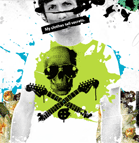
Clues Woven Into Cloth
If you find yourself wearing clothes from a new company called Edoc Laundry, beware: Strangers may walk up to you on the street to examine the intricacies of your shirt's patterns. That's because Edoc Laundry's first line, expected to launch March 1, literally weaves an episodic, multimedia game into the fabric of the garments. The Seattle-based company is believed to be the first to attempt such a fashion feat.
The idea is an extension of so-called alternate-reality games, or ARGs, in which people try to solve puzzles that are propagated online but require players to team up to find clues in the real world. Usually, the games are promotional vehicles for other products, including video games and movies. Examples of ARGs include 2004's "I Love Bees," which was a lead-in to Bungie Studios' "Halo 2" for Xbox, and 2005's "Last Call Poker," which promoted Activision's "Gun."
Edoc Laundry's line integrates an ARG into its shirts, hats and accessories. The story involves the mysterious death of the manager of a fictional band called Poor Richard. Players find clues such as words and symbols embedded in the clothes. They then head to a Web site where they can unlock complex elements of the overriding story of Poor Richard and its music..." Continue reading Wearable game weaves clues into cloth by Daniel Terdiman, CNET News.com. [via Jim Downing on Smart Mobs]
Posted by jo at 07:33 PM | Comments (0)
Nancy Nisbet

Pop! Goes the Weasel
"From closed circuit TV and video monitoring, email snooping software such as Carnivore, tracking through credit card usage and location mapping via GPS enabled cell phones; surveillance is omnipresent. It may not be the act of surveillance but rather the collection, storage and use of our ‘data identities’ in a centralized database that presents the greatest threat. Who will have access to the database? How will the data be used? How will people be protected from data profiling and marginalization? Widespread concern for public security is generating significant support for surveillance, authentication and information gathering systems. The possibility of the convergence of databases of collected surveillance and other information presents serious threats to personal privacy and freedom.
Pop! Goes the Weasel, an interactive art installation exhibited in Nagoya, Japan in 2002, explores resistance to the use of Radio Frequency Identification (RFID) as a human tracking system. Identities are blurred as RFID tags are shared. The significance of the collected data is shifted as visitors repeatedly interfere in the system. A video projection containing the implantation of an RFID microchip into the artist’s hand and a visible real-time reflection of visitors being tracked accentuates uneasiness.
This installation aims to remind participants of the ubiquity of surveillance structures and to encourage visceral responses to implanted RFID tags as a potential future mode of surveillance. Although the installation appears to require visitors to follow certain ‘rules’, the observance of these rules stems from participant’s own respect or lack of respect for these rules. The system is really quite leaky and allows motivated visitors to avoid surveillance and develop other ways for engaging the work without accurately being tracked. This art installation presents visitors with opportunities for experimenting within an RFID system by allowing them to avoid it, to subvert it and to intervene in it as possible strategies of resistance.
Pushing beyond the spectacle of implanting two RFID microchips into my body, I make a bold and playful entrance into resistance of sanctioned surveillance. I challenge the authentication systems assumptions regarding identity. Is a person’s identity singular? Is it constant? What is its connection to the body? Is identity positively ascertainable? In the installation identities are distributed as visitors share their ID badges; one badge is no longer connected to a single person but some anonymous group of users. In the case of my own ‘identity’ the implantation of two unique microchips allows for a multiple identity; which ID number is the authentic one? By provoking questions concerning authentication systems I aim to encourage resistance and challenge both developers and governments to ensure the protection of personal privacy and freedom." Nancy Nisbet, Risky Surveillance: Distributed and Multiple Identity(ies) as Resistance, Subtle Technologies Conference, 2003. [Related 1, 2, 3]
Posted by jo at 07:15 PM | Comments (0)
Jeff Han
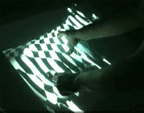
Multi-Touch Interaction Experiments
While touch sensing is commonplace for single points of contact, multi-touch sensing enables a user to interact with a system with more than one finger at a time, as in chording and bi-manual operations. Such sensing devices are inherently also able to accommodate multiple users simultaneously, which is especially useful for larger interaction scenarios such as interactive walls and tabletops.
Since refining the FTIR (frustrated total internal reflection) sensing technique, we've been experimenting with a wide variety of application scenarios and interaction modalities that utilize multi-touch input information. These go far beyond the "poking" actions you get with a typical touchscreen, or the gross gesturing found in video-based interactive interfaces. It is a rich area for research, and we are extremely excited by its potential for advances in efficiency, usability, and intuitiveness. It's also just so much fun!
Our technique is force-sensitive, and provides unprecedented resolution and scalability, allowing us to create sophisticated multi-point widgets for applications large enough to accomodate both hands and multiple users.
The drafting table style implementation shown here measures 36"x27", is rear-projected, and has a sensing resolution of better than 0.1" at 50Hz. Stroke event information is sent to applications using the lightweight OSC protocol over UDP.
Posted by jo at 06:57 PM | Comments (0)
fastbreeder
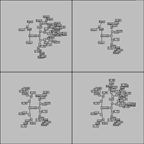
An Experimental Genetic Programming Synthesiser
Fastbreeder is essentially a 4 button synth. The idea is to grow code by choosing from a range of automatically generated variations of functions, you don't have to know how they work, but each function creates a sound which can be selected by you. The following generation is then created containing mutants of your chosen sound. You can refine and develop the sound just by auditioning and choosing the best one each time.
The interface shows you the code graphically, as a tree. These trees are attempts to clearly represent code structure, giving you some feedback on what is being evolved. Conventional listings are not that informative with GP (genetic programming), as deeply functional code such as this is hard to read linearly...
Posted by jo at 06:40 PM | Comments (0)
NET(WORKED) ART COMPETITION
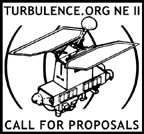
DEADLINE APPROACHING
Turbulence.org is pleased to announce its New England Initiative II, a juried, networked art competition. Three projects by New England artists will be commissioned and exhibited on Turbulence and in real space (venue to be announced). Each award will be $3,500. The jury consists of Julian Bleecker, Michele Thursz, and Helen Thorington. This project is made possible with funds from the LEF Foundation.
PROJECT CONCEPT: Net art projects are "art projects for which the Net is both a sufficient and necessary condition of viewing/expressing/participating" (Steve Dietz). They live in the public world of the Internet. Recently, however, wireless telecommunications technologies have enabled computation to migrate out of the desktop PC into the physical world, creating the possibility of “hybrid” networked art, works that intermingle and fuse previously discrete identities, disciplines, and/or fields of activity such as the Internet and urban space. (See the networked_performance blog—specifically the categories Locative Media and Mobile Art and Culture.) Borders are disintegrating and new identities are emerging. We encourage applications by net artists and artists working on networked hybrid projects.
PROJECT TIMELINE:
Proposal Deadline: February 28, 2006
Selected Projects Announcement: March 15, 2006
Project Launch/Exhibition: October 1, 2006
SELECTION CRITERIA: (1) artistic merit of the proposed project; (2) originality; (3) degree of performativity and audience participation; (4) level of programming skill and degree of technological innovation; and (5) extent of collaborative and interdisciplinary activity.
PROPOSAL GUIDELINES:
(a) Your name, email address, and web site URL (if you have one).
(b) A description of the project's core concept and how it will make creative use of digital networks (500 words maximum).
(c) Details of how the project will be realized, including what software/programming will be used. Specs for the Turbulence server are available here. You may request additional software but we cannot guarantee it.
(d) Names of collaborators, their areas of expertise, and their specific roles in the project.
(e) A project budget, including other funding sources for this project, if any.
(f) Your résumé/CV and one for each of your collaborators.
(g) Up to five examples of prior work accessible on the web.
Email submissions (the web site URL) to turbulence[at]turbulence.org with NE 2 in the subject field.
JUROR BIOGRAPHIES:
Julian Bleecker has been involved in technology design for over 15 years, creating mobile, wireless, and networked-based applications across a diversity of project idioms including entertainment, art-technology, brand marketing, university research and development, interactive advertising and museum exhibition. His expertise is technology implementation, innovation and concept development. Bleecker is currently Visiting Assistant Professor at the University of Southern California's Interactive Media Division and Critical Theory departments, and is participating in a research group at the Annenberg Center's Institute for Media Literacy exploring the future of mobile technology applications. He has a Ph.D. from the History of Consciousness Board at the University of California Santa Cruz, a Masters of Engineering from the University of Washington, Seattle, and a BS in Electrical Engineering from Cornell University.
Helen Thorington is co-director of New Radio and Performing Arts, Inc. (aka Ether-Ore), the founder and producer of the national weekly radio series, New American Radio (1987-1998), and the founder and producer of the Turbulence and Somewhere websites. She is a writer, sound composer, and radio producer, whose radio documentary, dramatic work, and sound/music compositions have been aired nationally and internationally for the past twenty-three years. Thorington has created compositions for film and installation that have been premiered at the Berlin Film Festival, the Whitney Biennial, and in the Whitney Museum’s Annual Performance series. She has produced three narrative works for the net, and the distributed performance Adrift which was presented at the 1997 Ars Electronica Festival and at the New Museum in New York City, 2001, among other places. Thorington has also composed for dance and performed with the Bill T. Jones/Arnie Zane Dance Company at Jacob’s Pillow, MA in 2002, and at The Kitchen, New York City in 2003. She won two radio awards in 2003 for her 9_11_Scapes composition; and was recently commissioned by Deep Wireless, a Toronto radio festival, to create Calling to Mind. Thorington has lectured, presented on panels, and served as a juror on many occasions. Her recent articles on networked musical performances include “Breaking Out: The Trip Back” (Contemporary Music Review, Vol 24, No 6. December 2005, 445-458); and “Music, Sound and the Networked_Performance Blog” for the Extensible Toy Piano Symposium at Clark University, Massachusetts, November 5, 2005.
Michele Thursz is an independent curator and consultant for art-makers and distributors. Her current project is Post Media Network; Post Media is a term and action demonstrating the continuous evolution of uses of media and their effect on artists practice, and culture-at-large. In 1999 she co-founded and directed the Moving Image Gallery, NYC. Moving Image Gallery was one of the first galleries to show electronic and computer-based mediums, exhibiting such artist as Golan Levin, Cory Arcangel and Yael Kanerek. Thursz’ recent curatorial projects include “Copy it, Steal it, Share it”, Borusan Gallery, Istanbul, and “Nown”, Wood Street Gallery, Pittsburgh; “public.exe: Public Excution”, Exit Art, NYC, and “Democracy is Fun”, White Box, NYC. She has written essays about contemporary art for catalogues and has lectured on contemporary art and curatorial practice. Thursz’s actions and exhibits have been reviewed and featured in the New York Times, Forbes Best of the Web, ArtByte, Wired News, Art Forum, and many international periodicals and web publications.
Posted by jo at 08:41 AM | Comments (0)
Space, Place and Things

New Rules of Tenancy _within_ the Internet of Things
I've been thinking about the relationship between space and networked things as I write this report with Nicolas Nova for our workshop on objects that blog and I've realized (without too much surprise) that that workshop and my thinking about "place" and networked publics are pulling together, particularly in the context of the Internet of Things.
When the place group presented its thinking on the role of place in the context of networked publics, I felt that it was important to consider how a world in which Things will alter the patterns of usage, movement and mobility with space. (I'll capitalize for now to distinguish between networked Internet of Things things and non-networked things, and so as to be succinct I'll do an end-run around Heidegger, Kant and Latour, but not for long Anne!) And I'll call the differentiated kind of movement and rules of occupancy within this different kind of place, motility, so as to emphasize what I think is a safe speculation: a world in which Things that co-occupy physical space are known (by the other occupants of that space) or assumed to have the ability to disseminate, record, and perhaps even put in context what happens in that space and circulate such within the network will change the patterns of use, the kinds of social practice that obtain, and the imaginary about that space. This kind of space and the rules of tenancy are different from space in which such "blogging" characteristics are not assumed about things.
The easiest analogy is to think about how patterns of usage and the "rules of tenancy" for occupying space are altered when that space contains surveillance technologies. (By rules, I mean both the unwritten as well as the more formalized in terms of law, as well as social policy.) The work of the R&D collective The Institute for Applied Autonomy is one of the better examples of really bringing to the fore the way surveillance technologies changes the way we think about, move through, and generally occupy space. Their project iSee takes DIY plotted locations of urban surveillance and, using Google Map-like techniques (way before Google Map-like techniques were formalized), creates new pedestrian paths so as to avoid as much surveillance exposure for those wishing to stay uncharted.
This to me is a great, perhaps even canonical example of the ways in which place, mobility, together with the capacity of networks is impacted. There is something more than just surveillance upon hapless occupants of physical space. In this example, there seems to be an important relationship as well between the Internet and mapping practices as well. The example is a very early one, in Internet years and Internet practices (pre-Google Maps, as I mentioned, and there really is no networked Thing, strictly speaking), but it anticipates in my mind a confluence of networks, Things and differentiated social practice as a result of blending these together.
I am speculating here that the introduction of the "Thing" that is networked in such a way as to circulate within both physical space and networked space will changes the ways in which we occupy space, deserves closer attention by the community of folks working on explicating as well as making this new kind of networked place.
So, what does it all mean? It means that the Internet of Things is less about RFID tags everywhere and more about a different kind of architecture, where boundaries and paths are shaped also by networked Things.
And what are the stakes? Assuming we care about changes in the rules of tenancy of place and are concerned about this kind of architecture, we may want to explicate these new rules so we can think through ways to create more habitable space.
Why do I blog this? Because I am trying to create what I think is an important connect-the-dots game between Internet of Things euphoria, Internet of Things dystopia and a pragmatic set of "design patterns" so that this stuff becomes legible to the "doers" — those who create the worlds in which we will be tenants (most likely the designers, engineers, policy and standards body folks and so on who are the architects and machinists of these worlds.)
Technorati Tags: blogjects, locative media, mobile, motility, networked publics
[blogged by Julian Bleecker on netPublics]
Posted by jo at 08:30 AM | Comments (0)
Keitai Girl
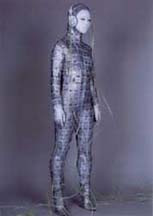
Yamaguchi Noriko is Under Our Skin
Emerging Japanese artist Yamaguchi Noriko gets under our skin thanks to what covers hers. Currently in her last year of an MFA program at the Kyoto City University of the Arts, this 22-year-old artist from Kobe tackles issues as diverse as technology, mythology and feminism through bodily transformation and endurance. Yamaguchi uses her body to challenge present-day social mores by quite literally camouflaging herself with materials such as red azuki beans, golden thumbtacks and silvery cell phone keypads which become a constructed second skin that acts as a meaning-laden barrier against the world beyond. The art world in Japan has already recognized Yamaguchi as an up-and-coming talent: in 2004, she was selected by famed photographer Hosoe Eikoh as a recipient of the Panel of Judges Award at the 21st-Century Asia Design Competition award held by the Kyoto University of Art and Design and again by Morimura Yasumasa as a winner of a young artists’ competition hosted by the Osaka Contemporary Art Center.
Yamaguchi’s work is awash in sexual politics due to the extreme modifications she enacts during performances or in front of the camera. In Keitai Girl (2003), the artist dons a skin-tight body suit reminiscent of metallic fish scales that is carefully crafted from cell phone keypads. Her face painted in the traditional powdery white makeup of Butoh, Yamaguchi wears large headphones and is draped from head to toe with wires seemingly ripped from a telecommunications command center, setting her adrift and alone in the ether. The suit, thanks to its digital keypads, begs to be dialed, thus showing the vulnerable position of the artist within the grasp of any number of anonymous hands that might reach out and “touch someone.” In fact, certain guests are given the telephone number of her body suit and can dial her up from their own cell phones and engage Yamaguchi in conversation during her performances. Thanks to the widespread use of cell phones, or keitai, in Japan, Yamaguchi created this suit—a full-body prosthetic that turns her into a walking and talking cellular device—to investigate the future development of the human body and its interaction with technology.
In another series, “Ogurara Hime,” or “The Princess of Ogura” (2004), Yamaguchi covers portions of her body with red beans to visually recreate the Japanese myth of Princess Ogura who became a human garden whose body sprouted forth azuki beans. Yamaguchi uses this ancient Japanese tale as a metaphor in her visualization of the female body as a site of production on a multitude of levels. In one image, long cords of red beans sprout forth from Yamaguchi’s head and attempt to take root in the ground just below her recumbent body. Her pale white flesh and exposed breasts become fertile ground that gives rise to crops and, perhaps more likely, to male desire and sexual objectification.
With her sexually charged examinations of the human body and its potential transmutations at the hands of technology and society, Yamaguchi Noriko’s skin trade is bound to remain on the Japanese art market for some time to come.
- Eric Shiner
Via Asia Pacific Magazine. [via reBlog]
Posted by jo at 08:04 AM | Comments (0)
Justine Cassell
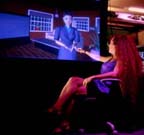
Embodied Conversational Agents
"What is an Embodied Conversational Agent? It is a lifesize virtual human capable of carrying on conversations with humans by both understanding and producing speech, hand gesture and facial expressions. Embodied Conversational Agents are a type of multimodal interface where the modalities are the natural modalities of human conversation: speech, facial displays, hand gestures, body stance. They are a type of software agent insofar as they exist to do the bidding of their human users, or to represent their human users in a computational environment. They are a type of dialogue system where both verbal and non-verbal devices advance and regulate the dialogue between the user and the computer. In the Embodied Conversational Agent, the visual dimension of interacting with a cartoon character on a screen (rather than a keyboard) is intrinsic to its function. The graphics are not just pretty pictures, but visual displays of conversation, in the same way that the face and hands serve that function in face-to-face conversation among humans..."
Posted by jo at 07:58 AM | Comments (0)
February 21, 2006
Ana Viseu’s Sociotechnical Worlds:

The Visions and Realities of Bodynets
Imagine two cities separated by a river and connected only by boat. Now think of the changes that are brought about by the construction of a bridge; Transformations will be experienced in both cities. These transformations will, to a great extent, be caused simply by the appearance of the new artefact (bridge). But, the properties of the artefact will also influence the character of the changes. There is, for example, a great difference between a small wooden bridge that can only carry pedestrians and bicycles, and a steel bridge that is equipped for cars, trucks and trains, but not for pedestrians. The characteristics of the bridge will affect the two cities it connects. The contrary is also true, that is, the characteristics of the cities will affect the shape and use of the bridge. Before the actual building of the bridge, studies were done (hopefully) and, assumptions were made (certainly), regarding the characteristics and needs of the cities on both sides of the river.
What we see here is an example of mutual-shaping interaction. Much in the same way that the social (the two cities) is shaped by the technical (the bridge), the bridge is shaped by the cities it connects. This is true both of the processes of development and implementation of the technical artefact (the bridge).
However, it is also true that the identity of the elements/actors is not infinitely fluid or malleable. Technological artefacts have characteristics that need to be taken into account in this mutual shaping relationship. For instance, a bridge that is made for pedestrians may be used by bicycles, perhaps even cars, but certainly not by trains.
This same metaphor applies to bodynets. Bodynets are bodies networked for (potentially) continuous communication with the environment (humans or computers) through at least one wearable device—a body-worn computer that is always on, always ready and always accessible. Bodynets can be thought of as new bridges between individuals and the environment (constituted by humans & nonhumans, or things and non-things). As they (re)connect and mediate, they transform (and are transformed by) all elements involved in this interaction. Hence, these technological artefacts are not merely tools to be used, but active shapers of experience. A bodynet can be used, for instance, as a "reality mediator" (Mann 2001), that is, it can alter, by enhancing or diminishing, one’s perception of the world. Steve Mann’s Eyetap is perhaps the best example of this. The Eyetap transforms the eye into a camera and a screen where reality is projected. When the eye looks reality is recorded and then projected onto the eye itself. This allows all sorts of manipulations, for instance, it is possible to do retroactive recording!
Bodynets, these new bridges, also contain assumptions about that which they connect, and these assumptions affect their shape, the nature of their mediation, and the behaviors they enhance. Thus, these bodynets are not neutral or ‘transparent’ technological artefacts. In fact, all technologies have biases. In 1951 Harold Innis, in a ground-breaking book The Bias of Communication, argued that while stone (communication through stone) is biased towards space (it can not be easily transported), papyrus is biased towards time. Nowadays, it is frequently said that television is biased towards fragmentation and sound bites. What are the biases of bodynets?
The metaphor of bodynets as ‘bridges’ spells out the broader theoretical foundations of this study. It stresses the networked character of a (socio)technological project, and emphasizes the bi-directional influence that actors’ actions have. Finally, it also stresses the point that technologies are socially constructed and reflect the society that produces them; And that society, on the other hand, is shaped by its tools and cannot be understood without them (cf. Latour 1993; Castells 1996; Callon & Law 1997; Bijker 1995).
All technologies are sociotechnologies, they are constituted by technical and social elements, i.e., not only are they materializations of a given view of society and behavior, they also enhance or constrain social dynamics. A bodynet that is equipped only with a transmitter allows its user to transmit data, but not receive it. If this transmitter is controlled by a third party, then the user has no control over the data flow. If the bodynet is equipped with a transceiver and is controlled by the user, then the user is able to control every piece of information that enters, and leaves, his/her personal space. In a sense we can say that the way a certain technology is, that is, its present shape, shows us the result of the struggle between different actors (Latour 1991). [...]
[via nicolas on pasta and vinegar]
Posted by jo at 12:04 PM | Comments (0)
aperture

New Channel for Communication
Aperture is a facade installation with interactive and narrative displaying modes. Consisting of an iris diaphragm matrix, the facade's surface with its apertures' variable opening diameters is enriched by a dynamic translucency, that creates new imagery as well as a new channel for communication between inside and outside.
Working on the topic "intelligent surface/sensitive skin" for the Digital Media Class at the University of the Arts Berlin, concept and prototype were conceived by Frédéric Eyl and Gunnar Green. Support by Professor Joachim Sauter and Jussi Ängeslevä [via CULTURETV]
Posted by jo at 11:59 AM | Comments (0)
Warren Sack

Aesthetics of Information Visualization
"Beyond the technically challenging questions of how data can be mapped are the questions of why one should map the textual or numerical into the visual. By asking why, this chapter provides an art historical and philosophical context for understanding information visualization projects undertaken as artistic research. Specifically, the question to be addressed concerns the formulation of an aesthetics of information visualization: What is the critical, artistic value of works in information visualization? Aesthetics, as a field of inquiry, examines issues of sensation and perception and seeks to understand why something is – or why some group of people finds something to be -- emotionally, sensually moving. What is beautiful, ugly, awe-inspiring, emotionally overwhelming, scary or comforting? (For a contemporary overview of the field of aesthetics, see Michael Kelly (editor), Encyclopedia of Aesthetics, 1998.) So, to inquire about the aesthetics of information visualization is to investigate the judgment used to decide what about the work is valuable, according to the senses or, in general, the body..." From Aesthetics of Information Visualization by Warren Sack. [via Rhizome]
Posted by jo at 11:50 AM | Comments (0)
Emerson College

New Media Showcase with the New Media Caucus of CAA
b>Date and time: Thursday, February 23rd 3 to 5 p.m. Featured artists: Roberto Bocci, Margot Lovejoy, Maurice Methot, Gwyan Rhabyt, Jack Toolin (C5); Co-presented by: The Department of Visual and Media Arts, School of the Arts, Institute for Liberal Arts and Interdisciplinary Studies of Emerson College and New Media Caucus, College Art Association
Location: Little Building, Emerson Room, 2nd floor, 80 Boylston Street, Boston, MA. Directions from the Hynes Convention Center: Take the Green Line subway("T") from Hynes/ICA station to 3rd stop (past Copley and Arlington), the Boylston station. The Little Building is across the street.
Posted by jo at 11:30 AM | Comments (0)
Surreal Scania

Exploring Imaginary Geographies
Surreal Scania is a web-based art project from Sweden that combines digital video with GPS-tech. What makes places attractive? Can a wet and dirty road running through a barren field be appealing? What are the common denominators between a heavy industrial harbour and a nature reserve? In the project Surreal Scania these questions are examined. Digital video is combined with GPS-technology to explore different visual representation techniques. At the same time processes of place marketing and branding are surrealized...
Exploring Imaginary Geographies: How do different places become interesting? Can a wet and dirty road running through a barren field be appealing? What are the common denominators between a heavy industrial harbour and a nature reserve? In the project Surreal Scania we examine these questions.
Digital technology, in form of video equipment and GPS-units has been used to look into how aura and attraction are connected to different places. Filmmaker Anders Weberg and cultural analysist Robert Willim started by visiting various points within a specific region. This time the region was Scania, located in southern Sweden. On the different locations video material has been collected, which was then used as the raw material for a number of short films. These films are now available for download. At the moment we provide six different films, but more will be added to the collection in the future.
The films can be seen as comments to process of place marketing and branding. In choosing the places, the aim has been to mix both geographical locations that are seen as tourist attractions and locations off the beaten track. In the digital manipulations, made by Anders Weberg, the visual raw material is transformed to highlight a dreamlike and surreal imaginary geography. All films are based solely on sound and video from the different geographical points.
All the films are accompanied with files containing the exact geographical coordinates for all the different places. By using Google Earth it is possible to view aerial photos of the points represented in the different films. Using a GPS-unit it is also possible to visit the locations where the visual raw material was shot. And as the films are provided in various file formats optimized for most mobile video players, it is possible to enjoy the filmic representations on the very spots where the material was filmed. In this way the imaginary can be compared to the real. But what is real or imaginary? With Surreal Scania we want to explore different visual representation techniques, and we also want to recognise the fact that our imagination has an important role in forming the experiences of these locations.
Anders Weberg.
A seasoned film maker, he has specialized in the expressions that digital technologies provide. He directs movies from features to experimental shorts to music videos. The purpose of Anders´work is to mix genres and ways of expression to explore the potential of visual media.
More info about Anders: http://www.recycled.se/
Robert Willim
Researcher in ethnology at Lund University. He has done research about the cultural dimensions of digital media and the transformations of industrial society. For the past several years he has channeled his research within this field to focus mainly on music and the arts.
More info about Robert: http://www.robertwillim.com/
[posted on random]
Posted by jo at 11:15 AM | Comments (0)
Why Pigeons that Blog Matter, or:
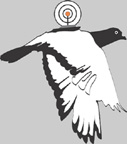
The Internet of Things is not an Internet of Arphids
"Abstract: The Internet of Things has evolved into a nascent conceptual framework for understanding how physical objects, once networked and imbued with informatic capabilities, will occupy space and occupy themselves in a world in which things were once quite passive. This paper describes the Internet of Things as more than a world of RFID tags and networked sensors.
Once "Things" are connected to the Internet, they can only but become enrolled as active, worldly participants by knitting together, facilitating and contributing to networks of social exchange and discourse, and rearranging the rules of occupancy and patterns of mobility within the physical world. “Things” in the pervasive Internet, will become first-class citizens with which we will interact and communicate. Things will have to be taken into account as they assume the role of socially relevant actors and strong-willed agents that create social capital and reconfigure the ways in which we live within and move about physical space.
To distinguish the instrumental character of “things” connected to the Internet from “things” participating within the Internet of social networks, I use the neologism “Blogject” — ‘objects that blog.’"
trackbacks:
Bruce Sterling. Shaping things. MIT Press, Cambridge, Mass., 2005.
Donna J. Haraway. The companion species manifesto: dogs, people, and significant otherness. Prickly Paradigm, University Presses Marketing, Chicago, Ill., 2003.
Bruno Latour. We have never been modern. Harvard University Press, Cambridge, Mass., 1993.
tag cloud:
spimes, spime, things, thing, lift06, ubiquitous computing, design, object, objects, species evolution, rfid, arphid, arphids, pervasive networks, blogject workshop, near-field communication, nfc
Technorati Tags: blogjects, spimes, rfid
[blogged by Julian Bleecker on Research Techkwondo]
February 27, 2006: Paper now available.
Posted by jo at 11:06 AM | Comments (0)
Aspect Magazine:

Thematics on Location, by Ignacio Nieto
If you’re looking for spaces where new media artists and curators can feature and promote their work in a proper format for this type of investigation, Aspect Magazine is a good alternative.
Produced in DVD format, each Aspect Magazine issue proposes thematics based on selections of projects made by curators and art critics. Its recent issue focuses on Location, checking different productive contemporary strategies, developed by collectives and artists. That’s how, for example, the work of Kenseth Amsted embraces the invisible space with a video made in Ghana, where cultural media of the west would never register. The C5 collective re-invents mountains by the measure of its geographic accidents, with a GPS system, and computer software. Richard Clar extends the space view with which we become acquainted, and works in the space around the earth and the garbage that surrounds it. Shelley Eshkar and Paul Kaiser build virtual urban spaces where there is an undetermined number of people doing different things, and where the spectator owns an omnipresent view.
Pete Gomes makes diverse tracks with chalk over a bridge, fixing points and naming them according to their coordinates, revealing the new control systems. MTAA realizes a performance that simulates running on real time online, but actually they’re only clips accessed by a program. Finally, Douglas Whetersby works in the gallery space in an intervention which re-orders the space and the objects that determines it, asking for a cover-price.
For more information:
http://www.aspectmag.com
Assistant Editor:
Liz Nofziger
lnofziger[at]aspectmag.com
[posted on newmediaFIX]
Posted by jo at 10:59 AM | Comments (0)
Giselle Beiguelman
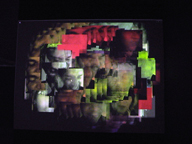
Sometimes Always/Sometimes Never
Sometimes Always/Sometimes Never are a set of two wireless interactive installations by Brazillian artist Giselle Beiguelman, presented at Life Goes Mobile, São Paulo, 2005 (Sometimes Always) and Festival Internacional de Linguagem Eletrônica, São Paulo, 2005 (Sometimes Never).
Sometimes Always discusses the visual horizons of nomadic culture and its entropic and saturated environments. Its point of departure is that nowadays life is seen through windows and screens and each moment seems a movie frame that consumes and erases itself as soon as it is processed. The project consists of an interactive projection, based on generative systems, which allow the audience to shot images with cell phones with video cameras and send them via Bluetooth to big screens. On mouse over, the videos fragments in frames can be reorganized by the interactors, following the movements and draws they do with the mouse. When they interrupt the action, the videos restart without erasing the mosaic of images that was built by their activities on the screen. An intriguing image of difference and repletion emerges there. Always.
Sometimes Never is a (de)generative video which is decomposed through the inputs of its interactors. Videographic images, shot with mobile phones in the exhibition space, can be manipulated by keyboards and mouse and the audience edits, in real time, the order of its original frames, their position on the screen as well as introduce colored filters on the new images. When someone leaves the mouse, the original film restarts over the layers built by the interactors. The result is an imagetic and dynamic palimpsest, that consumes itself following and entropic logic where saturation produces erasing and fluid memories. The project dialogues with the series Sometimes Always, where the audience also shots images with mobile phones to be deconstructed by the same algorithmic process used here. In spite of their methodological and technical equivalences, Sometimes Always and Sometimes Never, are very different in their results and cognitive processes. In Sometimes Never the manipulation of images do not produce an entropic mosaic, but instable saturated palimpsests where it is impossible to repeat an action. Never.
(project descriptions by Giselle Beiguelman)
Giselle Beiguelman
Sometimes Always, 2005
Sometimes Never, 2005
Posted by luis at 09:40 AM | Comments (0)
The Upgrade! Lisbon
![]()
February meeting featuring André Sier
Lisboa 20 Arte Contemporânea welcomes next Thursday, February 23rd @19:30, The Upgrade! Lisbon monthly gathering featuring André Sier who will present struct_0, struct_1, struct_2, struct_3, a series of audiovisual projects dealing with concepts of space and time.
André Sier was born in Lisbon in 1977. Holds a degree in Philosophy by FCSH in 2005, having studied three years Painting and Sculpture in Ar.Co, two Biochemistry in FCUL, one Music at AAM, and brief transgressions on performing arts. He is an audio-visual artist-programmer. Has been producing objects that installs in exhibiting spaces since 1997. The objects seek to unravel connections between sound and image, operating them. They began as speakers and light projectors; nowadays they run supported by the latest versions of trillions of code lines compiled by millions of programmers in machines scattered all over the world. Highlights the series Struct, 747, c. ( ), Ankh.
His works have been exhibited at Meiac in Badajoz, at Biennale Vila Nova de Cerveira, at festivals Música Viva, Hertzoscópio, Escrita na Paisagem, Arco art fair at Madrid, Sketch Gallery. Collaborates with various artists from music, plastic and performing arts, almost always with specific audio-visual creations, highlighting cooperation in the project Parque led by Ricardo Jacinto(2005-), UR with Nuno Morão(2003-), Noite directed by Amélia Bentes(2003-), the series To a World Free From... with the composer Pedro M. Rocha(2003-), Soror with Ana Mira and Sofia Borges, and various collaborations in concerts with artists like Ernesto Rodrigues, António Chaparreiro, Vitor Joaquim, Ivan Franco, among others. Participates in the META.morfosis exhibition held in Meiac since 27th jan 2006, and works on collaborations with Pedro Carneiro and Teresa Simas, Sofia Borges, Sam Abercromby.
For further information or project submission please email Luis Silva
Posted by luis at 09:26 AM | Comments (0)
February 18, 2006
New Gothic + Rattus Norvegicus
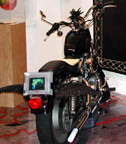
Magical Lock-down Dark Pegasus
Martin Sexton presents New Gothic which combines music and performance and features Truth Machine's 'Heraldic Unicorn Lion Grace System', described variously as 'the high-concept band to end all high-concept bands' and as a cult religious group by others. The varying members of this arts collective reportedly all work to a set of instructions cut from the text of books that vary from hermetic works, theological mediations to pulp fiction, erotica and maps. Steve Severin conducts and provides the sonic soundscape.
Ride up with the Magical Lock-down Dark Pegasus: a Harley-Davidson XL53 custom motorcycle resplendent with blue-black Scottish crow wings and 'pimped' with a DVD monitor as tail-plate, that echoes TE Lawrence's quote that ‘A motorcycle with a touch of blood in it is better than all the riding animals on earth, because of its logical extension of our faculties, and the hint, the provocations, to excess’.
Meanwhile, HMC create new visual experiences, as they unleash chthonic forces with their technological multimedia film noir Rattus Norvegicus as part of New Gothic at Tate Britain.
This fantastic, free, HMC MediaLab event will be: Friday, March 3, 2006 at 18.00 - 22.00pm; Tate Britain, Millbank, London, England SW1P 4RG.
Rattus Norvegicus is a dark digital artwork shown for the first time at "Late at Tate Britain" as part of the "Gothic Nightmares" exhibition.
HMC MediaLab is a cutting edge play-group for digital-art professionals.
HMC MediaLab exists to build a functional culture of innovation.
The HMC MediaLab encourages experimentation between the arts, science and technology disciplines. HMC MediaLab believes that interesting people do interesting things. The HMC MediaLab was formed in 2005 as a creative outlet for digital arts professionals. If you are a digital artist, or if you do something "interesting" and would like to get involved, please contact us at mail@hmcmedialab.org . We showcase, develop and build cutting edge projects that blur the lines between art and science.
To find out more about some of our projects click here.
If you are developing digital art, we want to know about it. Please get in touch with us.
To be invited to future events, simply sign up for our free e-mail newsletter here.
Posted by jo at 11:47 AM | Comments (0)
CYBERSALON & THE DIGITAL RESEARCH UNIT @ THE DANA CENTRE
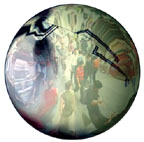
CREATIVE SOFTWARE
Cybersalon & The Digital Research Unit @ The Dana Centre present CREATIVE SOFTWARE--Thursday, 23rd March 2006, 1-10pm at The Science Museum's Dana Centre, 165 Queen's Gate, South Kensington, London SW7 5HE; Cost: Free. Email [booking[at]cybersalon.org] for details. Nearest tubes: South Kensington/Gloucester Road.
The signature and aesthetics of artists who write their own source code manifest themselves both in the code itself and in its visual results. Christiane Paul, Digital Art, (2003)
Creative Software is a one-day event featuring workshops, artist talks, an exhibition of selected works and an evening panel discussion involving leading practitioners, academics and curators in the field. The programme will investigate the relationship between art and technology and explore the history, context and approaches of artists who write their own software and/or author their own code to produce creative outputs.
Creative software is a rich, but hitherto marginalised area of art practice. Yet few areas of artistic endeavour better demonstrate the merging of art and technology and the blurring of the roles of artist and developer.
Panelists and presenters include: Ed Burton - Research & Development Director, Soda; Tom Corby - researcher/artist, reconnoitre.net; Charlie Gere - Director of Research, Institute for Cultural Research, Lancaster University, Tom Holley - Creative Director, The Media Centre, Huddersfield; Alex McClean - programmer/musician/artist, state51/Slub/toplap; Hannah Redler - Head of Arts Programme, Science Museum; Andrew Shoben - artist, Greyworld; Alexei Shulgin - artist/curator, runme.org; and Stanza - artist/curator, Soundtoys.net.
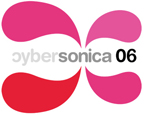
Cybersalon and the Digital Research Unit (DRU), Hudderfield are collaborating to help realise the hidden potential of the area by proposing the founding a Creative Software Forum. We envisage that this network will: operate as a crucial research and advocacy group; work proactively to source and engage with creative software showcases, curators and commissioners, established and emerging creative software artists/artist groups and their work; assemble event programmes that are diverse, accessible, exciting and contemporary; and ensure the strategic development of these events are informed by expertise in the field.
The Creative Software event is part of a process of public dialogue as a precursor to submitting a funding proposal to found the Creative Software Forum. We hope to draw together a community of practitioners, artists, academics, students, theorists, other curators and an interested general public to discuss, scope and explore the potential and remit of a forum that could champion and advocate for this work in an ongoing way. It's an open call to all interested parties to express their interest and to contribute to the discussion.
Please contact Lewis Sykes, Cybersalon Coordinator [lewis[at]cybersalon.org] if you are interested in contributing to Creative Software.
A full outline of activities and contributors will be listed shortly.
Cybersalon gratefully acknowledges funding support from the Science Museum's Dana Centre.
Posted by jo at 11:44 AM | Comments (0)
BREAKING THE GAME - ONLINE SYMPOSIUM
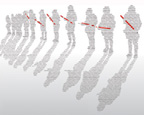
Competing Theorists and Practitioners Debate and Reflect
From March 15 - 25, 2006 Workspace Unlimited presents Breaking the Game Symposium, a first-iteration online event that brings together competing theorists and practitioners to debate and reflect on virtual worlds, computer gaming, immersive technologies, and new possibilities for artistic practice and experience. The symposium will open up the art of game modification to the contingencies of everyday life, where interactive technologies increasingly mediate physical spaces and human movements in very complex and dynamic ways. The symposium themes are: Hybridity, Overclocking the City and The Virtual as Interface to Self and Society.
Participants will consider gaming and other virtual technologies in relationship to building and designing cities, navigating and experiencing urban life, constructing identities, and creating and maintaining social interaction. The symposium encourages debate and discussion through multiple formats including text, video interviews, phone blogging, images, animation, and virtual walkthroughs.
We want the symposium to function as a workspace for testing out ideas, developing new tools, sharing creative processes and works in progress. Breaking the Game is a prototype for how we'd like to initiate and develop real projects around a specific focus, connect our own working process to the ideas and practice of others, and create networks that facilitate and feed into further collaborative opportunities.
For detailed information about the symposium please visit the Breaking the game website.
Breaking the Game symposium has three themes:
Hybridity considers new forms of art being produced within the increasingly hybrid environment of digital and physical space, in response to the multiplication of delivery systems and formats, and to the changing roles of artists, scientists, and technologists. We will discuss whether or not, and under what conditions, these hybrid contexts are effecting how artists produce, with whom they collaborate, and with what results. How are we consuming art differently and integrating it into our lives in new ways? Finally we will explore a variety of hybrid experiments artists are undertaking within the now established field of video gaming and multiuser virtual environments.
Overclocking the City proposes that we look more critically at gaming technologies and culture as storehouses of tools for designing new perceptual experiences and social interaction within the built environment. Participants will debate what constitutes public space in an electronically networked virtual world, and what forms this space might take. We will consider how virtual worlds, which for the most part, have been designed as autonomous environments, might have a functioning relationship with actual places, buildings, and people in physical locations.
The Virtual as Interface to Self and Society explores how the technologies of sensing, computation, and display are increasingly becoming important to how we connect to society and simultaneously engage in acts of self-reflection and self-fashioning. Virtual worlds, and particularly networked pervasive 3D environments, are useful contexts for critically and imaginatively exploring how we project our so-called self into computerized space, reconstruct it in digital form, and set about interacting with other reconstructed selves. In combination with "computer software programs, rules, commands, and networked interactivity" we perform a sense of presence to others by effectively manipulating "graphical, textual, navigational, and audio modes that are coded to correspond with our bodily senses" (Bolter). How is this self-presence achieved, to what ends, and with what effects? Participants in this session will explore an online multiuser environment together that will inform the basis for debate and discussion.
Workspace Unlimited website: www.workspace-unlimited.org
Thomas Soetens, artist, Workspace Unlimited
Kora Van den Bulcke, architect, Workspace Unlimited
Wayne Ashley, Independent Curator, New York
Posted by jo at 11:39 AM | Comments (0)
The Fibreculture Journal, Issue 7
![]()
Distributed Aesthetics
Distributed Aesthetics edited by Lisa Gye, Anna Munster and Ingrid Richardson--Abstracts: ...and Beyond: Anticipating Distributed Aesthetics by Darren Tofts; Theses on Distributed Aesthetics. Or, What a Network is Not by Anna Munster & Geert Lovink; Sharing Styles: New Media, Creative Communities and the Evidence of an Open Source Design Movement by Greg Turner-Rahman; Excerpts From ‘Portrait Of The VJ’ by Mark Amerika; Multiple Perspectives/Multiple Readings by Simon Biggs; Beyond the Museum Walls: Situating Art in Virtual Space (Polemic Overlay and Three Movements) by Vince Dzekian; Reshaping Spectatorship: Immersive and Distributed Aesthetics by Edwina Bartlem; Entropy And Digital Installation by Susan Ballard; Intimate Transactions: The Evolution of an Ecosophical Networked Practice by Keith Armstrong.
Finding new terminology for emerging art and cultural practices or for media and technological constellations is bound to be contentious. On lists, blogs and during face-to-face forums and conferences we continue to debate what the term new media entails, let alone whether this provides an umbrella for wearable computing, smart materials, mobile phone movies or bioart. It is clear that computational culture is drifting, fragmenting and laterally expanding: terminals are no longer dedicated; cultural producers are now recurrent and mobile multi-taskers; art is online, on the street, on a screen and coming at you from a million different places, now.
Rather than try to define the terminology or taxonomy of distributed art theories and practices we have proposed instead a descriptor for the ‘aesthesia’ of contemporary networked encounters. Distributed aesthetics, then, concerns experiences that are sensed, lived and produced in more than one place and time. This might equally be a sketch of reconsiderations of the operations of cultural memory or of phenomena such as endurance performances. But what we propose, through gathering together the disparate pieces in this fibreculture journal issue, is that techno-social networks are crucially constitutive of this distributed aesthesia. In various ways, all the texts here take up the mode through which ‘the network’ – the juncture and disjunction of here and there, you and I, social and individuated – functions as the crucial operand in dispersing and contouring perception, art practice and aesthetics.
It would be unwise, however, to assign distributed aesthetics the role of the ‘new’ new media. As Darren Tofts cogently demonstrates in his analysis of the burgeoning Australian media arts scene of the late 1970s and 1980s, certain network formations pre-date the current raft of theorisation. By re-visiting work from the 1980s by artists such as Philip Brophy and the band Tsk-Tsk-Tsk, which included street stencil art, live performances, video events and gallery shows, Tofts invites us to unpack media art as a temporally staggered and distributed event. The importance of drawing our attention to these pre-figurations of networked aesthetics lies in both highlighting the rich and remediated history of media arts and in sobering the frenzy around the fad for relational aesthetics doing the global rounds of art galleries and conferences. Like the Flash mobbing that arises form current distributed media, these earlier media art events depended upon a participatory audience prepared to facilitate information about the works’ distributed times and places. Geert Lovink and Anna Munster, on the other hand, discern a particular aesthetic dominating contemporary imaginings of the network, which they title ‘the will to network mapping’. In a series of speculative propositions that seek to move towards a social rather than formal aesthetics, Lovink and Munster prise this image of the network as an ever-growing euphoric entity to be charted via links and nodes away from biologistic and organisational metaphors. Instead, they suggest, networks are human constructions and their ‘aesthesia’ must come to terms with all too human experiences of frustration, boredom and labour that comprise life lived in and with distributed media.
From an altogether different perspective, Greg Turner-Rahman empirically explores the practices of resource, knowledge and skill sharing among online design communities that amount to a literal distribution of aesthetics. He offers us a different version of design practice, which is often only considered from the point of view of its corporate environment where the one-way transmission of brief from client to designer holds sway. Instead, Turner-Rahman compares an imaginative if more marginal set of designers who are operating in ‘open-source’ mode. Yet this is not an essay that is simply celebratory of the ‘network way’ again. We are invited to think through the felt tension of changes in design culture as it attempts to straddle both entrenched corporate and emerging online modes of production.
One of the most satisfying aspects of working on this issue of the fibreculture journal has been the response we have received from artists to the meshwork of issues covered by distributed media, art and practice. Satisfying because these responses tend to experiment with how to do distribution rather than worrying about the finer details of what it should comprise. In the extracts from ‘Portrait of the VJ’, Mark Amerika splices the cut and paste rhythms of computerised text with the slide and sampling of distributed audiovisual performance that characterise the art of VJjing. The VJ is a provocateur whose improvisational and hybridised practice recombines traditional art forms such as film with experimental writing, electronica and video, software and net art. In his own VJ art Amerika explores and performs the complex agency of images and sounds, often on-the-fly and comprised from a palimpsest of memories, perceptions, experimental digital effects, and geophysical and virtual networks. Such ‘visual hypertextuality’ is also a feature of Simon Biggs’ distributed and shared environments. In Babel, Biggs confounds the conventional geometry of vision – typically represented by an inverted triangle where the apex equates to the singular eye of the Cartesian subject – by creating a multi-user remote networking system so that what we see simultaneously includes the multiple perspectives of other viewers at dispersed physical and online locations. The installation Parallax also challenges the supposedly homologous relation between vision and self by creating a collective and interactive visual experience, effectively interspersing the behaviour of virtual objects in the screen with the multiple movements of inter-actors within the installation space. Keith Armstrong’s Intimate Transactions provides us with another practice-led contribution to research on the felt disjunction of networks/artworks. Armstrong’s essay is valuable in that it demonstrates that aesthetically working through the design of embodies and networked interfaces can also produce a theoretical and practical framework for artists. He names this ‘ecosophical’ – a thinking through of artist, interface, participant and artwork as a mutable ecology that produces change and difference for all nodes and interrelations.
If artists are busy distributing the event and object that we might once have called an art work, how are audiences and institutions reacting to and even re-constituting themselves as part of net-art-works? Although we may have heard quite a lot about the ubiquity of audience and the disappearance of the gallery with respect to online art, nevertheless exhibitions, installations and institutions stubbornly remain in all their localisation. Yet as Vince Dzekian points out, art galleries are increasingly both virtualised (their Web presence often producing entirely different aesthetic and cultural modes of engagement) and their infrastructure digitised. What, then, does this mean for the site-specificity of such institutions? Rather than take an online gallery as exemplary of such forces of distribution, Dzekian gives us a detailed polemic that brings distributed aesthetics into contact with the National Gallery of Victoria. Here we get a sense of the ways in which an institution wrestles with the experience of being dispersed between informatic and physical space and how its curatorial practices might negotiate this tension.
Of course as denizens of new media art we are already familiar with the splitting and conjoining of ‘the virtual’ and ‘the physical’ through analysis of virtual reality art work throughout the 1990s. In her article ‘Reshaping Spectatorship: Immersive and Distributed Aesthetics’ Edwina Bartlem challenges the notion that immersive VR or VE art and distributed or networked art are of a different experiential or perceptual order. Both immersive and distributed aesthetics, she argues, provide the conditions for a mediated yet fully engaging telepresence, which can effectively shift our understanding of art spectatorship from passive to performative mode and transform how we interpret and experience community, the human-technology relation and our own corporeality and consciousness. Susan Ballard is also concerned with a thorn in the side of new media theory, albeit a somewhat older one – entropy. Resonating with a problem that is of concern for other authors in this issue – namely, the transmission model of distributing signal – Ballard argues that entropy is not the downside to information being pushed around a space. Rather than the decay of signal, art that harnesses the material forces of leakage and dispersal might actually constitute a kind of networked experience. In examining the ways in which participants, computers, installed spaces and networks inhabit some recent art exhibited in New Zealand, Ballard suggests that fragmentation assists the pieces to materialize in their exhibition space.
What is insightful about the particularity of these analyses from Dzekian, Bartlem, Ballard and Armstrong is that they dig for frayed and uncharted elements of networked media, art and culture instead of lauding the technical as a necessary ‘connector’ of experience. Overall – and as is fitting for this issue’s theme – there seems to be no formal system, no set of objects and no one technology that can serve to ground a distributed aesthetics. But there are certainly enough shifts and cracks occurring to suggest that however we inhabit and imagine networks this habitat and this imaginary have by now thoroughly permeated and reshaped contemporary experience.
The editors would like to thank the many anonymous referees who helped with their insightful comments in their reports and for their time. In addition we would like to thank the authors for their patience in putting this issue together. Thanks also to Andrew Murphie for his skill and patience as executive editor.
Lisa Gye
Anna Munster
Ingrid Richardson
December 2005
Posted by jo at 11:28 AM | Comments (0)
Perform.Media
![]()
A Transdisciplinary Festival of Creativity, Research, Theory and Technoculture
Perform.Media is an international media arts festival and symposium creating an innovative venue for creative and intellectual work around the momentary process and performance in new media art and culture. We begin with the premise that newer media, along with modes of representation and narrative, embody momentary processes from roots in cybernetics and the biological, to the embodied performance of interface, improvised network exchanges and spontaneous social acts in multi-user synthetic worlds. Such mediated experiences and actions form meaning in sense experience and performance along with interpretive processes like depiction and reception. The dynamic, reciprocal process of the user(s) generating, configuring, interacting, choosing and authoring is an important component of new media and technologies, expressed in both the design of the media and in the momentary, improvised performance of the participant.
The festival and symposium seeks the accordance and collision of ideas through the lens of interdisciplinarity, exploring the performance of new media and the performative qualities of human-computer and technologically mediated social interaction. Perform.Media will examine sense experience and meaning at the threshold and in the performing action, along with the reflexive construction of narrative, where creative play, social practices, augmented embodiment and exploratory methods establish processes that spin out, overlapping locales of influence, in networked, "glocal", mobile, participatory, socially interactive, live processed, locative, responsive and multi-user realms.
Perform.Media aims to examine and melt the usual spatial and temporal prescriptions of author and spectator in art, creative work and intellectual practice. Perform.Media traverses transdisciplinary territories in collaborations and social feedbacks of live sound+image, interactive and game media, HCI, improvisations, performance processes, interactive gallery environments, mobile and locative work, live art works, net.art, research practices, theoretical discussion, paper presentations, workshops, intimacy and communication both online and off.
CALL FOR WORK AND PARTICIPATION
Art Work and Creative Practices * Papers Presentations, Panels, Workshops, Intellectual Environments and Practices
Perform.Media: A Transdisciplinary Festival of Creativity, Research, Theory and Technoculture; September 29th-October 14th, 2006, Indiana University, Bloomington, Indiana
DEADLINE FOR PAPER PRESENTATIONS: Abstracts: April 30th, 2006; Acceptance Notification: May 15th, 2006
DEADLINE FOR PANELS, WORKSHOPS, INTELLECTUAL ENVIRONMENTS AND PRACTICES: Proposals: April 30th, 2006; Acceptance Notification: May 15th, 2006
DEADLINE FOR ART WORK AND CREATIVE PRACTICES: May 15th, 2006; Acceptance Notification: June 15th, 2006
SUBMISSION GUIDELINES
Paper Presentations, Panels, Workshops, Intellectual Environments and Practices
The Perform.Media symposium welcomes submissions of papers, panel discussions, workshops and intellectual environments around the theme of the festival- performance process in new media, theory, research and technological practice. The Perform.Media symposium seeks to promote discussion and collaboration. The environment of the symposium will be conversation based. Proposals for panels, workshops and presentations that energize into new areas of intellectual exchange will be welcomed. All presentations will be moderated and encourage participation, questioning and debate. An online forum, discussion and net.art exhibition will precede the festival. Paper abstracts will be published on the Perforrm.Media website.
Art Work and Creative Practices
Work criteria-
Perform.Media seeks new media work and proposals for black box, white cube or network that engage in the practice of performing media or media performance. We are looking for work that asks the questions-
How does the ?doing,? the performing inform us in this new media?
How does this media perform, what does it do and how does it engage us?
Types of work-
Ambient/Ubiquitous Technologies and Creative Practices, Avatars, Dance/Embodied work, Environments and Space Based work, Games, HCI, Interactive/Participatory Installation, Interface Art, Live Art, Locative Media, Mapping, Mobile Screens, Mobile/Wireless Devices, Net.Art, New Media Performances, Simulations and Synthetic Worlds, Theatrical Pieces, Video Processing and VJ/DJ styles
For questions contact- abucksba[at]indiana.edu
Posted by jo at 11:24 AM | Comments (0)
Body as Personal Area Network

Chips that really get under your skin
"Researchers at the Korea Advanced Institute of Science and Technology (KAIST) presented a chip that is implanted in a user’s forearm to function as an audio signal transmission wire that links to an iPod. Many of the presentations featured devices that conserved power, though this chip goes a step further, harnessing the human body’s natural conductive properties to create personal-area networks. It is not practical to wire together the numerous devices that people carry with them, and Bluetooth connections fall prey to interference, leading scientists to explore the application of the human body as a networking cable. The Korean scientists augmented an iPod nano with their wideband signaling chip. When a user kept his finger pressed to the device, it transmitted data at 2 Mbps, at a consumption rate lower than 10 microwatts. Researchers from the University of Utah also presented a chip that scans brainwave activity by wirelessly streaming data through monitors in the hopes of creating prosthetics that quadriplegics could operate with their brain waves, though both projects are still in the preliminary research stages. (…) These chips are not something that will be included in one of Apple Computer CEO Steve Jobs’ Macworld keynotes anytime soon." ACM Technology News. See Chips that really get under your skin by Tom Krazit, CNET News.com (see Microsoft patents body power by Matt Loney, CNET News.com) [blogged by nicolas on pasta and vinegar]
Posted by jo at 10:34 AM | Comments (0)
Sonogrammar.2
![]()
Moments of Correspondence Determined by Chance
Sonogrammar.2--Wednesday, February 22, 2006 - 8pm, The Tank, 279 Church Street, NYC (Between Franklin and White).
Sonogrammar began as an organizing concept, a way of gathering certain artists working with media and performance in what we came to think of as a compositional mode. With this series we are interested in exploring the common languages of abstraction, expression, modulation, and control that are shared by many contemporary electronic and electro-acoustic composers, sound artists, film and video performers and installation artists.
Program: Shimpei Takeda, video: Particle and Andy Graydon, sound: Focal Plane; Richard Garet, video: IP - Iota Expansion and Bruce Tovsky, sound: Induction; Adam Kendall, video: Ultradian and Brendan Murray, sound: Ocean Of Dirt, Mountain Of Steam.
Tonight's focus is more intimate, as we invite composers in sound to present new original works alongside new work by image composers. Pairings were made based on perceived affinities in approach, or for potential interesting aesthetic contrast. Although the works are presented as duos, each sound work and video composition could be thought of as whole and distinct; in some cases the interplay between elements is intentional and intricate, in other cases the works are essentially performed in parallel, with moments of correspondence determined largely by chance.
The first edition of Sonogrammar, performed at 2005's Bushwick Art Projects Festival, focused directly on scored compositions for mixed media ensembles. These included live video scored compositions, audio scores guiding the work of image performers, as well as rules-based and text-centered compositions for both sound and image performers.
Posted by jo at 09:34 AM | Comments (0)
February 16, 2006
Leonardo
.gif)
Multimedia Performances
This month in LEA, guest editors Annette Barbier and Marla Schweppe look at multimedia performances through four refreshing and different essays that explore different aspects of the topic.
We begin with Joe Geigel's Virtual Theatre - One Step Beyond Machinima, which introduces a technical framework for defining and performing a theatrical work in a virtual space. As proof of concept for this framework, a real time, distributed improvisation is showcased.
In Cybernetic Performance Art; The Trouble with Blurring the Distinction Between Art and Life, Jason Van Anden and Lauri Goldkind look at developing technology to make artworks improvisationally simulate emotional behavior in real time and space, and discover how a boundary was crossed between the disciplines of static sculpture and live performance.
Following that, we embark on a Patchwork in motion: A practice-led project investigating the shifting relationships and processes associated with the performing body in interactive and non-interactive visual environments with Maria Adriana L. Verdaasdonk.
Finally, Paul Hertz deals with VR as a Performance for an Audience, which contemplates the possibility of creating VR performances in a traditional musical performance or theatrical situation, with an audience, as a hybrid or intermedia art form.
Amnon Wolman's desktop performance unfolds differently, in real time, each time it is played. It addresses not only our ever-varying sense of time, but also the intimate space of the desktop in creating a unique, individualized performance for every listener.
Accompanying the issue is a specially curated gallery. Jack Ox's networked performance proposes multiple points of entry as well as of reception. While creating a live, real-time event, she also incorporates static images, visualizations of musical sequences.
Benoit Maubrey incorporates sound and video "accompaniment" into the body of the moving performer. Christina Ray and Glowlab challenge our notion of performance by using cell phones to transmit the spectacle of everyday life observed. Bob Gluck invites viewers to enter into the use of ritual objects, which respond to and amplify their actions, making them participants in a dialog with the work.
Pedro Rebelo creates musical "prostheses" which extend the acoustic into the electronic realm. Bob Ostertag examines the relationships between our bodies, our society's detritus, and the machines that interpret our actions, our computers. The special issue is available at: http://mitpress2.mit.edu/e-journals/LEA/archive.html and the gallery:
http://mitpress2.mit.edu/e-journals/LEA/GALLERY/mmperf
Posted by jo at 04:51 PM | Comments (0)
Pneumatic Parliament
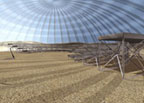
Instant Democracy
The icon that combines the western democracies and that self-legitimizes them in a millennial historical tradition is the parliament, the physical place where the people's designated representatives rule. This icon has also become the holy symbol of the western crusades against the so-called 'regimes'. These are forms of government, just located in economically strategic areas not by accident, that employ less linear elective systems. The Pneumatic Parliament project by Peter Sloterdijk and Gesa Mueller van der Haegen brings a sarcastic thrust to the pretended western democracies' supremacy, and to their claim of exporting their own model to other states. The work has been developed in the context of the 'instant democracy' project and it consists of a structure for parliamentary assemblies that can be air-dropped and that self-opens into almost the final form. After minimal corrections of positions it automatically becomes self-sufficient also for its own energy supplying. Perfectly placing itself in the psychological territory of the so much pushed 'fight the international terrorism' propaganda, the project narrates of fictional (but sadly plausible) institutions, that commissions to a single entity the building of the supporting infrastructure of their invasive politics. [via neural]
Posted by jo at 04:31 PM | Comments (0)
Russian Roulette
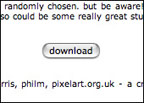
Download Gamble
The thrill of surprise that materializes in the opening of a gift / box is one of the most exploited images by the marketing professionals, also for its direct effectiveness. Sure enough the 'unknown' with pleasing premises build up a fund of expectations that sublimate in a climax, with easy-to-think-about sexual metaphors. These dynamics have their own corresponding electronic reference in the file's download that embodies many of its characteristics (the wait, the surprise, the gratifying instant). But the download has a crucial peculiarity: the distance (mostly unknown) from where the files are coming and the poor verifiability of their origin. The project Russian Roulette by Carlos Katastrofsky plays with this fascinating and fulfilling aura. It's a spartan mechanism: from a (unknowable) file archive the user get a random file clicking on the 'download' button. One one side it reminds online platforms like FileSwap, on the other side the bubble gum machines. And as it is in cheap thrills, the files' content is minimal or kitsch, but the downloading charm, that radiates from the act of receiving an unknown file after clicking on a generic button, is still unaltered. [from neural]
Posted by jo at 04:24 PM | Comments (0)
February 15, 2006
SVEN + The Surveillance Camera Players
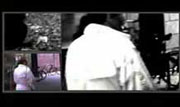
aka "AI to the People"
SVEN - Surveillance Video Entertainment Network, aka "AI to the People," is a real-time video performance system that takes a humorous but critical look at artificial intelligence surveillance algorithms by developing techniques that detect when people look like rock stars instead of criminals, terrorists, or other "undesirable passersby". The system consists of a camera, monitor, and two computers that can be set up wherever a CCTV monitor might be expected.
A custom computer vision application tracks pedestrians and detects their characteristics and a real-time video processing application uses this information to generate music-video like visuals from the camera feed. Once a pedestrian who looks like a rock star is detected, music video effects are triggered so the surveillance stars get a glamor treatment worthy of Cecil B himself. The resulting video and audio are displayed on a monitor in the public space, interrupting the standard security camera type display each time a likely rockstar is detected. SVEN is a work in progress but the basic elements are working. Videos on the project website. A work by Amy Alexander, together with Jesse Gilbert, Wojciech Kosma, Vincent Rabaud and Nikhil Rasiwasia.
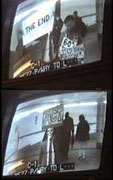
Can't resist the urge to mention The Surveillance Camera Players (SCP).
Formed in 1996, the New York-based group manifest their opposition to surveillance cameras in public places by performing silent, specially adapted plays directly in front of surveillance cameras. Their fist performace was Alfred Jarry’s Ubu Roi. Later performances include Orwell’s 1984 and Beckett’s Waiting for Godot. There are affiliate SCP groups in Tempe, Arizona and San Francisco (USA), Bologna (I), Stockholm (S) and in Lithuania (LT).
On 19-20 March 2006, the SCP will live an international day(s?) against video surveillance. [blogged by Regine on we-make-money-not-art]
Posted by jo at 09:16 AM | Comments (0)
Golan Levin with Kamal Nigam and Jonathan Feinberg
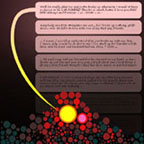
The Dumpster
The Dumpster, 2006, Golan Levin with Kamal Nigam and Jonathan Feinberg, artport, the Whitney Museum’s portal to Internet art: The Dumpster is an interactive online visualization that attempts to depict a slice through the romantic lives of American teenagers. Using real postings extracted from millions of online blogs, visitors to the project can surf through tens of thousands of specific romantic relationships in which one person has “dumped” another. The project’s graphical tools reveal the astonishing similarities, unique differences, and underlying patterns of these failed relationships, providing both peculiarly analytic and sympathetically intimate perspectives onto the diversity of global romantic pain. [See Social Data Browsing by Lev Manovich.]
“The Dumpster” is the first in a series of three works co-commissioned in collaboration with Tate Online. Critical texts and video interviews with the artists will accompany the works at http://www.tate.org.uk/netart/.
Upcoming commissions
Launch Date: March 1
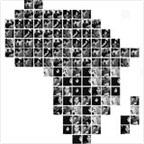
The Battle of Algiers by Marc Lafia and Fang-Yu Lin: This work recomposes scenes from the 1965 film The Battle of Algiers by Italian director Gillo Pontecorvo. The original film is a reenactment of the Algerian nationalist struggle leading to independence from France in 1962. The success of the actual battle for independence has been attributed to the nationalists‚ organization: a pyramidal structure of self-organized cells. For the Whitney’s artport, Lafia and Lin recomposed the film along a cell-based structure, in which French Authority and the Algerian Nationalist cells are represented by stills from the film and move according to different rule sets. When cells of different camps intersect, they trigger video cells displaying each side’s tactics (as depicted in the film) according to the rules of the system.
Launch Date: March 22
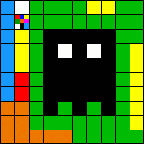
The Screening Circle by Andy Deck: This project adapts the cultural tradition of the quilting circle into an online format. Visitors to the site can enter the drawing area to compose loops of graphics and affect and edit each other‚s screens. The pieces can be made by one person or by several people and the arrangement of the segments can be haphazard or precise. In the screening area, the resulting motion graphics will be on view instantaneously.
[via newmediaFIX]
Posted by jo at 08:37 AM | Comments (0)
HTTP Gallery
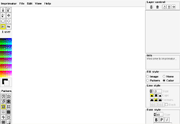
Invitation to Create and Exhibit Posters
You are invited to create posters through Andy Deck's Imprimatur http://turbulence.org/Works/imprimatur/. All posters created during February, March and April will be displayed at HTTP Gallery and the surrounding public spaces for the next exhibition, 'Open Vice Virtue: the online art context'. Also photographs of posters displayed in public locations will be documented on the HTTP website. So please download, print out and paste up archived posters in your own localities - send your photos to info[at]http.uk.net
"Imprimatur consists of an online 'groupware' for poster illustration and layout accessible through a computer workstation installed in the gallery space. Visitors can use the software to create their own poster in collaboration with their online counterparts. This piece provides a framework for visitors/ participants to launch a personal poster campaign based on their own social and political concerns. This DIY approach revives the tradition of poster-making as a medium of mass communication and persuasion developed during the 20th century. The posters will by displayed as part of the exhibition and will circulate freely beyond the gallery walls, appearing in surrounding streets, schools, libraries, kitchens and bedrooms."
Posted by jo at 08:03 AM | Comments (0)
Deptford.TV
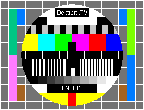
Annotate the Regeneration Processes in Deptford
During March, Deptford.TV will host 3 two-day long hands on database filmmaking workshops, in which we will establishe a public database of documentary film and video to help annotate the regeneration processes in Deptford and across SE London. Join us to remix Deptford comment and contention in a series of public screenings and talks at Deckspace, Goldsmiths and across boundless.coop network.
Review of material already in hand and the newly accumulated documentary evidence, interviews and accounts of experience. We invite you to take part in the three workshop weekends plus the walk and conference taking place at dek.spc.org, The Albany and Goldsmiths.
The workshops are free buth places are limited, to book, please send an email to info[at]deptford.tv and state workshop and/or event you want to attend.
Programme March 2006:
Workshop #1: TV hacking
at http://dek.spc.org, Borough Hall
Friday 3rd March, 11AM - 5PM
Saturday 4th March, 11AM - 5PM
Workshop #2: regeneration doc
at http://dek.spc.org, Borough Hall
Friday 10th March, 11AM - 5PM
Saturday 11th March, 11AM - 5PM
Workshop #3: database doc
at http://dek.spc.org, Borough Hall
Friday 17th March, 11AM - 5PM
Saturday 18th March, 11AM - 5PM
Deptford Walk
starting at the Albany Cafe
Friday 24th March, 11.30AM
Remix Conference
at Goldsmiths College, New Cross, small hall
Saturday 25th March, 10AM - 5PM
The events are free, but places are limited. to book please email info[at]deptford.tv
Further info: http://deptford.tv
Contact details:
adnan hadzi
phd media & communications
dept media and communications
goldsmiths college
university of london
new cross
london, se14 6nw
united kingdom
tel. +44 20 8816 8166
fax +44 20 7943 2772
(account# 7041207864438)
www.goldsmiths.ac.uk/departments/media-communications
www.filmcode.org
www.deptford.tv
www.liquidculture.cc
www.copyleft.org.uk
Posted by jo at 07:55 AM | Comments (0)
UpStage
![]()
Indigenous Maniacs
This week I'm teaching an UpStage workshop at the Computing Women's Congress at Waikato and have a small but highly talented group of students who have progressed so rapidly that we're going to give a little performance on Thursday, February 16 at 12.45pm New Zealand time entitled "Indigenous Maniacs". Check here or here for your local time.
To join the performance, simply go to http://upstage.org.nz:8081/stages/indidgenous">.
Helen Varley Jamieson: creative catalyst helen[at]creative-catalyst.com http://www.creative-catalyst.com http://www.avatarbodycollision.org
http://www.writerfind.com/hjamieson.htm
Posted by jo at 07:40 AM | Comments (0)
Videodances by Mimi Garrard

CREATING DANCE FOR VIDEO Streamed Online
A new short documentary, FORGING A NEW CAREER / CREATING DANCE FOR VIDEO, is featured on Mimi Garrard's web site this month.
The 42th half hour program of Videodances by Mimi Garrard will be shown in Manhattan Thursday February 23 at 9. p.m. and Sunday February 26 at 3 p.m. on Channel 56. The shows will be streamed live on the web and are accessible to people without cable or outside of Manhattan. Go to http://www.mnn.org/ and click on Channel 56 during the time and date of the program.
During the month of February Mimi Garrard has a dance installation at the Varga Gallery in Woodstock, New York.
Posted by jo at 07:34 AM | Comments (0)
Art Spaces Archives Project

Activist Arts Organizations of the 1970s and 1980s: Research Opportunities for Scholars
The Art Spaces Archives Project [AS-AP] is pleased to announce a panel discussion entitled Activist Arts Organizations of the 1970s and 1980s: Research Opportunities for Scholars, to be held at the College Art Association's 94th Annual Conference on February 23, 2006, from 5:30 to 7:00 PM in Boston at the Hynes Convention Center, Plaza Level, Room 112.
The panel will feature Linda Frye Burnham, Dr. Margo Machida, and Steven Englander. Moderating the panel will be David Platzker, the Project Director of AS-AP, a non-profit initiative founded in 2003 to assess and survey the state of the archives of art spaces throughout the United States.
The presenters will investigate the history of three formative organizations: High Performance Magazine, Godzilla: The Asian American Art Network, and ABC No Rio, and discuss what each of these organizations prompted, how they interacted within a community, how they co-existed, melded into, or changed a broader constituency. Additionally, the panel will discuss the role their archival materials play in telegraphing, or revealing, underlying historic information about these organizations and the state of these archives.
The goal of the panel is two fold: first to encourage emerging scholars to engage with the avant-garde / alternative organizations of the period, and secondly to highlight three selected organizations and to pair an emerging scholar with each. Ultimately, each scholar will conduct research using an organization's physical archival materials; perform oral histories with founders of the organization, and publish, on AS-AP's website, the conclusion of the research and oral histories.
In Spring 2006, AS-AP will invite proposals from emerging scholars to conduct the research with High Performance, Godzilla, and ABC No Rio. The three chosen individuals will conduct on-site work in 2007 with the edited oral history to be published by the close of that year.
AS-AP is using the panel as a template for emerging scholars to engage with the rich history of the avant-garde / alternative arts movement. Central to this investigation is the utilization of archival materials; the identification and preservation of which is fundamental to AS-AP's mission.
Linda Frye Burnham will reflect on the history of High Performance magazine (1978-1998) and the changes it tracked in the alternative arts movement during those years. High Performance followed the cutting edge from performance art through feminism, multiculturalism, activism and community-based art. High Performance was also closely engaged in the so-called Culture Wars of the early 1990s. After the demise of High Performance, Burnham and her co-editor, Steven Durland, wrote about these changes in The Citizen Artist: 20 Years of Art in the Public Arena (New York: Critical Press, 1998), and they have carried on their investigations at the Community Arts Network on the Web: http://www.communityarts.net. A traveling exhibition about the first five years of High Performance -- along with an award-winning essay in College Art Association's Art Journal -- were created by historian Jenni Sorkin in 2003 [Art Journal, vol. 62, no. 2 (Summer 2003), pp. 36-51. High Performance's archive resides at the Getty Research Institute in Los Angeles.
Margo Machida will discuss the formative years of Godzilla: The Asian American Art Network, from her perspective as a co-founder of this collectively-run group of New York City-based artists, writers, and curators. She will examine the period in which it arose, and what distinguishes Godzilla from groups that emerged in the context of 1970s Asian American arts activism. Founded in 1990 and active for over a decade, Godzilla was conceived as a pan-ethnic, cross-disciplinary, and multigenerational forum aimed at fomenting a wide-ranging dialogue in Asian American visual art. Over its "lifetime" it sponsored art exhibitions, public symposia, and open slide viewings for new artists; published a newsletter that featured emerging critical writing and news from artists across the country; and also served as a platform for arts advocacy. Godzilla's archive is housed at New York University's Fales Library, http://www.n yu.edu/library/bobst/research/fales/.
Steven Englander will discuss the history of the Lower East Side arts center ABC No Rio founded on New Year's Day, 1980, in New York City. He'll address the changes the organization has undergone over the years, and how the spirit and values that animated its early days continue to inform No Rio as its facilities, projects and programs have expanded and evolved. Since its founding No Rio has been host to a wide range of artistic expression dealing with war, homelessness, drugs, punk rock, performance art, spoken word and poetry, sex, violence, and the politics of housing and real estate, among much else.
About Art Spaces Archives Project
Art Spaces Archives Project [AS-AP] is a non-profit initiative founded by a consortium of alternative art organizations, including Bomb Magazine, College Art Association, Franklin Furnace Archive, New York State Council on the Arts [NYSCA], New York State Artist Workspace Consortium, and The Skowhegan School of Painting and Sculpture, with a mandate to help preserve, present, and protect the archival heritage of living and defunct for- and not-for-profit spaces of the "alternative" or "avant-garde" movement of the 1950s to the present throughout the United States.
With funding provided by NYSCA, The National Endowment for the Arts, and the Andy Warhol Foundation for the Visual Arts, AS-AP has a mandate to begin the documenting process by rooting out both a national index of the avant-garde -- assessing the needs for archiving and preservation-and helping to establish universal standards for archiving the avant-garde.
AS-AP's belief is beyond simply identifying the whereabouts of centers of activity. There is an underlying need to assess, catalogue, and preserve important formative materials for study by historians with a critical distance from the creation of the material itself.
AS-AP's website is a virtual resource and finding aid for locating the places and spaces of alternative and avant-garde activity. A central location for information pertaining to reservoirs of archives, tools to assist in archiving, and other aids for scholars interested in the alternative or avant-garde movement in the United States as well as for the locations of activity themselves.
About the Panelists
Linda Frye Burnham is a writer who founded High Performance in 1978 in Los Angeles and served as its editor through 1985 and its co-editor 1995-1998. She holds an MFA in Writing from University of California at Irvine. Burnham also co-founded the 18th Street Arts Complex and Highways Performance Space in Santa Monica, California; Art in the Public Interest in Saxapahaw, North Carolina; and the Community Arts Network on the World Wide Web. She has served as a staff writer for Artforum, contributing editor for The Drama Review and arts editor for the Independent Weekly of North Carolina. High Performance's website is: http://www.apionline.org/hp.html
Margo Machida is an educator, independent curator, researcher, and writer specializing in Asian American art and visual culture. She holds a Ph.D. in American Studies, and has a joint appointment in Art History and Asian American Studies at the University of Connecticut. Most recently she co-edited a major anthology of new critical writing entitled Fresh Talk / Daring Gazes: Conversations on Asian American Art (University of California Press, 2003). Dr. Machida has recently completed a book for Duke University Press, Art, Asian America, and the Social Imaginary: A Poetics of Positionality.
Beginning in 1995 Steven Englander has led the campaign to resist New York City's effort to evict ABC No Rio. Using the courts, public and political support, and finally direct action, the eviction was prevented, and the City, surprisingly, then offered the building to ABC No Rio for acquisition and renovation. Englander was hired as Director in 1999, and has overseen No Rio's transformation from storefront gallery / performance space to arts center with four floors of resources and facilities for area artists and activists. No Rio anticipates taking title to the building this winter, and renovation construction is expected to begin towards the end of 2006. ABC No Rio's website is http://www.abcnorio.org.
David Platzker is the Project Director of Art Spaces Archives Project. From 1998 through 2004 he was the Executive Director of the non-profit institution Printed Matter, Inc. He is also the co-author, and co-curator -- with Elizabeth Wyckoff -- of Hard Pressed: 600 Years of Prints and Process (New York: International Print Center New York & Hudson Hills Press, 2000); and -- with Richard H. Axsom -- the book and exhibition entitled Printed Stuff: Prints, Posters, and Ephemera by Claes Oldenburg: A Catalogue Raisonné 1958-1996 (Madison, Wisconsin: Madison Art Center & New York: Hudson Hills Press, 1997), which was awarded the George Wittenborn Award for Best Art Publication of 1997 by the Art Libraries Society of North America. Platzker is also the president of Specific Object, an on-line arts bookstore [http://www.specificobject.com]
For additional information regarding the panel or AS-AP please contact David Platzker at david[at]as-ap.org or at (212) 330-7688.
For admission information and additional information regarding the College Art Association's 2006 Annual Conference please visit CAA's website: http://conference.collegeart.org/2006/.
Posted by jo at 07:30 AM | Comments (0)
EXPERIMENTA 06
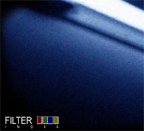
A New Movement in India Cinema
You are invited to attend Bombay's own radical film festival, and participate in the beginnings of a new movement in India cinema. EXPERIMENTA 2006 - the 4th festival of experimental cinema in India returns to Bombay with a compelling selection of films and videos crafted by Indian and international artists.
EXPERIMENTA 2006 has been designed and curated by Shai Heredia. This year's guest curators, Kamal Swaroop (Bombay, India), Amrit Gangar (Bombay, India), Marcel Schwierin (Oberhausen, Germany), Karen Mirza and Brad Butler (No.w.here, UK) will present a selection of 50 films, along with video and film installations.
Main screenings will be held at the auditorium of the Cultural Centre of Russia (formerly The House of Soviet Culture). From hosting the world's first woman cosmonaut to screening Tarkovsky classics, this venue has played an important role in Bombay's history. Film and video installations will be presented at The Fourth Floor, Kitab Mahal.
Registration for delegate passes will commence from February 6th onwards, between 2pm-5pm at the Cultural Centre of Russia. Delegate passes are required for entry to film screenings. No photographs required.
Dates:
15th - 19th February
Venues:
CULTURAL CENTRE OF RUSSIA
Opposite Films Division, 31-A, Peddar Road, Mumbai - 400 062 THE FOURTH FLOOR Kitab Mahal, 192 D N Road, Fort, Mumbai - 400 001
Registration:
Rs 300/- Delegate pass
Rs 200/- Student Delegate pass
For programme information, please visit www.filterindia.com
EXPERIMENTA is a Filter India project in collaboration with No.w.here (UK), Goethe Institute Max Muller Bhavan, the Cultural Centre of Russia and the National Film Archives of India.
EXPERIMENTA is supported by Kodak India, British Council, ITC Grand Central Sheraton and Sula Vineyards.
Posted by jo at 07:29 AM | Comments (0)
February 14, 2006
Reality 10.55 Odense
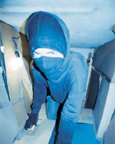
Overview of Contemporary Relational Art
Reality 10.55 Odense showing at Kunsthallen Brandts from February 18 through May 28, 2006 presents an overview of contemporary relational art, a highly critical and democratic art form that often interfaces closely with everyday life realities and is frequently co-produced in close collaboration with the audience. While relational practices have at times been criticised for their close approximation of reality as an unmediated and unedited image, the projects in Reality 10.55 Odense, offer exciting, new and distinctly visible alternatives to art making and to our experience of art and reality.
This exhibition addresses relational practice on several levels, through performative and situational interactions and enactments. Every "spectator" becomes a potential live action participant/co-creator by actual corporeal interaction, expanding, changing, and transforming the pieces in the exhibition according to their own personal preferences and choices. In a slight strategical inflection, situational interactions, interface with specific situations, realities, communities and social activities most often outside the exhibition space. These practices cast an attentive eye onto issues and images that shape our lives and define our perceptions and do not simply replicate, but offer new visions of reality.
Enactments are a very specific category of relational art making that span many forms, including interventions, actions, performances and performative interactions, and propose a rereading through a re representation of the order of things. Accepted histories, common or standard realities, situations, as well as collective and personal identities are given the possibility of a reinterpretation, a re alignment, a re exploration or a re invention.
The participants in the exhibition represent a wide international spectrum, from Australia to Macedonia, from Denmark to the USA. The artists are: AVPD (DK), Ondrej Brody (CZ) and Kristofer Paetau (FIN), Yane Calovski (MAC), Martin Creed (UK), Alicia Framis (SP), FOS (DK), Jeanne van Heeswijk (NLD) and Marten Winters (NLD), Tine Kortermand (DK), PARFYME (DK), Ward Shelley (USA), Andrew Sunley Smith (AUS), Martin Walde (AUT) and Yvonne Droge Wendel (NLD) and Saliou Traore (NLD).
The Tunnel by the American artist Ward Shelley is a good example of a performative interaction. During the entire time of the show, the artist and a crew of workers, named "termites" build a tunnel through the exhibition hall. During this time, the artist lives in the tunnel (replete with a portable toilet). The tunnel is constructed of wood and steel, forming an overhead passage across the space, climbing the building exterior and re-entering through a window. The passage through the tunnel is only large enough to crawl through, ocassionally widening to accomodate for round-abouts. Visitors can join in the building and climb into the tunnel, and might experience a range of emotive sensations, quiet meditation, curiosity, estrangement, fun.
The situational interaction by Yvonne Droge Wendel and Saliou Traore from the Netherlands, involves a large black round ball that suddenly appears in the city. To begin with, this form has no particular meaning. It is simply big, black and soft, and takes up space. Nonetheless, in time as it moves around the streets, alleys, in and around buildings, and as people begin to interact with it, the ball starts to tell a story all on its own. The people of Odense and the black ball become the protagonists-antagonists of an open ended plot. The story develops on the spur of the moment, depending on the curiosity and bewilderment of the co-story teller. In the process "Black Spot" tests the imagination and spontaneity of the citizens of the town.
For this exhibtion we have a guest curator, Maia Damianovic from Great Britain/Vienna, who together with curator Lene Burkard from Kunsthallen Brandts collaborated with the artists on the development of the exhibition and the projects.
Opening : February 17th. 2006
Exhibition: February 18th - May 28th. 2006
Brandts Torv 1 DK-5000 Odense, Denmark
Telephone: +45 65207000 Fax: +45 65207094
For more information, please contact Lene Burkard at tel. +45 6520 7017 or Helle Thylkjaer, PR and marketing at tel. +45 65207021 or mail: helle.thylkjaer[at]brandts.dk. Press images for download: www.brandts.dk
Posted by jo at 12:16 PM | Comments (0)
Ying Zhou's
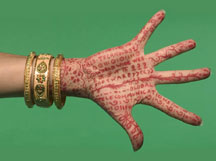
Dance Diary
Ying Zhou's Dance Diary utilizes blogging as a tool for soliciting feedback about her dances, especially from people who are far away. "Some of the diary entries are developed into theater work based on the viewer's input. I am living in Seattle and people from China and other countries in Asia are visiting my dance diary. I truly think this kind of reach and interaction with viewers is unique to internet. Living Seattle, I was highly influenced by the local dancer audience, predominantly white and middle class. It is quite limiting. My first work coming out of the dance diary was developed mostly under encouragement by comments from China. Among the entries, a lot of people said they liked the particular one. So I went ahead to develop it into a fuller solo. It now has been shown around Seattle theaters.
I spend a lot of time surfing the dance blogs and online dances. I have to agree with one of the postings on your site that very few of the dances online are created for the internet. I think my project is one of the few that are meant for the internet, meant to explore how technology changes my way of interacting with the viewers through my art."
Posted by jo at 11:01 AM | Comments (0)
danwade
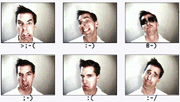
ASCII Conduit
Ikon: a symbol or visual representation. Emote: to express emotion. Emoticon: a combination of text characters that symbolize emotion. Interpersonal communication in its purest form encompasses a host of elements, including: verbalization, bodily gestures, and auditory tonality in physical close proximity between two interactants. Today’s host of cyber communications does not always allow for physical contact, which limits the availability of personal emotional cues. Person to person communication through email and chat programs have led to the development of a series of text characters designed to symbolize human emotion. Emoticons were born from the desire to humanize this correspondence, providing visual markers for human emotion.
In danwade's Emoticon, each emotional composition is matched with a series of keyboard characters that create an emotional symbol. These symbols evolve into a “danwade” interactive experience by combining medias and concepts represented in art such as portraiture, geometric composition and performance art. It infuses them with new media such as digital photography/prints, animated gifs, Flash and the project’s website www.emoticonman.com. The artist meets actor in defining these symbols as specific meaningful moments in what would be otherwise literal ASCII characters. danwade is the conduit in which these symbols are expressed. He brands them with his person through performance, technology and a photorealistic form of portraiture.
Emotions are further explored within the “ikons” segment of this project. Digital prints transform emoticon text symbols into geometric compositions. Weight, positive/negative space obscures lines of literal text characters into portraits, landscapes and abstract forms. The prints utilize a strict palette of text characters that are commonly used with standard emoticons.
danwade translates his identity as an active voice through multimedia in order to achieve a new level of emotional electronic communication. He has personally branded these emoticons as extensions of feeling and expression. The restrictions of online communication evolve. [via Evan on Cool Hunting]
Posted by jo at 08:03 AM | Comments (0)
Special Issue on Performance in Interaction Design
![]()
Call for Papers
Special Issue on Performance in Interaction Design: The operation of computers has always been a performative activity, in the sense that a system’s state changes as a computer runs through a program acting out the tasks specified in the script of a program.
With interactive systems, human actors take their place on stage alongside computers performing activities with and through such systems. The recent emergence of ubiquitous and tangible computing moves the stage of the interaction from the virtuality of the screen to the physical environment. This provides opportunities to address performative interactions that include bodily movements to create novel multimodal approaches.
For interaction designers this requires thinking about interaction in a different way, for example considering the role of the body, beyond ergonomics, for its increased relevance as a presentational, representational and experiential medium. Recently there has been a growing interest in developing interaction design methods that more explicitly recognise and exploit the performative elements and potentials of design activity itself. Across all design disciplines the importance of effective communication has led to an awareness of the need to consider and improve our ability to represent ideas in ways that open up, rather than shut down, dialogue.
Performance, theatre and dramaturgy have begun to figure in the design of interactive systems. This issue of Interacting with Computers will provide a focus for this growing topic of interest.
BACKGROUND
Across the many design disciplines that concern themselves with interaction design there have been long standing debates about the nature, utility, form, timing and quality of communication within the design process. For example, scenarios have found widespread acceptance as a tool for communicating rich user experiences within requirements and design specifications. Whilst they are typically not performed as such, their roots in the forms of traditional narrative point to a performative potential that could be more fully explored.
Within object-oriented software design, the CRC Cards technique combines role-playing with scenario walkthroughs and use-cases to provide design teams with a software Object’s perspective on the systems they’ are developing.
Finally, within the emerging communities of ‘interaction design’ practitioners we have seen interest in the potential of a variety of improvisational theatre techniques such as role playing and bodystorming. All of this suggests that performance in interaction design ought to be a topic worthy of serious consideration.
This special issue of Interacting with Computers aims to map the research landscape of performance and interaction design, to uncover the many ways performance manifests itself in design, and to identify methods that will encourage a wider range of designers and design industries to exploit the potential of performance as a design tool. Themes relevant for submission include (but are not limited to):
- Studies of human-human interaction in interaction design projects (design as performance)
- Historical overviews of performative interaction design
- Critical reports on the use of theatre, performance and drama as tools for exploring interaction design problems, themes or ideas, or as tools in concept design, requirements generation, design and evaluation.
- Studies of the use of dramatic representations of interaction design ideas (e.g. through the use of scenarios, textual or filmic)
- Evaluations and case studies of new and existing methods and techniques to exploit performance in interaction design
- Reports on the use of performative techniques in the evaluation of designs
- Reflections on the impact of interactive technology on already exisiting performative systems
We should stress that we are interested in any and all kinds of performance, for example traditional or improvisational dramatic narrative, interactive theatre, filmed performance, dance, music, etc. We are interested in exploring the widest possible range of ways performance has been or could be utilised, explored or developed within interaction design contexts.
SUBMISSIONS
Deadline for submissions: February 24th 2006
Notification of Acceptance: 17th March 2006
Final version of accepted papers: 31st March 2006
Note this issue will be published in July 2006 - final versions must be in by the date stated.
Submission of manuscripts ( up to 10000 words) are invited. Please refer to
http://www.elsevier.com/wps/find/journaldescription.cws_home/525445/authorinstructions for layout guidelines. However please note that in the first instance manuscripts should be sent to the special issue editors AND NOT the journal itself. Nor should you use the online submission tool at this stage.
Please **email** your submission (in MS Word or Acrobat PDF format) to c.macaulay[at]dundee.ac.uk
REVIEW BOARD
David Benyon School of Computing, Napier University UK
Thomas Inns, School of Design, University of Dundee, UK
Giulio Jacucci, Helsinki Institute for Information Technology Finland
Tomi Kankainen, Helsinki Institute for Information Technology Finland
Ann Light, Interaction, Media and Communication Group, Queen Mary University of London UK
Catriona Macaulay, Interaction Design Lab, University of Dundee UK
Bonnie Nardi, Department of Informatics, University California, Irvine US
Alan Newell, Division of Applied Computing, University of Dundee, UK
Sally Jane Norman, The Culture Lab, University of Newcastle UK
Shaleph O’Neill, Interaction Design Lab, University of Dundee UK
GUEST EDITORS
Catriona Macaulay, Interaction Design Lab, University of Dundee UK
Giulio Jacucci, Helsinki Institute for Information Technology Finland
Shaleph O’Neill, Interaction Design Lab, University of Dundee UK
Tomi Kankainen, Helsinki Institute for Information Technology Finland
Posted by jo at 07:57 AM | Comments (0)
World Community Grid
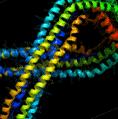
Computers Rise Up
"AUSTIN — People donating their spare computing power to the World Community Grid are helping to find solutions to some of the world's most vexing problems, such as discovering new drugs to combat AIDS. More than a quarter of a million PCs worldwide have joined the nonprofit network, letting researchers crunch data faster and more cheaply. "The World Community Grid takes research projects that were unimaginable by researchers before and makes them possible," said Viktors Berstis, 57, a master inventor at IBM who has led development of the philanthropic project, which his company sponsors.
The grid encourages people, businesses and other organizations around the world with PCs to download software enabling them to donate computer downtime to researchers to solve problems that require supercomputing power. Organizations partnering with the World Community Grid in donating their idle computing time include Coastal Federal Credit Union, based in Raleigh, N.C., the United Way, the Semiconductor Industry Association and the University of Kentucky..." From Computer downtime rising up to work on world's problems by L.A. Lorek.
Posted by jo at 07:42 AM | Comments (0)
February 13, 2006
Grad/Undergrad

Fellowship in Second Life
Linden Lab is pleased to announce its first fellowship in visual and performing arts for creative innovation in Second Life.
This $4,000 fellowship will provide a young artist with a chance to be free for a semester or summer to explore the use of the digital world of Second Life as an artistic medium. In doing so, we hope that we will see Second Life used to even greater potential in the expressive arts to the benefit of both the Second Life culture and the broader world of art.
The application deadline is March 15, 2006. Applications will be reviewed by a panel of distinguished academics, and the fellowship recipient will be announced in mid-April. Applications can be downloaded at: http://secondlife.com/education
Posted by jo at 06:42 PM | Comments (0)
Perfectly Normal:
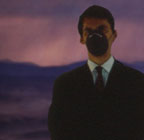
Video Therapy Dispenser
PerfectlyNormal is an interactive web based video project that presents a working model for a virtual therapist using the visual and written language of both the pharmaceutical industry and alternative medicine. Based on the user's description of their current mental state a "diagnostic video therapy dispenser" offers one of fourteen short video therapies. The therapies were created modeled on actual current and past healing techniques pulled from a number of different practices.
PerfectlyNormal toys with the conventions of both the western healthcare industry and it's rival the alternative medicine industry. By presenting video art in the ironic guise as therapy, it demonstrates some similarities between art and therapy. Both affect physical and mental states in unintended or unforeseen ways.
PerfectlyNormal is a web-based project commissioned by Soil Digital Media Suite, Neutral Ground Gallery, Regina, Saskatchewan, Canada.
Michael Stecky is a composer and new media artist whose videos have screened nationally and internationally, most recently at the Microwave Media Arts Festival in Hong Kong. His video work will next be seen at the "Supernovas" exhibition at the Winnipeg Art Gallery, and at the MAI, in Montreal during "Mini-Projo", Festival of Projection.
Posted by jo at 06:34 PM | Comments (0)
man in|e|space.mov
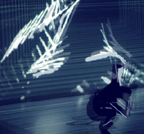
Three Views/Visions of the Body
"ABSTRACT: The article documents the theoretical and aesthetical basis of the interactive dance performance man in |e|space.mov. The text discusses the abstraction of the human body in this performance by an interactive costume of light whose motion is analyzed by a 3D motion-rendering programme, which assembles and recombines the captured frame in real time in electronic 3D space. Thus appears a juxtaposition of 3 visions on the body making up the representation: the eye of the spectator, the camera and the 3D camera view: 3 visions constituting the contemporary body. Furthermore, the text questions the dislocation of the sensual body in physical space to the reading of body as a data in the matrix of virtual space in performing arts. In order to investigate the meaning of the aesthetics of abstraction, and dislocation of human body in performance art and motion analysis, the article puts ‘man in |e|space.mov’ in perspective to historical references of the 20th century, in particular to the work of the physiologist and pioneer of cinema J. E. Marey and the Bauhaus artist O. Schlemmer." Man in |e|space.mov/Motion Analysis in 3D Space by Wolf Ka, ACM MM in Singapor.
Next performance: Where: Festival Hors Saison, Le rendez-vous danse d'Arcadi, Ferme du Buisson; When: 25+26/02/2006 16h/18h; Production: res publica & lab[au] >> danseuse: Marianne Descamps, Musique: Marc Wathieu.
Posted by jo at 09:50 AM | Comments (0)
newmediaFIX INTERVIEW:
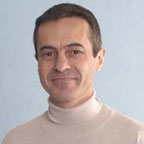
Jose Luis Brea: The Critic Operator of the Web 2.0
newmediaFIX's contributor, Ignacio Nieto interviews José Luis Brea who was formerly Dean of the Fine Arts Academy of Cuenca and Director of Exhibitions for the Ministry of Culture between 1985 – 1988. As a free lance art critic, he is a regular contributor to Spanish and international art magazines including Frieze, Flash Art and Parkett. He is Spanish correspondent for Arforum and regional editor for Rhizome. He has organized multiples exhibitions as independent curator and has published several books including Auras Frias and El Tercer Umbral. Currently, he is prefessor of Esthetics and Theory of Contemporany Art at Carlos III University in Madrid, editor of the magazine Estudios Visuales and he is director of two new online projects: salonKritik and ::agencia crítica::
Ignacio Nieto [IN]: With the popularization of blogs, a number of spaces have developed which had no place within the logic of political economy; contained and produced by media, creating a new front for ideas and critical thinking. For you, what would be the advantages and disadvantages that blog technology has over traditional media (newspapers, radio and television)?
José Luis Brea [JLB]: I believe that there are two fundamental advantages: an extended possibility of access, and participation. The first is very important, of course, because it proposes access to critical thinking that is made available to a larger part of the population, something that was not possible in the past (this is without exaggeration, of course, one must never forget that the supposition of total access is an illusory fantasy—an interest of Capitalist ideology). Considering television and the culture of diffusion, Bourdieu called this the “lowering of the level” (of access). Let’s say that more people heard and saw—maybe even read—for example philosophers; Derrida, and now Zizek, whom they would never have had heard, seen or read before. This is much more evident with new media (especially since the development of the web 2.0)
But for the same reason this amplification (possibility to access) would not have an excessive importance; it would be purely quantitative, it would not contribute without making “more of the masses” the culture of masses, and maybe to incorporate in it cultural objects, of the critical tradition which before belonged to areas in culture less popular, more “elitist” or more reserved for specialized communities, let’s say (for example “deconstruction,” “Theory of acts of speech,” or “antagonist thinking”). This is why I think that the quality that is important is the latter, that which I have called “participation.” This is something that the web 2.0 has re-enforced a lot. Before, of course, it had already occurred that all new media, obviously from radio to video, from “vietnamita” [1] to photocopy or the fanzine, and of course, the website programmed in HTML, makes possible a certain extension of interactivity (in the construct of collective critical thinking), related to the conversion of the spectator/reader/ receiver into emitter. But with the emergence of the blog, forums postnuke, and phpBB, wikis, and podcasting in general all DIY media publication has grown exponentially, and it is there where a great leap has been produced; its impact on the discursive field we currently entertain, (critical thinking), necessarily is huge; and it will ultimately culminate in those diverse forms authors call “collective intellectualization.”
Let’s say that all the manifestations of technologies of treatment, gesture, diffusion, archiving, and organization of access to knowledge (not only the tools of e-science, but also those dialogical and interactive prototypes of the web 2.0), necessarily open and submit critical thinking to processes much more intense and, to put it this way, frantic public contrast. The challenge for critical thinking resides in confronting the consequences of its new logic and its social construct.
And it is there where it should be pointed out, also, the disadvantage, the danger, which respectively corresponds to new media: that the elusive “lowering of the level” is not only produced in the terms mentioned above (of more open access), but also produced as a lowering of the level for content. Let’s say that the public dialogue ends up converting critical thinking into chatter, vulgarity, in an ineventual series of commonalities badly developed and repeated from blog to blog, like echoes each time more hollow of ideas, which in those repostings lose more and more panache and sharpness. In my reflection on the transformation of the tools of cultural criticism with the apparition of these new media, I dedicate an ironic post to this question specifically titled “Chatter” (of unquestionable Benjamanian references, which surely some readers will recognize).
(http://www.agenciacritica.net/criticaeck/archivo/2005/11/chachara.php)
IN: Do you believe that blogs could displace ranking terms in search engines like Google?
JLB: If I tell you the truth, I don’t think so. I don’t doubt that tools of semantic articulation of content (and in some ways efficient for the organization of searches) like Technorati or del.icio.us, or metablogs, could serve a similar function. But, in any case, its utility would be principally limited to the extended blogosphere, let’s say projects specific to the web 2.0, linked to the “personal publication.” Regardless, there are fundamental spaces—all those related to science, with the tools of the web of knowledge, with the new structure of access to the web of academic research (with all the transformations that it is experiencing)—that keep needing tools of organization for navigation, to classify and search, let’s say. On one side, it is evident that this have not been developed autonomously (for instance, there is no search engine for the “web of knowledge,” at the periphery of the search engines proper of databases for specific data, for example ISI Thompson), and on another side, search engines like Google do not stop attending also to those necessary searches. I want to say that at the same time that projects are developed, like Blogger, also they place in effect the digitalization of great libraries. Or, let’s say, that they attend the development of the web of “publication of personal e-culture” as well as the re-conversion and turnaround of the web of “high cultural research” and “academic culture” linked to the development of e-science (I choose general terminology and I use it in an imprecise way, because after all, this is all about trying to understand my response in relation to your question and up to what point I think that the development of those proper mechanisms of the “web of collective intellect” does not cover aspects of change for which old search engines are still essential).
IN: The blogs that work like editors/directors (Salonkritik and Agencia Critica) posses different directions, but they have various areas in common; from the design to the technology that supports them, onto the concept that validates them: criticism. Could you explain the genesis of each of these blogs?
JLB: Of course you are right about both things. It is obvious that they have a lot in common: mainly on a formal level and on their development, which come from the same hand; our team is very small –and I also confess to you that all the programming and maintenance is done by myself; I do not want, nor can I lose too much time in researching technical questions (nor obviously in design), beyond of what is strictly necessary for the final development of specific projects, logically; even though, in any case, we dispose effectively of all kinds of tools—from wikis to systems of podcasting, forums with postnuke or our own blogs running on MT or Wordpress, and all on our own server, which allows us to launch a new project that we find interesting in a matter of hours.
Regarding content and objectives, the two blogs are truly different. SalonKritik basically is a resource of art criticism which is published in Spain, without much pretension other than to align (therefore open to other publics, at the same time and potentially to other debates) something that at a moment occurs only in one medium that simultaneously is elitist and functions very corruptly in Spain like a tool of power, which is the “cultural supplement.” Let’s say that salonKritik tries to destabilize a bit the supplemental economy of authority. Open it to other dynamics (even though I have to admit that the success that we have achieved with this project is not reason to launch fireworks), to enable the publication of visions and perspectives that are not published in that media, to which people can answer… ultimately, to validate justly those other qualities that we know new media have in relation to old media specifically in diffusion, contrast, and participation in the construction of critical thought.
Regarding La Agencia, it is a more modest and ambitious project. More modest in the sense, I suppose, that it would interest a smaller audience, but which is more ambitious when aiming to make public something that did not exist, and which, in my opinion, tainted the cultural landscape in Spain, which is the critique of artistic and cultural politics. There is Art criticism (quite a bit, which is not very good, of course, but very common) but in contrast there is not a lot of criticism about politics of art. And, well, more specifically that is the objective of the Agencia Crítica.
The main problem that I encountered with La Agencia, is solitude (I don’t know if this is as a forward or a goalie before a penalty, to tell you the truth), although it is true that with time la Agencia receives more collaborations by diverse people, which is what I believe would make it more interesting: that it could cover the most expansive set of multiple points of view; as different as possible. In any case, la Agencia has little time online still, and I am confident that little by little, the number of collaborators that want to participate will grow.
IN: A last question: Tell me about your new book?
JLB: Well, I have a couple of years working on it. The dense nucleus is a chapter titled “e-ck: Electronic Cultural Capitalism” which in reality I considered finished two years ago. It basically deals with the process of transformation of Capitalism in which the accumulation of capital is centered mainly on the processes of symbolic and cultural production, and all of the multiplicity of consequences that it has, including in the new political economy of societies of knowledge, as well as the critical position found within these cultural practices.
In any case, the title that the book will have is not that one (of Electronic Cultural Capitalism) but of “Cultura_RAM,” since other previous chapters have focused each time on such conundrum, specifically, of characteristic transformation of cultural practices (and its rules of production, distribution and archiving: there you have the concept of RAM like a new form of characteristic memorization) and the models of production and forms of knowledge, from the university, the museum, to criticism… Some of the texts included, as it always happens with books, have been previously published and distributed online—for example that one on criticism of art, which is the one I referred to above—but many others for now have not been edited. I am definitely finishing the book during the next few weeks, and I hope to send it for publication very soon.
(1) Vietnamita: Spanish colloquial term given to “do it your self” offset machines that were used by the anti-Franco resistance to print pamphlets.
Posted by jo at 09:39 AM | Comments (0)
Upgrade! Vancouver
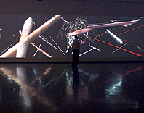
Tonight! Reva Stone
Upgrade! Vancouver: Join us February 13 at 8pm for a talk by Reva Stone. Stone will provide an overview of her practice, including documentation of her recent work, Imaginal Expression, on exhibit at the Surrey Art Gallery until April 2. This viewer activated, computer-generated, real-time animated, 3D environment uses 3D imagery based on protein molecules, wrapped with scanned imagery from the human body - flesh, hair, blood vessels, bruises and scars. As people are sensed in the Gallery, the molecular components begin to animate to form a molecule, to mutate, and follow the movement of the visitor. When the visitor leaves, the molecule begins to degenerate. She will also provide an introduction to the project she is currently developing while working as an Artist in Residence in the TechLab. Exchange combines voice and face recognition software, video capture and graphics to create a work that appears to have sentience.
Where: Western Front, 303 East 8th Avenue, Vancouver, Canada FREE! Everyone welcome. After the talk we'll adjourn to the Whip Gallery for refreshments that have nothing to do with Valentine's Day.
Reva Stone is a Canadian artist well known for her work with digital technologies. She has worked with video, net.art, interactive installations, robotics, responsive 3D environments, and currently is working with voice and face recognition technologies. For more than 10 years Reva Stone has been investigating western culture¹s drive to model, simulate, engineer and manipulate biological life. Living matter is being revealed as increasingly mutable. Reva Stone has exhibited her work internationally and is also active as a curator, a writer, an educator and a mentor to artists through MAWA, Mentoring Artists for Women¹s Art. Although she is based in Winnipeg, she has relocated to BC for three months during her tenure as an artist in residence at the Techlab at the Surrey Art Gallery.
Posted by jo at 09:02 AM | Comments (0)
Daniela Voto
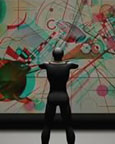
Multisensory Interactive Installation
This paper presents the “Multisensory Interactive Installation,” (MII) a musical interactive installation based on Kandinsky’s paintings, through which a user can become a painter and a composer simultaneously. The painting’s visual elements are synesthetically linked to musical elements: each color is linked to a specific instrument and chord while each shape is linked to a specific rhythm. Through “Multisensory Interactive Installation,” users can explore and manipulate visual elements, generating different musical outputs, constructing and deconstructing the art piece and/or creating a new work, and musical composition. The selection and organization of given visual-acoustic elements, determines the different musical atmosphere created by each user. The methodology implemented in the system/installation, explores the correspondence between color and sound, visual and acustic elements, and is based on the neuroscientific research of synesthesia, an involuntary physical experience of a cross-modal association. Read Multisensory Interactive Installation by Daniela Voto, NOEMA.
Posted by jo at 08:29 AM | Comments (0)
Heara 10
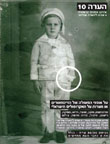
Comments on the Israeli Acropolis
...We are very glad to invite you to Heara 10 event at the Science Museum, where one of our March speaker at Upgrade! TLV-JLM, Tamar Schori, will present her new media installation "Wabbits", specially conceived for the event, in collaboration with Ronen Leibman (concept and video), Amir Markowitz (micro-controllers) and Yair Reshef (Jitter programming).
Between the 40 works that will be presented: Assaf Talmudi will perform his piano session performance (for Max/Msp and piano), Uri Katzenstein & Binya Reches will perform "Hope Machines", a performance for voice, sound live processing, video and a robot, Eran Sachs and Ynon Negev will present their new sound installation and two animation films will be shown: "Jerusalem of Methal" by Sigalit Lifshitz, and "Fallen Art" by Tomek Baginsky, winner of the Golden Nica at last Ars Electronica festival.
"Heara 10" will take place in all the spaces of the Science Museum of Jerusalem. The art works intervene with the spaces and also with the permanent exhibition of the museum. More than 40 works and performances will be presented, made by more than 60 artists, who have created new works in the fields of video, sound, music, new media, performance and installation.
For one day, the artists will turn the Science Museum into an art laboratory which examines the immediate surroundings where the museum is located: the government authorities’ quarters (Prime Minister offices, the Knesset, the Supreme Court, Bank Israel, etc), the Hebrew University at Givat Ram, The Israel Museum. The works will deal with the national institutions in an attempt to comment in a non-conventional way on the modes of action of the State, and the history of the "Nation Hill". For more info and complete artists and works list: www.no-org.net/heara10
Posted by jo at 08:09 AM | Comments (0)
VIII SALON Y COLOQUIO INTERNACIONAL DE ARTE DIGITAL (Eighth International Digital Art Exhibit and Colloquium):

International Call
The Centro Cultural Pablo de la Torriente Brau, with the support of the Historiador de la Ciudad de La Habana (the City Historian), HIVOS, ENET / ETECSA Cubasí Portal, and the collaboration of the Union of Cuban Artists and Writers (UNEAC), the Cuban Institute of Art and Cinema (ICAIC), CUBARTE Portal and the National Museum of Fine Arts (Museo Nacional de Bellas) Artes, announces the Eighth International Digital Art Exhibit and Colloquium (VIII Salón y Coloquio Internacional de Arte Digital) with the purpose of promoting artistic and cultural values created with new technologies.
The Digital Art Exhibit, which will open on June 19, 2006, will show once again the current work in this field and favor exchange and reflection among creators and specialists engaged in these new forms of expression.
The event covers two areas; the National Digital Art Exhibit, of a competitive nature, and a non-competitive International Digital Art Exhibit, where works by artists from other countries will be shown. The works of the International Exhibit will be shown online and in video programs several halls in Havana.
INTERNATIONAL DIGITAL ART EXHIBIT
The Centro Pablo calls on artists from foreign countries to participate in the International Digital Art Exhibit. Various artistic views within this expressive modality will be brought together, thus facilitating debate and considerations on their languages and poetics.
This year the International Digital Art Exhibit will accept proposals for the categories of bidimensional, net art, interactive and audiovisual work. The art pieces will be shown at the website of the Eighth Exhibit, developed by Centro Cultural Pablo de la Torriente Brau and the Portal Cubasí of ENET / ETECSA.
At the same time the event will include a video show that will be exhibited in halls of Centro Pablo, Oficina del Historiador de la Ciudad, ICAIC and the National Museum of Fine Arts. The art pieces must arrive before April 1st., 2006. The artists selected by the admission jury will be notificated before April 15, 2006.
Bidimensional, net art and interactive works online
In each category participants can propose up to three works, that will be sent following the instructions contained in this web address: http://www.artedigitalcuba.cult.cu/inscripcion/index.php
The admission jury will work on the curatorship of the submitted art works that will be included in the Jury Selection Exhibit and the Participants Exhibit in the web site of the event.
Audiovisual works
This category includes videos and digital animation works. Each participant can propose up to three works in VCD, SVCD or DVD (Zone 1 or multizone), NTSC.
Artists can send their proposals from this address:
http://www.artedigitalcuba.cult.cu/inscripcion/index.php, uploading a still image or an animated gif of each proposed work. Besides, the complete work must be sent by fast or postal mail to the following address:
Centro Cultural Pablo de la Torriente Brau
Calle de la Muralla No. 63 entre Oficios e Inquisidor, La Habana Vieja,
Ciudad de La Habana, Cuba
The admission jury will work on the curatorship of the submitted art works that will be included in the Jury Selection Exhibit and the Participants Exhibit to be shown through June and July in cultural centers of La Habana Vieja. Selected artists will be notificated before April 15, 2006.
Centro Pablo cannot return the works submitted and requests participating artists to donate them for non-commercial exhibition to promote future festivals.
INTERNATIONAL COLLOQUIUM
The International Digital Art Colloquium will take place June 20-23. In addition to discussions focusing on the work included in the two exhibits, artists, scholars and critics will make presentations on the potentials and the development of these new forms of artist expression.
The request to participate in this International Colloqium should be sent to Centro Cultural Pablo de la Torriente Brau by registering and filling the form at http://www.artedigitalcuba.cult.cu/inscripcion/index.php before May 15, 2005
A fee of 50 pesos cubanos convertibles (CUC) is required from all participants in the International Colloquium. Participants from abroad will pay their inscription fee to the Colloquium at the Centro Pablo before the beginning of the event.
The inscription will allow participants to receive all the printed information about the Eighth International Digital Art Exhibit and Colloqium, including the poster created by the Seventh Exhibit winners, and to attend the debate sessions and openings during the first week of this cultural event.
TRAVEL ARRANGEMENTS
Artists, critics, professors, journalists, students and specialists from other countries interested in taking part on the Eighth International Digital Art Exhibit and Colloquium may make their arrangements through:
Agencia de Viajes HAVANATUR
Caridad Sago Rivera, especialista comercial
Tel.: (537) 203 9099
Fax: (537) 203 9130
e-mail: sago[at]cimex.com.cu
Or directly in:
Centro Cultural Pablo de la Torriente Brau
Calle de la Muralla No. 63 entre Oficios e Inquisidor, la Habana Vieja
Ciudad de La Habana, Cuba
Tele-fax: (537) 866 6585
Teléfono: (537) 861 6251
Correo electrónico: centropablo[at]cubarte.cult.cu
We invite you to visit the web sites of Centro Pablo and our previous Digital Art Exhibits:
www.artedigitalcuba.cult.cu
www.artedigital6.cubasi.cu
www.artedigital7.cubasi.cu
www.centropablo.cult.cu
www.centropablonoticias.cubasi.cu
www.aguitarralimpia.cubasi.cu
Posted by jo at 07:56 AM | Comments (0)
ECHOES FROM THE MOUNTAINS

Sounds of XX Winter Games
Sound surrounds us all the time. John Cage pointed out that there is no such thing as silence; from practically the time we are conceived until the time we die, we live bathed in non-stop sound. Echoes From the Mountains – Suoni in Alta Quota, a sound project of the official Cultural Olympiad program, is about tuning into this force of nature and of art creating “sound environments” which will stimulate the public to pay more attention to the world of sounds, may these be natural or the elaboration of an artist or a composer.
All of the artists--with the exception of the ones showcased in the Morrow Sound Cube--were asked to produce specific sound works responding to the unique characteristics of the project such as its geographical location, the Winter Olympic Games framework, and the diverse and heterogeneous audience that is going to interact with their installations.
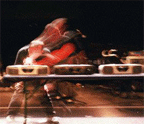
Special event of the project will be Phil Kline’s performance Chinook, a sound sculpture of many individual parts, recorded on audio tapes or CD and played through multiple moving boom boxes. The participants to the performance are asked to meet at a certain time and in a given location and to bring along their own boom boxes (some will be provided by the organizers and available for those who may not have their own). Kline will then give out the cassettes and CDs to those provided with a stereo and at his go! they are asked to push the play button. The artist leads the crowd in a 30 minutes “musical stroll” throughout the streets of the town.
Sound installations:
JOE DIEBES, Emblem: Salice d’Ulzio, giardini pubblici di Via della Torre
ENRICO GLEREAN, Nipha: Cesana, Via Roma
MorrowSound™ Cube, with Charlie Morrow, Olivia Block, Steve McCaffery, Miya Masaoka, Scanner, Vlada Tomova: Sestriere, Piazzale Fraiteve
STEPHEN VITIELLO, Whoosh: Bardonecchia, Piazza Valle Stretta
ZIMMERFREI, Frozen: San Sicario, arrivo telecabina
Live performance: PHIL KLINE, Chinook: Salice d’Ulzio, via Assietta, p.tta ufficio postale February 14th, 6.00 pm; Bardonecchia, meeting point via Medail 61, February 19th, 5.30 pm.
Posted by jo at 07:03 AM | Comments (0)
Felix Stalder

The Stuff of Culture
As culture is infusing more and more aspects of contemporary life, and the range of producers is widening but the special status of the artist and the social capital attached to this position, is being eroded. Artists are becoming, again, artisans, not fundamentally different from others creative producers. The controversy between the object-oriented and the exchange-oriented visions of culture is currently being fought on all levels, legal (expanding versus narrowing copyrights and patents), technical (digital rights management versus distribution and access technologies), and economic (exchange of commodities versus provision of services). Crucially, however, it is also fought in the field of culture itself, in ongoing experimentations on how we can produce, reproduce, and interpret new forms of meaning. This is the native environment of artists and other creative producers, whose everyday practice puts them at the heart of this epic struggle. Read The Stuff of Culture by Felix Stalder, NOEMA.
Posted by jo at 07:01 AM | Comments (0)
February 12, 2006
UBERMORGEN.COM (Lizvlx/Hans Bernhard)
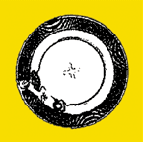
Lilly controls my Foriginals
Lilly controls my Foriginals by UBERMORGEN.COM (Lizvlx/Hans Bernhard); February 25-April 8, fabioparisartgallery via Alessandro Monti 13 - 25121 Brescia - tel. 030 3756139 - skype: fabioparisbs.
For his first Italian personal exhibition, the Austrian collective UBERMORGEN.COM (Lizvlx/Hans Bernhard) offers a synthesis of his recent work, that deals with the subtle membrane that connects the digital and the biological: a mix that UBERMORGEN.COM, an identity that lives and works on the Net, experienced on his own body. One of the best-known exponents of the net.art scene, UBERMORGEN.COM is the theorist of digital actionism, a radical practice of artistic action which experiments on the market of attention and takes place into the media scape. The most astonishing result of this kind of practice was Vote-Auction (2000), a web site that, during the American presidential elections 2000, helped people to sell their vote to the highest bidder. The legal prosecution against UBERMORGEN.COM, and the media hysteria it produced, are an important part of the whole project. During the performance, UBERMORGEN.COM were interviewed up to 30 times per day, and was broadcasted by CNN in a 30 minutes show, the legal format Burden of Proof; but he never said whether the project was a real threat to the integrity of the U.S. election or wheter it was a political satire.
In the mass media storm, the digital actionist works with his whole body, as well as part and victim of the network around him.“We are the children of the 1980s, We are the first Internet-pop-generation... Hans Bernhard is loaded with 10 years of Internet & tech [digital cocaine], mass media hacking, underground techno, hardcore [illegal] drugs, rock&roll lifestyle and net.art jet set...” His neuronal networks are connected to the global network, and his mental illness – the bipolar affective disorder that in March 2002 sends him in a mental hospital – is the network's illness. The video called Psych|OS (2005) sums up that experience, in which those two levels – digital and real, bio & tech, nervous system and operative system – merge.
This nervous system, infected by the hi-tech, needs a treatment, and the hi-tech society prescribes its remedies, “bio-chemical 'agents' which control the internal information flow”. Olanzapine, an antipsychotic drug produced by the pharmaceutical company Eli Lilly as Zyprexa®, is one of these agents. In the digital prints Zyprexa “Lilly 1112” and Zyprexa “Lilly 4117” (2005), UBERMORGEN.COM paints its molecular structure, but during this translation process the molecule discovers to be made by bits. “Just pixels on a screen, just ink on paper”, like the Foriginals (forged originals), the conceptual device UBERMORGEN.COM uses to change legal documents into legal art. The title of the show – a declaration of poetics that seems a declaration of love – comes from here. “Lilly controls my Foriginals” means “Lilly controls my artistic work”, where Lilly, that seems the name of a woman, is in fact the name of a pharmaceutical company. Lilly “controls”, inspires as well as oversees, supervises the contact between my brain and my hard drive.
Besides, UBERMORGEN.COM is not the first to say that “the pixel is the molecule” and that technology is the demon under the skin. RFID (Radio Frequency Identification) chips are one of the leading technologies of the future: an identification system which can collect all the required informations about the products, or the people, they are attached to. From a formal point of view, RFID chips reveal an organic structure, surprisingly similar to a cellular structure. With the ART FID (2005) series, UBERMORGEN.COM tells us, with the visual impact of a suprematist painting, this mix between biotechnologies and digital technologies, this neverending overlapping of two contiguous levels that is shaping our identity – and that, by now, already shaped his own one." --Domenico Quaranta, NOEMA.
Posted by jo at 02:34 PM | Comments (0)
February 10, 2006
Human Browser's
![]()
First Female Browser
Human Browser is a series of wireless Internet performances based on a Wi-Fi Google hack. Thanks to its headset, the actor hears a text-to-speech audio that comes directly from the Internet in real-time. The actor repeats the text as he hears it. The textual flow is actually fetched by a program (set up on a Wi-Fi laptop) that hijacks Google, diverting it from its utilitarian functions. Depending on the context in which the actor is, keywords are sent to the program and used as search strings in Google (thanks to a Wi-Fi PDA) so that the content of the textual flow is always related to the context.
Feb. 2, 2006: Manon Kahle has become the first Female Browser. During four days, the visitors of the Transmediale festival in Berlin have fallen beneath her spell. Extract 1 - Extract 2 - Extract 3 - Extract 4 - Extract 5 - Extract 6. You can also watch here the "guided tour" of the exhibition by Human Browser. On the video you can see works by Simon Penny, the Yes Men and Simon Möller. Videocamera: Valérie Pavia / Florence Pélissier; The video was broadcast on the website of the french newspaper Libération. [via WiFi-ArT]
Posted by jo at 06:55 PM | Comments (0)
>OVER
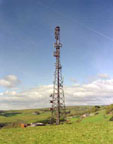
[TELE]COMMUNICATION
"Are you ready?" the message went out. The first message to cross water, the first wireless communication. The exhibition >OVER is, in part, a homage to Marconi’s ground-breaking experiments that he undertook near Cardiff to develop the first ever wireless transmission in 1887, a breakthrough to which nearly all of today’s telecommunications are indebted.
The means we use to send and receive messages influence the language we use, from the considered etiquettes of letter writing to the rash disposability of email and the text message; from the formalities of a landline telephone conversation to the obliviousness or indifference of the mobile phone user giving a prefixed report on their location. >OVER explores this territory. The artists either engage in methods of communication to produce the work, or they examine the impact, the language and significance of those methods.
Stefhan Caddick explores the text phenomenon. An LED sign facing the street from the gallery will display text messages sent from members of the public to its receiver. He gives us the opportunity to address the city. The project’s intention is to encourage members of the public to evolve a new use for these signs, which usually carry important but mundane information. Instead the Variable Message Sign will carry text messages, which by their nature are often deeply personal.
Lizzie Hughes’ two sound pieces expand and compress time and space by way of a simple telephone inquiry. In Second Empire State Building Piece, she telephones each of the building’s eighty floors, asking each occupying company in turn which floor they are based on. Their responses create an image of the building, but not one we might recognise or expect. Similarly, in a second piece, Lizzie telephones various locations around the globe to request the local time, which differs from call to call. She phones the same regions again over the course of 24 hours: this time each recipient reports identical times. The piece draws attention to the geographical and temporal scale of the world, its diurnal movement and our place within it.
Jennie Savage’s work Note To Self compels us to reflect on what we consider important enough to communicate to our future selves. We are invited to write a personal log that takes on archival significance because it will not be sent until 2011. By reverting to letter writing, a method of communication that now seems archaic, Note To Self gives a simple but enduring voice to our everyday, which would ordinarily pass without record.
If Jennie Savage opens out the communications loop by expanding the gap between sending and receiving, Paul Cabuts short circuits it. For the series Transmissions he has photographed telecommunications masts across South Wales. The range of these masts stretches across Wales and the UK, yet their surroundings are specific to South Wales. Transmissions illuminates the didactic nature of these structures, which are at once fixed yet transient, anchor points in the ebb and flow of cultural expediency and information exchange.
You are invited to the preview of the show on the 10th February from 6.30 at g39 Wyndham Arcade, Cardiff CF10 1FH. >OVER runs from 11th February to 18th March 2006. g39 is open 11-5.30 Wednesdays to Saturdays.
Posted by jo at 06:25 PM | Comments (0)
Globalisation/Colonisation

Constructing a practice in the space of Post Autonomy
1st – 30th March 06: Presented by the Bureau of research into Post Autonomy – David Goldenberg, Stefan Beck and the assistance of Giulia Bonali: A series of random, strategic, interventions around London in public and virtual spaces – With contributions from Basekamp, Stefan Beck, David Goldenberg, Interactingarts, Christian Nold, Wim Salki, Stateless Nation, Stevan Vukovic Anabela Zigova.
The project proposes to stage a thought experiment - that looks at the conclusion and by-passing of the tradition of a Euro-centric art practice so that we can then go onto construct an entirely new model – against the backdrop of Globalisation - under the umbrella term of Post Autonomy.
Our entry point’s into the construction of Post Autonomy is via addressing the processes and issues of “Globalisation” and “Colonisation” – in this case as present within London with its claim to be a Global City. In order to make visible the dynamics and mechanisms of Globalisation, Colonisation, and the role that art plays in this process, the contributors will come together through the exploration of a participatory methodology [which can be found on wiki page] to design a series of strategic interventions into both the visible and de-material fabric of London.
The project aims to confront complex and difficult issues which are neither easy to frame within the language and concepts currently at our disposal, nor for that matter, once they are brought to the surface easy to resolve. For instance –
“How much of the European tradition of art and Mind set is it possibleto jettison?”
“How is it possible to use the material generated by the interventions to map the dynamics of Globalisation and Colonisation throughout London along with arts involvement?”
“How do we then use this material to go onto construct a Post Autonomous Practice?”
In addition to the interventions there will also be an on-going series of on-line debates along with dinners and discussions at venues around London.
The programme of activities can be found from the end of February on: www.postautonomy.co.uk www.nodel.org www.interactingarts.org
For further information and documentation on any aspect of the project
please contact Giulia Bonali on giulia[at]postautonomy.co.uk
Information on the Bureau of research into Post Autonomy and the launch of the Post Autonomy website.
The beginning of 2006 sees the launch of the Bureau of research into Post Autonomy – dedicated to the research, archiving and promotion of all aspects of Post Autonomy.
This will be the principle vehicle for exploring new models and thinking into a contemporary cultural practice. The centre for all research, information, archiving, promotion and operating will be the new website. This year will also see a continuation of a series of projects whose purpose is to both open out and map the uncharted territory and domain of Post autonomy – Beginning with “Constructing a practice in the space of Post Autonomy” In March as part of Node London – information can be found on http;//www.nodel.org The project continues on from the “Space of Post Autonomy” which took place as part of the Open congress event at Tate Britain in October 05 Information on further projects will be posted at regular intervals throughout the year – while at the same time information – plus photographic documentation and texts on past projects - can be found on the Post Autonomy website.
Posted by jo at 03:55 PM | Comments (0)
TANGENT_FEAR:
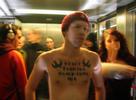
INVITING HORROR
What is rejected and refused in the symbolic order, reappears in reality. Specters, ghosts and phantoms haunt the world. (Peter Weibel on Jacques Lacan)
TANGENT_FEAR presents Inviting Horror, an artistic research project by Karen Lancel and Hermen Maat which investigates the experience of fear in public space. In a world in which daily activity is monitored through electronic technologies marked by networked surveillance systems, biometric scanning and profiling mechanisms, people are required to surrender access to their personal spheres of privacy and movement. Under the guise of community safety and anti-terror security a demand for ultimate transparency is made. Suspense is created and the urban space becomes a phobic zone, a horror-scape, in which an explosive mix of aggression and desire results in an irrational need to remove one’s self from the public sphere, a desire for the incognito.
To invite horror, and offer it a safe haven within our personal realms of well being and spheres of desire, implies both an obvious impossibility and a potential to counter the loss of control of our public domain. Using the movie related notion of horror, we search artistic strategies and scenarios in which the transition from desire and fear to a social phobia can be (re)constructed as a real-time and real-space action occurring live in the public sphere. Karen Lancel and Hermen Maat have invited a group of artists and researchers whose work centers on notions of fear, the body and perception to engage a broader public audience to discuss and explore these issues to bring horror ‘inside’ from within the public sphere.
V2_, Eendrachtstraat 10, 3012 XL Rotterdam
Friday 3 March 2006, 19:00-22:00 hrs
Admission: 2,50 EUR
Live stream & IRC chat: http://www.v2.nl/live
Inviting Horror: KPN Media Facade 'City Mobile Monument'
In conjunction with TANGENT_FEAR Rotterdam citizens are invited to upload short statements on urban experience to the running text display of the KPN Communication Tower. The City Mobile Monument forms part of Inviting Horror’s experiential archive which travels through and connects numerous urban centres worldwide. To upload a statement, please send a mail with your short text to info[at]invitinghorror.org KPN Telecommunication Company / Erasmus Bridge Tower, Rotterdam from 25 February to 5 March 2006.
Participants
Jordan Crandall, media artist and theorist, UC San Diego, recently completed Homefront, a video installation exploring the psychological dimensions of the new security culture.
Dennis Del Favero is a Sydney based artist and researcher, presents his video piece Pentimento, and will discuss the aesthetics of trauma through Nachtraglichkeit, a work in which he introduces the work of Pierre Janet.
Jill Magid, both performer and director, she engages the systems of discipline in society, such as police, CCTV, and forensic artists by exploiting the dormant possibilities of their services. She employs the system, via its latent qualities, to establish an intimate and poetic experience.
Marc de Kesel, Lacanian philosopher and researcher, Jan Van Eyck Academie Maastricht, will talk about the violence which is inherent to people, and the incapacity to deal with violence lucidly. An impossibility that makes violence only more malicious.
Karen Lancel and Hermen Maat experiment with new art forms for social cohension using electronic communication devices. In their performances and installations Lancel and Maat use a combination of online and offline media in which they invite the audience to participate. They design projects for urban public space such as those found at train stations, airports, museum lobbies, theaters, universities, construction sites, and city squares. Much of their work is developed in collaboration with V2_Lab
(Rotterdam) and Montevideo / TBA Netherlands Institute for Media Art (Amsterdam).
Special thanks: EYEBEAM New York
V2_, Institute for the Unstable Media
Eendrachtsstraat 10, NL-3012 XL Rotterdam
PO Box 19049, NL-3001 BA Rotterdam, NL
Tel + 31 10 206 72 72 | Fax + 31 10 206 72 71
E-mail info AT v2.nl | URL http://www.v2.nl
Posted by jo at 03:38 PM | Comments (0)
mimoSa
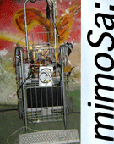
Media Revolution
Having survived colonisation, dictatorships, and inflation of 2639%, Brazil entered the 21st century with nearly half of its population living in extreme poverty and its media tightly controlled by Rede Globo, one of the biggest conglomerates in the world. Enter mimoSa--an 'urban intervention and information correctional machine'--inspired by the belief that a new system of public broadcast is a means to achieve better distribution of power, representation, and visibility. Employing free and open source software, the machine facilitates the recording, uploading, and transmission of public stories. 'mimoSa' is now travelling throughout Brazil holding workshops at which people can build their own machine and take control of their own media. Telephone numbers and instructions are also painted on city walls and streets so that anyone can participate via their mobile phone. Created by Brazilian activists midiatactica.org, Canadian group Murmur, and individual artists and programmers, 'mimoSa' was commissioned by Turbulence.org in October 2005. Look out, Rede Globo! - Helen Varley Jamieson, Net Art News, Rhizome.
Posted by jo at 03:20 PM | Comments (0)
Rhizome Commissions Program: 2006-2007

CALL FOR PROPOSALS
Deadline for proposals: April 1, 2006: Rhizome is pleased to announce that with support from the Greenwall Foundation, the Jerome Foundation and the New York City Department of Cultural Affairs, between eight and eleven new Internet art projects will be commissioned in 2006.
The fee for each commission will range from $900 – $3,000.
Artists are invited to submit proposals for new works of Internet-based art. There is no required theme. The works can manifest offline, as long as the Internet is a primary vehicle in the creation of the work, and the final work is accessible online, whether through a web browser, software, or some other use of internet technologies.
When evaluating proposals, the jury will consider artistic merit, technical feasibility, and online accessibility. Although we will provide some technical assistance with final integration into the Rhizome web site, artists are expected to develop projects independently and without significant technical assistance from Rhizome.
+ How to Submit a Proposal +
The jury will only consider proposals from members of Rhizome.org. To sign up for Rhizome membership, please visit:
http://rhizome.org/preferences/register.rhiz
There are two parts to proposal submission:
You must create a proposal in the form of a web site that includes the following key elements:
+ Project description (500 words maximum) that discusses your project's core concept, how you will realize your project, and your project's feasibility. If you plan to work with assistants, consultants, or collaborators, their roles and (if possible) names should be included.
+ You are encouraged, but not required, to include a production timeline and a project budget, which should include your own fee. If you have other funding sources for your project, please indicate this in your budget.
+ Your resume or Curriculum Vitae. For collaborative groups, provide either a collective CV or the CV's of all participants.
+ Up to 5 work samples. Note: More is not necessarily better. You should include only work samples relevant to your proposal. If your proposal has nothing to do with photography, don't include images from your photography portfolio. Please provide contextualizing information (title, date, medium, perhaps a brief description) to help the jury understand what they are looking at. The work sample can take any form, as long as it is accessible via the web.
When designing your web-based proposal, please note that the jury will have limited time for evaluations, so try to make your site clear and concise.
When your web-based proposal is complete, you are ready for Part Two of the proposal process:
Submit your proposal for a Rhizome Commission via an online form at
http://rhizome.org/commissions/submit/.
We do not accept proposals via email, snail mail, or other means. Proposals will be accepted until 12:00AM EST (that's New York time) on Saturday, April 1, 2006. The form requires the following information:
+ Name of artist or collaborative group
+ Email address
+ Place of residence (city, state/province, country)
+ Title of the project (this can be tentative)
+ Brief description of project (50 words maximum)
+ URL of web-based proposal
+ Jury +
Proposals will be reviewed by a jury consisting of Lauren Cornell, Executive Director of Rhizome; blogger Regine Debatty of we-make-money-not-art, net artist Olia Lialina, Professor at Merz Akademie, Stuttgart; artist and writer Eduardo Navas, also founder and contributing editor of Net Art Review and New Media Fix; and Marisa S. Olson, artist and Editor and Curator-at-Large at Rhizome.
Rhizome members will also participate in the evaluation and awarding process through secure web-based forms. In this phase of evaluation, Rhizome members will be directed to the submitted web-based proposals. While this more open jurying process does mean that proposals could possibly be discussed publicly, there have been no reported conflicts or abuses of information reported.
+ Winners +
Winners will be contacted on or after May 23rd, 2006. Each winner will be asked to sign an agreement with Rhizome.org governing the terms of the commission. Commissioned projects will be listed on the main Rhizome Commission page and included in the Rhizome ArtBase.
+ Questions +
If you have any questions about the Rhizome Commissions, send an email to commissions[at]rhizome.org.
Posted by jo at 10:27 AM | Comments (0)
UNIVERSITY OF CALIFORNIA, SANTA CRUZ
![]()
Digital Arts and New Media Festival
UC Santa Cruz Digital Arts and New Media MFA Program is pleased to announce the Digital Arts and New Media Festival taking place at UCSC between May 4th and May 7th, 2006. The UCSC DANM MFA Program serves as a center for the development and study of digital media and the cultures they have helped create. The DANM Festival 2006 will showcase the expanding arena in which this new art practice is emerging and it will signal UCSC’s presence as a prominent center of activity in digital arts and new media. The DANM Festival 2006 introduces the campus and the public at large to cutting edge experimental work and serves as a bridge to the local community through collaborations with the The Museum of Art & History @ The McPherson Center and the Santa Cruz Film Festival.
Presenting work by national and international artists, expert speakers, and members of the DANM MFA Program, the DANM Festival 2006 features the following events:
EXHIBITIONS
PHYSICAL | DIGITAL
The Museum of Art & History @ The McPherson Center, Santa Cruz
May 4 to May 14: The works included in Physical | Digital reveal a remarkable match between subject and medium. Jim Campbell, Paul DeMarinis and Camille Utterback share an intense involvement with technology that is both intellectually stimulating and emotionally engaging.
BLINK
UCSC Porter Sesnon Gallery, May 5 to May 7: Blink presents the works of from UCSC DANM MFA students.
SYMPOSIA
May 5, UCSC, Studio C, Communication Building
May 6, UCSC, Media Theatre, Theater Arts M110, UCSC
The DANM Festival Symposia includes 5 panels about Digital Arts and New Media theory and practice. The specific subjects of the panels are:
I.THE ART OF ALTERNATIVE ENERGY, Chaired by Elliot Anderson (Assistant Professor of Electronic Media, UCSC, DANM Faculty).
II. DIGITAL CARTOGRAPHIES, Chaired by Ted Warburton (Assistant Professor of Theater Arts, UCSC, DANM Faculty).
III. ALGORITHMIC METHODS AND MODELS IN THE ARTS; Chaired by David Cope (Professor of Music, UCSC, DANM Faculty) and Paul Nauert (Associate Professor of Music, UCSC, DANM Faculty).
IV. AUDIBLE TERRAIN: SHIFTING GROUND IN CONTEMPORARY SOUND PRACTICE, Chaired by Ed Osborn (Assistant Professor of Art, UCSC, DANM Faculty).
V. THE ROLE OF VIRTUOSITY IN A TECHNOLOGY-ENHANCED PERFORMANCE, Chaired by David Merrill (MIT).
MUSIC PERFORMANCES
May 6
Media Theatre, Theater Arts M110, UC Santa Cruz
The DANM Festival will include the performances by three artists. Two of them, Laetitia Sonami and Sue Costabile, have been working together recently and their collaboration will be a live sound/film performance (with Costabile's work "I.C. You"). Sonami will also perform her solo piece "The Appearance of Silence (The Invention of Perspective)". John Bischoff, the third artist, has been creating electronic music for solo performer and in computer network bands for over 20 years.
FILM SCREENING
May 5, 8.30 to 10.30 pm
Media Theatre, Theater Arts M110, UC Santa Cruz
In collaboration with the Santa Cruz Film Festival, the DANM Festival will present some rare historical works that have been very influential in the development of digital art along with other films done by contemporary artists such as Harun Farocki.
Last but not least, the DANM Festival will also include a series of satellite events that will take place throughout April, May and June 2006.
The DANM Festival has been kindly supported by UCSC Porter College.
For further information please contact:
Elena Lledó
Festival Coordinator
Tel: 831 457 2027
Email: elledo[at]ucsc.edu
Posted by jo at 09:27 AM | Comments (0)
February 09, 2006
Emotional Traffic

THE MECHANICS OF EMOTION
Playing instruments is the common lot of music. Playing with emotions is the common lot of politics and entertainment. Considering the Net as the World nervous system. Scanning the Web, we can get a real time image of the state of mind of the World. Starting from that data, we build up the dynamic maps of the emotions of the planet.
Emotional Traffic is a music/Internet on stage performance in which the emotions of the World are considered as music instruments. We (Jean-Baptiste Barrière and Maurice Benayoun) play the maps of the emotions extracted in real time from the Net. On stage a big screen that displays the mixing of the maps of different emotions. The maps are built in real time, with words, bigger or smaller according to the feed back from the Web. The words are coming one after another so that the increasing density of terms makes the sound more complex. Different lines scans the screen and the map of mixed emotions at a speed controlled by the directors in the big hall space.
5 smaller screens, like Kakemonos, display the projection of 5 seperate maps of emotions, presented like globes, from FEAR to SATISFACTION. A meridian line turns around each sphere, scanning the map, building the sound out of the map of the emotion considered as a musical score. The directors control the speed, the frequency, timbre and the texture of sounds.
A camera analyses the moves of the audience. One sound layer coming from the reading of the maps is a rhythmic component. This component becomes stronger when the audience move is higher and he rythmic component is lower when the audience is static. This feed back loop help the directors to create a reactive music that will capture the audience attention. In response the principle gives the audience, by playing with the feed back, a possible control of the system (move/rhythm loop).
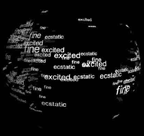
World Emotional Mapping: It is now easy, thanks to any existing search engine running on the Web, to build a semantic map of any concept. Not even trying to understand what is behind a single use of one word, we know now how many times a word is used in correlation with another. For our purpose we track the words in correlation with locations. According to the number of occurrences, the original keyword is located on the map with the appropriate size.
The cartography of the emotions consists on automatically building the map of the emotions over the World. Though, the keyword "stress" is used in association with thousands of city, region and country names in order to get the resulting number of hits form an Internet search engine. This operation is done again and again so that we get a perfect representation of how a word describing an emotion is related, on the English speaking Web, to locations.
The WEM (World Emotional Mapping) is not neither a scientific representation nor an objective portrait of the World emotions but it shows how the digital mass medias monitor the World. One should notice that continents like Africa seem not to have any emotion. In fact, it is only not present on the Web at the right scale according to the actual population. [via information aesthetics]
Posted by jo at 11:57 AM | Comments (0)
Epidemic Menace
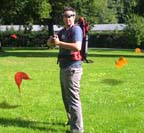
Crossmedia/Space Gaming
Epidemic Menace is a pervasive crossmedia game. Crossmedia games focus on a wide variety of gaming devices including traditional media channels, game consoles as well as mobile and pervasive computing technology to allow for a broad variety of game experiences. The overall goal of the game is to prevent the virus from escaping the campus, to clear the campus from the virus instances, create an antivirus to save Prof. Ivy Miller and to find out what happened on the campus. The winner is the team that that leads the high score list.
The game consists of two competing teams and each team holds a minimum of 5 players. Each team receives at the beginning of the game: 5 smart phones (one for each player); 1 Palmpilot; 1 AR system; 5 special online accounts (one for each player). Players can change devices or play modes anytime and can play on their own if they wish but have clear advantages through collaboration.
Game Space: The game is played in a physical and a virtual game space and teams have to play in both spaces in order to extinguish the virus. The virtual game space will be a model of the physical game space and game appearance and game mechanics will be adapted in the physical and the virtual game space. For example, the virus appears differently in both spaces.
In the physical world the virus may appear as: Spatialized sound, 2D Map, based display of viruses in proximity, Overlaid 3D graphics on AR devices, And in the virtual world the virus may appear as: Sound, Animated 2D and 3D graphics.
Storyline: The Dean of the Schloss Birlinghoven medical research laboratory Prof. Dr. Wolfgang Mathiessen has been working on a epidemic prevention program called EEPA (European Epidemic Prevention Association) for years and is very close to a mayor breakthrough that would have revolutionized the virus simulation programmes used by medical institutes around the world when the most part of his work is stolen and copied by a villain. The villain uses his work to infect a defined area of the Schloss Birlinghoven complex, his motives and his approach are unknown. The situation escalates when one of the medical researchers Prof. Ivy Miller is infected by the virus and falls into a coma. The EEPA is informed and a small group of experts is send to Schloss Birlinghoven to take care of the situation. [via pasta and vinegar] Report about the Crossmedia Game Epidemic Menace by Jan Ohlenburg1, Irma Lindt1, and Uta Pankoke-Babatz1 [PDF]
Posted by jo at 11:28 AM | Comments (0)
Bruce Sterling's
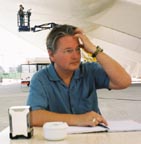
6 Trends in Technology
"...I think there are 6 trends in technology which all have something to do with physical objects and they all end up to a new kind of cultural sensibility for objects:
Interactive Chips: we now have objects can be labeled with interactive chips, that can be labelled with unique identity - RFID, electronic barcoding, arphids (rf-i-d for french).
Geolocation: positioning systems for physical objects in the cartesian environment.
Powerful Search Engines: we can actually find things digitally, it's not a project for google, we will end up googling objects pretty soon.
3D Modeling for objects, virtual design, computer-aided design, computer aided manufacturing.
Rapid Prototyping of objects: fabricators, computer fabricators, moving making objects from virtual design in a single manufacturing step: fabjects, blogjects.
Cradle-to-Cradle recycling: transparent production, watching objects move digitally from the moment to which the design to the moment when they're torn apart and recycled.
These are 6 big trends, all put in one bag. The outcome is that people will interact with objects in an unprecedented way; essentially we will end up with manufactured objects those information support system will be so extensive that there will be regarded as material extension of immaterial systems (we see them as hard copies of data-support systems). This would take 30 years away. I tend to try to describe what it would be like to live in these circumstances.
So I came up with a neologism to pack those concepts: I made up the word "spime", it's a noun, I don't expect it to stick or pass the general usage but as a novelist and a journalist and design critique I need a single syllable noun for an object that is plannable, findable, trackable, recyclable, uniquely identified that generates digital histories.
That's what a spime is and building this concept into a single verbal package, it's a kind of victorinox knife, a swiss multi-tool.
I want to say things like "that's a spime, she's spimable, it's too spimmy, that is not spimmy enough..."
From Spimes and the future of artifacts by Bruce Sterling,
LIFT06, February 3, 2006, Geneva [via pasta and vinegar]
Posted by jo at 11:12 AM | Comments (0)
On & Off:
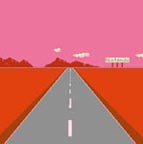
The Expanding Domain of Internet Art
"Concurrent with a wave of technological optimism and new capabilities during the mid-’90s was the steady rise of “net.art.” Artists who used the internet to make and distribute work could easily subvert institutional and market-based constricts, had no historical shadow to answer to, could “show” their work 24/7, and—crucially—work without spending a fortune on materials. The star of internet art may have faded slightly since (mirroring the decline of utopian rhetoric about the internet’s ability to provide a new level playing field), but it certainly hasn’t disappeared, as exhibitions like The New Museum’s Rhizome ArtBase 101 and recent solo shows by artists like Cory Arcangel and Jacob Ciocci have shown. Internet art may actually be more “present” than ever—just not exclusively in virtual space." From On & Off: the Expanding Domain of Internet Art by Caitlin Jones, NYFA Current.
Posted by jo at 10:53 AM | Comments (0)
SNAil-based data transfer Protocol
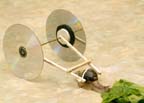
Data Transfer via Snail is Faster than ADSL and Pigeons
KinnerNet, co-founded by former ICQ chairman Yossi Vardi, is an Israeli geek camp-out modeled after Tim O'Reilly's amazing Foo Camp. At the recent KinnerNet 2005, Vardi and his pals Shimon Schocken and Ami Ben-Basat demonstrated that snails can be faster at data delivery than both ADSL and pigeons, a method tested last year. From the description on Ami's blog (photo by Herbert Bishko):
The system called SNAP (SNAil-based data transfer Protocol), uses biological carriers, and, for the first time, taking advantages of the unique merits of the wheel for data transfer...[It's] constructed of a back end - a carriage, Ben-Hur movie style, which is made of a yoke made of light Balsa, and outfitted with two huge wheels - 2 DVD wheels, 4.7 Giga each. The front end, to which the carriage is harnessed consist of a Giant snail (Achatina fulica), known also as Giant African Snail (Africans are known as the world fastest runners ). These giant snail are of the GastroPod family (G-pod. We will reserve this name for transfer of music, and the name: G-mail for transfer of emails by snails SMTP –snail mobile transfer protocol)
Packets transport: Data is transported in 2 packets in parallel, 4.7 Giga each packet. Results: Calculations that were conducted after the experiment, explicitly proved that in spite of the relatively, very slow, speed of the biological carriers, the Snap system succeeded in transferring data faster than any other conventional technologies, existing today. [posted by David Pescovitz on Boing Boing]
Posted by jo at 08:44 AM | Comments (0)
February 08, 2006
Keith Armstrong, Charlotte Vincent, Guy Webster

Shifting Intimacies
Shifting Intimacies is an interactive/media artwork by Keith Armstrong, Charlotte Vincent and Guy Webster that invites the participant to meditate upon and witness the human body disintegrating and transforming whilst in motion.
Each participant enters a large, dark space (20m x 8m) alone. They see two circles of projected film imagery, one on a floating disc of white sand and the other on a circle of white dust. Sounds sweep up and down the space through surround sound, whilst participants’ movements direct and affect the filmic image and audio experience. Throughout the work a layer of dust (an artificial life form) slowly eats away and infuses itself deep into the imagery. This immersive work invites differing states of meditation, exploration, stillness and play and moves through states of eternally shifting balance in ways that produces a heightened awareness of the body.
The work uses a range of technologies including interactive video (Very Nervous System), body heat sensors, custom built electronics, image databases, real time computational synthesis software (Opcode Max), networking software, real time audio digital signal processing (Max MSP) and real time show control protocols. Controllable actuators also move physical material through the air.
Historic Project Blog: http://www.embodiedmedia.com/SI/si.html
Event: Shifting Intimacies, Capture 4 Award, 2006
Venue: The Institute of Contemporary Art (ICA), The Mall, London
Times: 16 February (noon) until 21 February (7.30pm)
Contact: ICA Box Office
Phone: +44 20 7930 3647
Vincent Dance Theatre: http://www.vincentdt.com/curshifting.htm
C4 Home: http://www.portlandgreen.com/capture4/
Posted by jo at 02:37 PM | Comments (0)
Urban Tapestries

Feral Robot for Public Authoring
The first of 2 planned Robotic Feral Public Authors has been completed and is ready for its first field trial in London Fields next week: The robot has two sensors (air quality and carbon dioxide) and GPS location sensing. The sensors were selected to reflect the concerns voiced in our community pollution mapping workshop back in November, which identified air pollution as the key environmental issue of local residents. The robot communicates its Lat/Long position and sensor readings back to the Urban Tapestries public authoring system via a WiFi connection. For the field trial in London Fields we will be meshing two battery-powered Locustworld meshboxes with SPACE's own public WiFi network. more >>
February 03, 2006: The first live trial of the Proboscis/Birkbeck Feral Robot took place in London Fields today: A group from Proboscis ... and Birkbeck College Computer Science dept ... braved the freezing weather to test the robot out in the field. We adapted a Locustworld meshbox to act as a battery powered mobile mesh node with SPACE Media's wifi network broadcasting into the southern part of London Fields. more >>. A short film (1 minute Quicktime MP4). Documentation from last November's Community Mapping Workshop in London Fields. [via Urban/Social Tapestries]
Posted by jo at 12:36 PM | Comments (0)
GFPixel
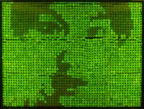
Living Portrait
GFPixel is a "painting" made of genetically transformed bacteria. The organisms are cultivated in about 4000 Petri-dishes that are arranged as a portrait. Like on digital screens part of the bacteria produce the green light – the Green Fluorescent Protein-gene is switched ON and in the other part the GFP-gene is switched OFF.
The works plays with the border between living world and the digital world, the portrait seems to be digital but it lives and dies during the exhibition. A work by Austrian media artist Gerfried Stocker and molecular biologist Reinhard Nestelbacher. More images (click "Gallerie und Details").
GPF Pixel can be seen at Medialab Madrid until April 2, as part of an exhibition of the most outstanding projects of digital culture which have won prizes in recent years at Ars Electronica in Linz, Austria. [blogged by Regine on we-make-money-not-art]
Posted by jo at 11:57 AM | Comments (0)
Internet Research 7.0: Call for Papers
![]()
INTERNET CONVERGENCES
IR 7.0: INTERNET CONVERGENCES: International and Interdisciplinary Conference of the Association of Internet Researchers, Brisbane, Australia--28-30 September 2006; Pre-Conference Workshops: 27 September 2006.
The Internet works as an arena of convergence. Physically dispersed and marginalized people (re)find themselves online for the sake of sustaining and extending community. International and interdisciplinary teams now collaborate in new ways. Diverse cultures engage one another via CMC. These technologies relocate and refocus capital, labor and immigration, and they open up new possibilities for political, potentially democratizing, forms of discourse. Moreover, these technologies themselves converge in multiple ways, e.g. in Internet-enabled mobile phones, in Internet-based telephony, and in computers themselves as "digital appliances" that conjoin communication and multiple media forms. These technologies also facilitate fragmentations with greater disparities between the information-haves and have-nots, between winners and losers in the shifting labor and capital markets, and between individuals and communities. Additionally these technologies facilitate information filtering that reinforces, rather than dialogically challenges, narrow and extreme views.
CALL FOR PAPERS
Our conference theme invites papers and presentations based on empirical research, theoretical analysis and everything in between that explore the multiple ways the Internet acts in both converging and fragmenting ways - physical, cultural, technological, political, social - on local, regional, and global scales.
Without limiting possible proposals, topics of interest include:
- Theoretical and practical models of the Internet
- Internet convergence, divergence and fragmentation
- Networked flows of information, capital, labor, etc.
- Migrations and diasporas online
- Identity, community and global communication
- Regulation and control (national and global)
- Internet-based development and other economic issues
- Digital art and aesthetics
- Games and gaming on the Internet
- The Net generation
- E-Sectors, e.g. e-health, e-education, e-business
We call for papers, panel proposals, and presentations from any discipline, methodology, and community that address the theme of Internet Convergence. We particularly call for innovative, exciting, and unexpected takes on and interrogations of the conference theme. However, we always welcome submissions on any topics that address social, cultural, political, economic, and/or aesthetic aspects of the Internet and related Internet technologies. We are equally interested in interdisciplinary proposals as well as proposals from within specific disciplines.
SUBMISSIONS
We seek proposals for several different kinds of contributions. We welcome proposals for traditional academic conference papers, but we also encourage proposals for creative or aesthetic presentations that are distinct from a traditional written 'paper'. We welcome proposals for roundtable sessions that will focus on discussion and interaction among conference delegates, and we also welcome organized panel proposals that present a coherent group of papers on a single theme.
This year AoIR will also be using an alternative presentation format in which a dozen or so participants who wish to present a very short overview of their work to stimulate debate will gather together in a plenary session involving short presentations (no more than 5 minutes) and extended discussion. All papers and presentations in this session will be reviewed in the normal manner. Further information will be available via the conference submission website.
- PAPERS (individual or multi-author) - submit abstract of 500-750 words
- SHORT PRESENTATIONS - submit abstract of 500-700 words
- CREATIVE OR AESTHETIC PRESENTATIONS - submit abstract of 500-750 words
- PANELS - submit a 250-500 word description of the panel theme (and abstracts of the distinct papers or presentations)
- ROUNDTABLE PROPOSALS - submit a 250-500 word statement indicating the nature of the roundtable discussion and interaction.
Papers, presentations and panels will be selected from the submitted proposals on the basis of multiple blind peer review, coordinated and overseen by the Program Chair. Each person is invited to submit a proposal for 1 paper or 1 presentation. People may also propose a panel of papers or presentations, of which their personal paper or presentation must be a part. You may submit an additional paper/presentation of which you are the co-author as long as you are not presenting twice. You may submit a roundtable proposal as well.
Detailed information about submission and review is available at the conference submission website http://conferences.aoir.org. All proposals must be submitted electronically through this site.
PUBLICATION OF PAPERS
All papers presented at the conference are eligible for publication in the Internet Research Annual, on the basis of competitive selection and review of full papers. Additionally, several publishing opportunities are expected to be available through journals, again based on peer-review of full papers. Details on the website.
GRADUATE STUDENTS
Graduate students are strongly encouraged to submit proposals. Any student paper is eligible for consideration for the AoIR graduate student award. Students wishing to be a candidate for the Student Award must also send a final paper by 31 July 2006.
PRE-CONFERENCE WORKSHOPS
Prior to the conference, there will be a limited number of pre-conference workshops which will provide participants with in-depth, hands-on and/or creative opportunities. We invite proposals for these pre-conference workshops. Local presenters are encouraged to propose workshops that will invite visiting researchers into their labs or studios or locales. Proposals should be no more than 1000 words, and should clearly outline the purpose, methodology, structure, costs, equipment and minimal attendance required, as well as explaining its relevance to the conference as a whole. Proposals will be accepted if they demonstrate that the workshop will add significantly to the overall program in terms of thematic depth, hands on experience, or local opportunities for scholarly or artistic connections. These proposals and all inquires regarding pre-conference proposals should be submitted as soon as possible to the Conference Chair and no later than 31 March 2006.
DEADLINES
Submission site available: 1 December 2005
Final date for proposal submission: 7 February 2006
Presenter notification: 21 March 2006
Final workshop submission deadline: 31 March 2006
Submission of paper for publication/student award: 31 July 2006
Submission of paper for conference archive: 30 September 2006
CONTACT INFORMATION
Program Chair: Dr Fay Sudweeks, Murdoch University, Australia,
sudweeks at murdoch.edu.au
Conference Chair: Dr Axel Bruns, Queensland University of Technology,
Australia, a.bruns at qut.edu.au
President of AoIR: Dr Matthew Allen, Curtin University of Technology,
Australia m.allen at curtin.edu.au
Association Website: http://www.aoir.org
Conference Website: http://conferences.aoir.org (from 1 December)
Dr Matthew Allen
Associate Professor Internet Studies
Associate Dean Teaching and Learning, Humanities
Curtin University of Technology, CRICOS 00301J Australia
m.allen at curtin.edu.au
http://smi.curtin.edu.au/netstudies/allen.htm
+61 8 92663511 (v) +61 8 9266 3166 (f)
President, Association of Internet Researchers http://www.aoir.org
Posted by jo at 10:11 AM | Comments (0)
First Monday, Special Issue #4:
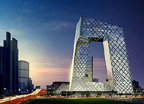
Urban Screens
Urban Screens: Discovering the Potential of Outdoor Screens for Urban Society, Pieter Boeder, Geert Lovink, Sabine Niederer, and Mirjam Struppek, eds. Table of Contents: Introduction: Discovering the potential of outdoor screens for urban society by Pieter Boeder and Mirjam Struppek; Urban screens: The beginning of a universal visual culture by Paul Martin Lester; The politics of public space in the media city by Scott McQuire; The poetics of urban media surfaces by Lev Manovich; Interpreting urban screens; by Anthony Auerbach; Story space: A theoretical grounding for the new urban annotation by Rekha Murthy; The urban incubator: (De)constructive (re)presentation of heterotopian spatiality and virtual image(ries) by Wael Salah Fahmi; Urban screens: Towards the convergence of architecture and audiovisual media by Tore Slaatta; Towards an integrated architectural media space by Ava Fatah gen. Schieck; Art and social displays in the branding of the city: Token screens or opportunities for difference? by Julia Nevárez; Hijacking the urban screen: Trends in outdoor advertising and predictions for the use of video art and urban screens by Raina Kumra; For an aesthetics of transmission by Giselle Beiguelman; Intelligent skin: Real virtual by Vera Bühlmann; Programming video art for urban screens in public space by Kate Taylor; Augmenting the City with Urban Screens by Florian Resatsch, Daniel Michelis, Corina Weber, and Thomas Schildhauer.
Introduction
Welcome, gentle reader, to this First Monday Urban Screens special issue, the first publication of its kind. With the advent of digital media, the global communication environment has changed dramatically. In the context of the rapidly evolving commercial information sphere of our cities, especially since the 1990s, a number of novel digital display technologies have been introduced into the urban landscape. This transformation has intersected with other major transformations of media technology and culture over the last two decades: the formation of distributed global networks and the emergence of mobile media platforms such as mobile phones. Their cumulative and synergistic impact has been profound. Convergence of screen technologies with digital communication technologies such as GSM, RFID, Internet and database technologies has lead to the emergence of a new, interactive and increasingly pervasive medium: Urban Screens.
Urban Screens can be defined as interactive, dynamic digital information displays in urban environments. Their genesis is the consequence of two parallel technological developments: evolution and subsequent growth in magnitude of the traditional display screen, and its subsequent convergence with other digital media technologies. Forms and appearances range from large daylight compatible LED billboards, plasma or SED screens, information displays in public transportation systems and electronic city information terminals to dynamic, intelligent surfaces that may be fully integrated into architectural façade structures. Their introduction in the urban environment poses new, unparalleled challenges and opportunities, which we will explore
and document in this issue.
Currently, the primary purpose of this new infrastructure appears to be the management and control of consumer behaviour through advertising. Commercial companies are starting to realise that digital billboards are a powerful medium to communicate their goals and missions, in line with the new paradigms of the digital economy. Interconnected Urban Screens have tremendous potential to serve as a platform for information exchange. Such large networks are already being developed Russia, China, USA and South America, where Urban Screens are rapidly becoming a key element in commercial and government informational infrastructure. The implications for the public sphere are profound. Information density per square metre is increasing, yet at the same time individuals have less control than ever over the actual format and content of that information.
Public space has always been a place for human interaction, a unique arena for the exchange of rituals and communication. Its architecture, being a storytelling medium itself, plays an important role in providing a stage for this interaction. The ways in which public space is inhabited can be read as a participatory process of its audience. Its (vanishing) role as a space for social and symbolic discourse has often been discussed in urban sociology. Modernisation, the growing independence of place and time and individualisation seem to devastate traditional city life and its social rhythm. The Urban Screens project explores the opportunities for opening this steadily growing infrastructure of digital screens, currently dominated by market forces, for cultural content, along with its potential for revitalising of the public sphere.
Urban Screens 2005 was the first international conference that was solely dedicated to the emerging Urban Screens phenomenon. Presentations covered a broad spectrum of topics and issues, ranging from critical theory to project experiences by researchers and practitioners in the field of art, architecture, urban studies and digital culture. It addressed the growing infrastructure of large digital moving displays, which increasingly influence and structure the visual sphere of our public spaces. Urban Screens 2005 investigated how the currently dominating commercial use of these screens can be broadened and culturally curated: can these screens become a tool to contribute to a lively urban society, involving its audience interactively?
A new medium that is digital, interactive and pervasive
What we are seeing is the emergence of a new medium that is digital, global and local, interactive and pervasive at the same time. What happens if the convergence of new technologies such as Internet, database and mobile technologies suddenly enable interactive access to the visual streaming of these digital surfaces? Can it revitalise the public sphere by creating an information-dense urban environment or is it a major threat? How does the growing infrastructure of digital displays influence the perception of the visual sphere of our public spaces? Metaphorically speaking, can or do Urban Screens already function as a mirror, reflecting the public sphere?
The Urban Screens project aims to address these questions in a transdisciplinary debate and present new approaches to answering the most pushing urgent questions, exchange experiences and create and maintain a thematical network around the subject for initiating future collaborations. The Urban Screens 2005 conference in Amsterdam addressed the existing commercial predetermination and explored the nuance between art, interventions and entertainment to stimulate a lively culture. Other key issues were mediated interaction, content, participation of the local community, possible restrictions due to technical limits, and the incorporation of screens in the architecture of our urban landscape.
Urban Screens 2006: Demonstrating the potential of public screens for interaction
Building upon the results of Urban Screens 2005, the 2006 Urban Screens 2006 conference (Berlin, October 5-6) will elaborate on the discussion and develop the broad spectrum of possible formats and usage of this emerging new media infrastructure. Urban Screens 2006 will be a platform for demonstrating the potential of public screens for interaction in a trinity of infrastructure, content and cooperation models. Interconnected topics will be the politics of public space, multimedia content as a service for an array of portable devices, urban neighbourhood reactivation, interaction design of urban screens, standardisation and integration in the urban landscape. Using existing screens infrastructure as well as future 'Urban Screens furniture' in the urban space of Berlin, we will demonstrate the impact of Urban Screens, their contextualisation and situatedness. This unique accumulation of projects will serve as a playground and research field for practical observations on the interplay of screen technology, content, location and format.
Urban Screens 2007: Expanding the potential of content for community
screens
Urban Screens 2007 is currently under preparation in collaboration with BBC Public Space Broadcasting. While Urban Screens 2006 will have 'brick & mortar' accents, Urban Screens 2007 will have a distinct focus on the potential of journalistic content: issues surrounding the production and display of media content for Urban Screens, as well as adaptive reuse of 'old' content for new media will be explored in detail. Key issues and topics will include Public Space Broadcasting (PSB), the politics of public space, mediated interaction and participation, as well as experiments with new participatory formats. PSB can energise the hearts of cities by bringing together communities to share events and broadcasts, creating public news and information points that double as local meeting places. Largely due to the innovative work of the BBC, PSB is starting to prove its potential to provide an outlet for community and educational activities, public service information, visual arts, digital innovation and local content production, revitalising the public sphere.
We hope that you will share our excitement.
Posted by jo at 09:09 AM | Comments (0)
MemoryMiner
![]()
Filling Historical Gaps
MemoryMiner is the first in a series of products by GroupSmarts, a company founded in December 2004 by John C. Fox, a recognized pioneer in the field of networked Digital Asset Management. The central idea behind MemoryMiner is a belief that the most interesting records of modern society and culture exist in analog form, "trapped" in boxes of old photos, letters and the like.
With this thought in mind, we hope that MemoryMiner will be widely used to bring these materials, and more importantly, the stories that can be told from them, into the networked, digital world. The long-term goal of MemoryMiner is the creation of a many-to-many marketplace for "Creative Commons" digital media that would allow people to exchange media elements in order to fill in gaps that they may have as they set about recording and publishing their personal histories.
"MemoryMiner is an extraordinary new program, a profound reinvention of the photo scrapbook. It's just out, but already it's a nuanced, way-smart program with a clean, inventive design. There's no better introduction to it than watching their short Quicktime demo—an absolute must. If you want to learn more, you can listen to an interview with MemoryMiner's, John Fox.
I have studied the history of photography for over 30 years now, and if this program continues to develop and finds its uses and users, I'm predicting that it will go down as a key transformative moment in the evolution of photography. It's a brilliant application of digital/database logic to photography as personal history and storytelling. I'm gettin' it."--John Schott, Ratchet Up
Posted by jo at 07:39 AM | Comments (0)
February 07, 2006
Networked Choreography

Realigning Hyperchoreographic Practice with Theory
"I've submitted a proposal to DTPA 2006 entitled 'Transcluded Composition; Realizing Hyperchoreography'. this paper is significant to me for two reasons; a) it is the product of my thinking on projective practise theory, and b) it marks a change in approach to my critical analysis of others work.
Whilst my views on the shortcomings of hyperchoreography are a matter of public record, I no longer wish to criticise without making a positive contribution. I do believe that the notion of hyperchoreography and its theoretical basis are sound, what I take issue with is the current implementation(s) [1] and supporting documentation [2]. I don't think that Miles' essay contextualises the practice with enough rigour whilst Popat & Smith-Autard's paper is significantly out of date (based on 1999 web technology). I've linked to Whyte's paper before, but whilst it is an excellent essay it doesn't support their practice. So, as part of developing my 'projective practice theory' I have written a paper that seeks to realign hyperchoreographic practice with its theory.
My feeling is that the present examples are asynchronous dance for camera. If the goal is "non-literal/ non-representational/ non-narrative" that preserves the dasein of human movement and its physical properties of weight, mass and un-enhanced physicality" then some deep level reimplementation is required. However, what I find interesting is that most of the solutions lie within Nelson's original concepts of hypertext. The key principles that hyperchoreography must adhere to are:
-transclusion
-multi directional linking
-user annotation.
-user contribution
If we can ensure that these principles are adhered to then McPherson and Fildes goal of populism, pluralism, unorthodoxy and universalism will follow. I believe that this realignment of theory and practice is achievable now ...
Drawing on existing implementations of Web 2.0 technologies such as 'Flickr' and 'Goolge Video' we will illustrate how hyperchoregraphic practice could be realigned with its theoretical basis. This re contextualised application will reveal the possibility of distributed choreographic collaboration and (concurrent) visual representation of motive intertexts. Using an example of the proposed interface we will show how the 'user' will not simply ... participant in the compositional process, but fully [be] responsible for the choreography.
I'll let you know what happens with the paper and post more details/content as I am able. Whatever happens I will also submit an essay to the hyperchoreography site that presents a deep contextualisation on the theoretical and practical issues involved.
[1] hyperchoreography works
[2] Writings about hyperchoreography
title of this entry with apologies to networked performance" [published by matt on splines in space]
Posted by jo at 11:42 AM | Comments (0)
WWMNA
We Need Money Not Art
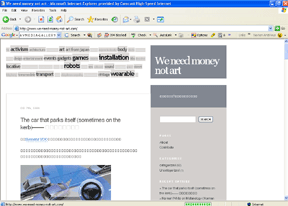
"...Chinese new media art afficionados ... are translating their favourite posts of we-make-money-not-art into Chinese on we-need-money-not-art. [wow! well done Regine!] [via Regine on we-make-money-not-art]
Posted by jo at 11:34 AM | Comments (0)
Compressionism
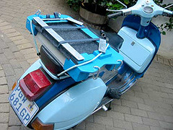
moCo (mobile Compressionism)
[image: This just makes me smile: ‘action Jackson’ (Compressionist scanner / appendage) strapped onto my bling bling of a bike, ready to hit Johannesburg, South Africa.]
Compressionism is a digital performance and analog archive. In the current studies, I compress bodies, spaces and objects by traversing their surfaces with an image scanner, along varying 3-dimensional paths - literally, I glide, run, hover and swoop across windows, trees, or lilies while the scanner head is in motion. The resulting digital images, which are transfigured down to the size of a small piece of paper, are then re-stretched to their original size, sometimes cropped or colorized. The final prints ask us to ‘look again’ at the relations between subjects, objects, actions and perceptions. [blogged by nathaniel on nathanielstern.com]
Posted by jo at 11:19 AM | Comments (0)
RC2|Relational Clothing + collecting fragments

Intervention by Johannesburg Artist Jose Ferreira
As covered by Carine Zaayman on Artthrob, the Very Real Time project launched its second phase at the Drill Hall (Point Blank Gallery, downtown Jozi) this past weekend, hosting, "Two panels of selected speakers… chaired by Gregg Smith and …an intervention by Johannesburg based artist, Jose Ferreira."
This work consists of a series of journeys and a garment. Appearing to be an ordinary overall, it unfolds and translates into various forms, provoking unusual relationships. It is at once a vessel for shelter, a protective unit, and gatherer of ephemera. …The focal point of the work is to extricate new readings of social interactions in this urban context that may have become accepted, habitual and even suspicious. The work is an exploration of urban survival, self-preservation, and a dreaming of possibilities. …My intention is to make a work that embraces the multiplicity of an urban Johannesburg experience. [blogged by nathaniel on nathanielstern.com]
RC2|Relational Clothing + collecting fragments
This work consists of a series of journeys and a garment. Appearing to be an ordinary overall, it unfolds and translates into various forms, provoking unusual relationships. It is at once a vessel for shelter, a protective unit, and gatherer of ephemera. A series of 'walks' through the downtown area of Johannesburg will act as a catalyst, and the user agent provocateur of new and exploratory relationships. The outfit is likely to highlight existing issues like patterns of social discord. The wearer will gather information in various forms, both physical and digital, 'embodying' an experience of the inner city. The focal point of the work is to extricate new readings of social interactions that may have become accepted and habitual. The work is an exploration of urban survival, self-preservation, and a dreaming of possibilities. The garment also has interesting references to its origins. During medieval times a one-piece garment was used by jesters and alchemists as a symbolic outfit which in their view, were aids to avoid disturbances in the flow of energy in the body.
This is a project that imagines technology as a parallel universe using desire rather than scientific quantification as a measure of fulfillment. Using these vectors of reference we are pondering questions like, is it possible to construct a prototype garment that would in itself become a living organism, an amalgamation of experience and live interconnected parts? Without being too preoccupied with the aesthetic associations of fashion the work articulates the relationship between the individual and a social body, and the eminent overlapping of the two. It seeks to articulate in particular a very simple ethical question, what is the nature of the distance between my body and the world?
The garment itself will look ordinary, with various 'functions' pervasively located within an exterior shell. The apparatuses on the garment are really a means to augment it with various loci of information - a way of capturing and interpreting data. The costume itself will function as an object with various different utilities, paraphernalia that is geared toward social provocation. The work also remains functional without any of the electronic components, even if the technology were to be shut down completely it would remain user friendly. Various components of the outfit will become more apparent or 'emerge' according to different situations. It will transform, unfold, adapt and reconfigure according to the situational constraints of various contexts, and become 'infected' by its surroundings. The work is essentially about potential, that existing between the individual and a larger social body, and the way one negotiates personal space within the broader collective of a society, community or group. Interaction with the immediate context will be the point of reference for the interventions, which will be in the vicinity of the Drill Hall. In that way it will function as a type of urban survival kit and social integration tool - an activator of real and imagined spaces.
There are examples where clothing has been used as a provocative agent like Lygia Clark's overtly political outfits criticising Brazilian authorities and censorship in the late sixties, to Laurie Anderson's performative apparel. In many cases, due to the bulky apparatuses of the times, the instruments were clearly visible within and without the garments. Today, with the advent of nano technology, much of this instrumentation has become stealthy, integrated in some form or another into the structure of the object. This work is about exploring possibilities in which those technologies can be used to interrogate notions of difference, and similarity, by looking at how people are constantly mapping out their existence in urban environments. The idea is to construct a garment that uses various devices embedded into its structure, to record, manipulate, and transmit information about that person and their surroundings. This information will not be entirely statistical but rather more ephemeral. It might for instance gather relational information about the proximity of other persons and buildings - perhaps an Auric Transmitter? Perhaps it will measure presence?
By looking into subtle variations in locality and behaviour it might be possible to map an individuals journey. How does it look/feel to experience someone else's journey as they walk through congested areas, isolated landscapes, in the proximity of others/buildings etc? What would a visual manifestation of this journey look like? How are the boundaries between people perpetuated, and how do they change in an urban environment where unconsidered situations are forced upon one another? How can the garment be used to create a space of seclusion allowing the subject immediate respite from their surroundings? Can it become a cipher associated with security, like a temporary safety net?
My intention is to make a work that embraces the multiplicity of an urban Johannesburg experience. In collating information that is ephemeral and open to multiple interpretations, I hope to engender a more imaginative, playful interpretation of that experience. The notion of venturing into possible contested spaces and coalescing the experience into other activities has an established history; activities like Capoeira for instance, manifest out of the frission stimulated by potential conflict - turning one activity, associated with aggression, into a more poetic form of expression.
RC2 is a work made possible through collaboration. This process has been facilitated by Strangelove, a fashion design duo that have worked on several projects. Tegan Bristow, an artist working in Digital media, has spent much of her time devising ways in which the digital components might function. And Dorothee Kreutzfeldt who has put immense energy into curating the event.
Posted by jo at 11:01 AM | Comments (0)
I/O
![]()
Inbox/Outbox Call for Participation
Inbox/Outbox is an e-mail institution operating and establishing connections between virtual and real public spheres as a means to propelling public access. Characterized by its temporary function as an agent, I/O avoids institutional incorporation of its subjects, thus removing itself from the final context, as well as allowing internal institutions and contexts to occur. I/O is based on a division into two binary functions, Inbox and Outbox, Inbox being the receiver of virtual data, which in turn is processed by Outbox and "forwarded" to public spaces.
Inbox/Outbox is currently channelling its activities through Centrifug, an exhibition space within Konsthall C in Stockholm, Sweden. The selection of exhibitions at Centrifug is based on a public booking list, released once every year. The Inbox/Outbox exhibition period is February 22nd - March 5th. I/O is for this occasion calling for participation. Admission will not be limited in any way, neither by amount of data, number of participants nor by any other criteria for selection, given the condition that submitted content doesn't infringe upon laws or regulations.
Submitted data must be suited for printing onto plain (A4) paper or for writing to audio-CD. Deadline is set for February 20th. Submit your data to inbox[at]inboxoutbox.org
Posted by jo at 10:36 AM | Comments (0)
un_wiki
Democracy or Oligarchy
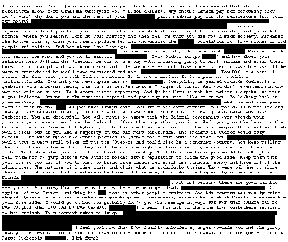
un_wiki, by Wayne Clements, gets quotes from Wikipedia the free encyclopedia’s Deletion Log: http://en.wikipedia.org/w/index.php?title=Special:Log&type=delete. The Deletion Log is a list of all the pages that have abused Wiki's democratic remit; it is the last stop on the way to destruction. It has small amounts of the offending texts. Clements uses a Perl script to get them and throw away the rest.
un_wiki explores the antagonism between formal democracy (anyone may edit a page) and actual oligarchy (sysadmins may delete or revert a page). [via Loreto Martin]
Posted by jo at 08:50 AM | Comments (0)
Statement of Purpose
Experiment in Art and Technology
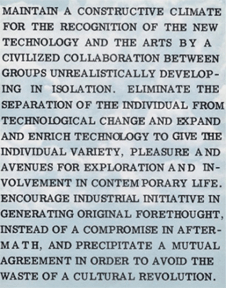
[image: Statement of purpose, Experiment in Art and Technology, (New York, United States), 1967. E.A.T. aims drafted by Billy Klüver and Robert Rauschenberg. via Daniel Langlois Foundation]
See 9 Evenings and Experiments in Art and Technology: a gap to fill in art history's recent chronicles, by Sylvie Lacerte, delivered at REFRESH! The First International Conference on the Histories of Media Art, Science and Technology, held at the Banff New Media Institute from September 28 to October 3, 2005. Following her in-depth research into the many activities conducted by EAT to support artists in their experiments with technology in the 1960's and 1970's, Ms. Lacerte asks why the chronicles of this groundbreaking organisation have been largely overlooked by the majority of works that examine art history of the past four decades. In her text, she offers a few hypothesis to help explain this mystery.
Posted by jo at 08:35 AM | Comments (0)
Siemens launches "Kick Real" cameraphone game

Physical Interface/AR for Mobile Phone Games
"With World Cup fever sweeping Germany (or at least sweeping the tournament's sponsors), Siemens has come up with a novel way for cellphone users to practice their kicks (which we think is at least a little ironic, given that Siemens doesn't even make cellphones anymore). The company's "Kick Real" game provides cameraphone users with a virtual soccer field; point the camera at your foot, and you can kick a virtual ball that you view on the phone's LCD. We can't wait for this to catch on, so we can get our own kicks watching gamers staring into their phones and kicking the air." [blogged by Kellee USC Interactive Media Division Weblog]
Posted by jo at 08:15 AM | Comments (0)
February 06, 2006
Making the Virtual Real
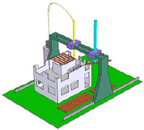
reBang(ing) via 3D Printers
As we move into the fabrication future, we'll see a surprising cross-over between the skills of virtual world designers and the skills of designers of physical objects.
We're all familiar by now with the idea of real money being used to buy virtual goods, and even with virtual money being used to buy physical goods. The intersection of online worlds and the real world doesn't stop there, however. It turns out that the increasing detail of 3D objects in virtual environments makes it possible to think of them not simply as game objects, but as digital prototypes -- and 3D printers are the tool of choice for turning the prototypes into real objects. WorldChanging ally Csven Johnson is at the forefront of this movement. On his blog reBang, he discusses his efforts to convert the game data for objects into CAD data usable with rapid prototyping hardware.
The metaverse is not just an ethereal “storyteller’s” world. It’s a world comprised of data. Just look at the reasons Marketing people are salivating over it. The tracking data is orders of magnitude better than trying to count eyeballs watching a television screen. And in a 3D interface (which is what those videogames really are), that data goes well beyond just “hits” or “click-throughs”- it’s comprised of “vectors” and “3D positional data”. And here’s the important part: that data can be converted into more than just marketing statistics. It can be converted into real product; something you can hold… in the flesh. The Story made Real.
The image above [At left here -- Jamais] is a screen capture from Pro/ENGINEER CAD, perhaps the most widely used product development 3D application for design and manufacturing. That object is a piece of a virtual game object “captured” from id’s Quake 3 videogame (the barrel of a Rocket Launcher). It was not created in my CAD application. It was not ripped from the game files. I “hijacked” the data streaming to my monitor using a freely available tool. And now, if I desired, I could manipulate the data and create a real product...
...Don't get tripped up by the example being a "rocket launcher" that wouldn't work in the real world. The tools for creating virtual objects in or for games have become startlingly sophisticated, while in many cases becoming much easier to use. Some games, like Second Life, allow players to craft complex goods, from weapons to furniture to clothing, as well as design buildings. A home 3D printer of the near future may not be able to (or allowed to) print out a working gun -- and I would expect few people would complain about that -- but it almost certainly would be able to print out a chair, and probably be able to print out some kinds of clothing... [Posted by Jamais Cascio on WorldChanging]
Related:

OGLE and the Second Life Avatar
Having played with the OGLE tool for a few days (version 1b), I’ve learned some things that might be helpful to those hoping to have their customized Second Life avatars or objects fabricated. My own goal is to take the avatar geometry and convert it to “solid” CAD data, but the process I’m using to get there might be useful even if your goal is to just send out an .obj or .stl polymesh file.
First off, be aware that the captured videostream data most likely isn’t “clean”… even if it looks good. Be sure to search for duplicate triangles/polymeshes since there will probably be plenty. After deleting any duplicates, be sure to select and “merge” all the remaining polygon edges and vertices since there will almost certainly be multiples of those as well... [blogged by Csven Johnson on reBang]
Posted by jo at 03:55 PM | Comments (0)
CFP - Mobile Communication Research Annual
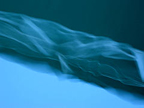
The Reconstruction of Space & Time through Mobile Communication Practices
Transaction books and their series on Mobile communication announces: The Mobile Communication Research Annual: Volume I, The Reconstruction of Space & Time through Mobile Communication Practices. Rich Ling and Scott Campbell (eds.) We seek the best and most interesting examples of relevant scholarship for our first volume of a projected series on the topic of mobile communication research.
The proliferation of wireless and mobile communication technologies gives rise to important changes in how people experience space and time. These changes may be seen in many realms of social life, such as the transformation of public into private space and vice versa, the blurring of lines demarcating work and personal life, and new patterns of coordination and social networks. Recent scholarship has tried to make sense of these changes in space and time. For example, Manuel Castells argues that advances in telecommunications have contributed to new spatio-temporal forms, which he describes as "the space of flows" and "timeless time." According to Castells, these new forms mark a shift in the importance of the meaning of a place to the patterns of the de-sequenced, networked interactions that occur in that place.
The purpose of this special issue is to continue and deepen the dialog on how space and time change as a result of the lower threshold for interaction due to mobile communication technologies.
Abstracts of 200 words describing the proposed papers are due by 17 March 2006 with those accepted due in final form by 1 September 2006. Submissions may be in the form of empirical research studies or theory-building papers and should be 5 - 7000 words (in English). Papers are preferably new work but if material from other venues is available it will also be considered for publication. Send your abstract to either Rich Ling or Scott Campbell.
About the editors:
Rich Ling (richard-seyler.ling[at]telenor.com) is a sociologist at Telenor's research institute located near Oslo, Norway and he has also been the Pohs visiting professor of communication studies at the University of Michigan. He is the author of the recently published book on the social consequences of mobile telephony entitled The Mobile Connection: The cell phone's impact on society and along with Per E. Pederson the editor of the book Mobile Communications: Renegotiation of the Social Sphere. He received his Ph.D. in sociology from the University of Colorado, Boulder in his native US. Upon completion of his doctorate, he taught at the University of Wyoming before coming to Norway on a Marshall Foundation grant. For the past ten years, he has worked at Telenor R&D and has been active in researching issues associated with new information communication technology and society with a particular focus on mobile telephony. He has led projects in Norway and participated in projects at the European level.
Scott Campbell (swcamp[at]umich.edu) is Assistant Professor and Pohs Fellow of Telecommunications in the Department of Communication Studies at the University of Michigan. His research explores the social implications of new media, with an emphasis on mobile communication practices. His recent studies have investigated cross-cultural trends, mobile phone use in social networks, and use of the technology in public settings. Scott's research has appeared / is forthcoming in Communication Monographs, Journal of Applied Communication Research, Communication Education, New Media & Society, Communication Research Reports, Qualitative Research Reports in Communication, and other scholarly venues. Prior to joining the University of Michigan in 2005, he worked in the US wireless industry, earned a Ph.D. from the University of Kansas, and spent three years teaching and conducting research at Hawaii Pacific University on the Hawaiian island of Oahu.
About the series editor:
James E. Katz is the director of the Center for Mobile Communication Studies at Rutgers University and author of Magic in the Air (Transaction, 2006). His edited or co-edited books include Perpetual Contact (with Mark Aakhus), Machines that Become Us, and Mediating the Human Body (with Leopoldina Fortunati and Raimonda Riccini). His next edited book, tentatively titled Mainstreaming mobiles: Wireless Communication and Social Change in a Global Context, will be published by MIT Press.
About the publisher:
Transaction Publishers, a leading independent publisher of social scientific books, periodicals and serials, is undertaking a new series of books on mobile communication. Transaction's mission is scholarly and professional inquiry into the nature of society. Located on the campus of Rutgers University in Piscataway, New Jersey, Transaction Publishers is dedicated to the expansion of the social sciences and is committed to the enhancement of public, professional and scholarly awareness by reaching the widest possible audience for work done by researchers.
Editorial board
Ken Anderson Intel corporation, US
Naomi Baron American University, US
Manual Castells Annenberg Center, University of Southern California, US/Spain
Akiba Cohen Tel Aviv University, Israel
Nicola Doering Ilmenau University of technology, Germany
Jonathan Donner Microsoft Research - Bangalore, India/US
Gerard Goggin University of Sydney, Australia
Nicola Green University of Surrey, UK
Leslie Haddon University of Essex, UK
Keith Hampton Annenberg School, University of Pennsylvania, US
Joachim Höflich Erfurt University, Germany
Mizuko Ito Annenberg Center, University of Southern California, US/Japan
Shin Dong Kim Hallym University, Republic of Korea
Ilpo Koskinen University of Art and Design, Helsinki, Finland
Patrick Law The Hong Kong Polytechnic University, Hong Kong
Christian Licoppe Ecole Nationale Superieure des Telecommunications, France
Sonia Livingstone London School of Economics, UK
Steve Love Brunel University, UK
Kristóf Nyíri Hungarian Academy of Sciences, Hungary
Leysia Palen University of Colorado, US
Raul Pertierra University of the Philippines, Philippines
Madanmohan Rao Indian Institute of Information Technology, Bangalore, India
Anxo Roibas University of Brighton, UK/Italy
Harmeet Sawhney Indiana University, US
Gitte Stald University of Copenhagen, Denmark
Hidenori Tomita Bukkyo University, Japan
Jane Vincent University of Surrey, UK
Barry Wellman University of Toronto, Canada
Peter B. White La Trobe University, Australia
[blogged by Ganaele Langlois on MDCN]
Posted by jo at 03:00 PM | Comments (0)
From Interaction to Participation:
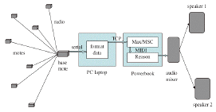
Configuring Space through Embodied Interaction
"Abstract: When computation moves off the desktop, how will it transform the new spaces that it comes to occupy? How will people encounter and understand these spaces, and how will they interact with each other through the augmented capabilities of such spaces? We have been exploring these questions through a prototype system in which augmented objects are used to control a complex audio 'soundscape.' The system involves a range of objects distributed through a space, supporting simultaneous use by many participants. We have deployed this system at a number of settings in which groups of people have explored it collaboratively. Our initial explorations of the use of this system reveal a number of important considerations for how we design for the interrelationships between people, objects, and spaces." From From Interaction to Participation: Configuring Space through Embodied Interaction by Amanda Williams, Eric Kabisch, and Paul Dourish.
"This paper addresses this very important question: how will ubiquitous computing transform the new spaces that it comes to occupy; or what sorts of impacts on space result when it is populated by ubicomp technologies? The paper starts by describing how space and social action are tightly entwined. Then they examine the development and evaluation of a collective dynamic audio installation called SignalPlay (a series of physical objects with embedded computational properties collectively control a dynamic “sound-scape” which responds to the orientation, configuration, and movement of the component objects).
Some excerpts of this insightful paper:
Our fundamental concern is with the ways in which we encounter space not simply as a container for our actions, but as a setting within which we act. The embodied nature of activity is an issue for a range of technologies.
(…)
This social character means that spaces are not “given”; they are the products of active processes of interpretation. The meaningfulness of space is a consequence of our encounters with it. For ubiquitous computing, this is an important consideration. (…) The research challenge, then, is to understand how it is that computationally augmented spaces will be legible; with how people will be able to understand them and act within them..." [blogged by nicolas on pasta and vinegar]
Posted by jo at 02:49 PM | Comments (0)
International Symposium on Curating New Media Art

Art-Place-Technology
Art-Place-Technology, Liverpool: International Symposium on Curating New Media Art, 30 March - 1 April 2006.
Art-Place-Technology will look at historical and current projects by some of the world's leading curators of new media art, and discuss how curating new media art creates interfaces with the art world, museum culture, media, publishing and academia. New media art is a global phenomenon: a rapidly changing and dynamic field of creative practice which crosses conventional categories and disciplinary boundaries, challenging our assumptions about art.
How do curators engage with new media art? What makes a good curator of new media art? What can we learn from the pioneers of this field? What does the future hold for curating new media art? What common ground exists with other disciplines? These and other issues will be explored at Art-Place-Technology.
Speakers include figures who are shaping the practice and theory of curating new media art, including:
Inke Arns, Artistic Director, Hartware MedienKunstVerein, Dortmund.
Sarah Cook, Curator and Co-editor, CRUMB, University of Sunderland
Paul Domela, Deputy Chief Executive, Liverpool Biennial
Lina Dzuverovic, Director, Electra, London
Charlie Gere, Reader in New Media Research, Lancaster University
Beryl Graham, Curator and Co-editor, CRUMB, University of Sunderland
Ceri Hand, Director of Exhibitions, FACT, Liverpool
Drew Hemment, Director, Futuresonic, Manchester
Kathy Rae Huffman, Director of Visual Arts, Cornerhouse, Manchester
Stephen Kovats, International Programs Developer, V2, Rotterdam
Amanda McDonald Crowley, Director, Eyebeam Art & Technology Center, New
York
Francis McKee, Head of Digital Arts & New Media, CCA, Glasgow
Alfred Rotert, Co-director, European Media Art Festival, Osnabrück
Trebor Scholz, Institute for Distributed Creativity, New York
Dimitrina Sevova & Alain Kessi, codeflow, Zurich
Paul Sullivan, Director, Static Gallery, Liverpool
Simon Worthington, Mute, London
Further programme details and registration:
http://www.art-place-technology.org
Tel +44 (0)151 2315190
E-mail APT[at]ljmu.ac.uk
Art-Place-Technology is hosted by the Liverpool School of Art & Design, Liverpool John Moores University in collaboration with FACT and Art Research Communication.
Supported by Arts Council England North West, Media Arts Network.
Art Research Communication
newsletter[at]a-r-c.org.uk
www.a-r-c.org.uk
Posted by jo at 02:20 PM | Comments (0)
EXCESS
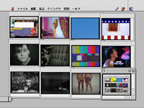
Images and Bodies in Times of Excess
EXCESS: images and bodies in times of excess--February 12 to May 21, 2006, Z33, Zuivelmarkt 33, B-3500 Hasselt.
...We are inundated by [images], from the newspapers in the early morning to the late-night news on television. Or is that just how it feels? Are we being blinded by a surfeit of images or a lack of them? Do we see the same images too often and is there a need for greater diversity? Perhaps we have to conclude that there are never enough images for a correct representation of reality.
These questions and others link EXCESS to Jean-Luc Godard's ‘Histoire(s) du Cinéma'. This film history, which is also a history of the 20th century, pays as much attention to the films that were not made as to those that were. EXCESS intends to transpose this comprehensive project to the digital era. Which images do we see (or see too much) and which do we not (or too little)? And another important point: how do we react to these pictures? What feeling arises amongst all these pictures?
A search for the pictures behind the reality isinevitably also about the reality behind the pictures. It is a visual experience, but certainly a physical one too – a confrontation with the pictures and with the body with which we view them. This makes each image different for everybody. In agreement with Godard, we can already conclude that this exhibition will not present the right image, just an image: “pas une image juste, juste une image”.
Works by Sergei Bugaev Afrika, Saed Andoni, Herman Asselberghs, Heather & Patrick Burnett-Rose, Lieven De Boeck, Harun Farocki & Andrei Ujica, Kendell Geers, Jean-Luc Godard, Felix Gonzalez-Torres, Sagi Groner, Thomas Köner, Kuda.org, Teresa Margolles, Renzo Martens, Alice Miceli, Christof Migone, Rob Moonen & Olaf Arndt, Steve Mumford, Els Opsomer, OVNI, Dierk Schmidt, Alexander Sokurov, Terre Thaemlitz, Pierre-Yves Vandeweerd, Geert Van Moorter exhibition design Ann Clicteur curator Pieter Van Bogaert.
Posted by jo at 12:55 PM | Comments (0)
Patrick Lichty
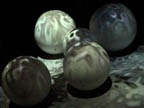
Building a Culture of Ubiquity
"...In my body of research vis-à-vis the shift in praxis from the screen to the palm to the body to the space, there are issues of representation that are revealed through the way that aesthetic content is embodied through the interface. This interface may be a screen, dataglove, head-mounted display or responsive space, but each mode of representation illustrated by each display or input device indicates a unique space of interaction and expression, whether on the screen body, or reinscribed in space itself. As we consider the arc of praxis from screen to body to space, perhaps this may create some insight into how a culture of technological ubiquity will be constructed, and what modes of expression may emerge from such cultural forms and technological developments...
...The catalyzing forces behind this cultural shift are connectivity between individuals and decentralized distribution of communication and content. These factors underlie the creation of the electronic culture, and are essential to the work described here. But, as this portion of humanity moves towards a culture of ubiquity, there are a series of localities that may serve as points of analysis for the communications of cultural codes. Each (the screen, palm/pocket, body, and public space) has unique modes of representation that allude to Hayles' linkage of the subject between its signification and the embodiment of experience [6]. All of these localities make visible systems of production, consumption, and representation that illustrate a possible ecology of signs within a culture of ubiquity." From Building a Culture of Ubiquity by Patrick Lichty
Posted by jo at 12:24 PM | Comments (0)
Workshop on Generating Collaborative Research in the Ethical Design of Surveillance Infrastructures:
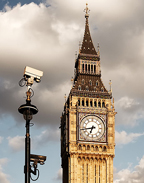
OPEN CALL FOR PARTICIPATION
Workshop on Generating Collaborative Research in the Ethical Design of Surveillance Infrastructures: June 8-11, 2006; Austin, Texas.
Surveillance may be understood as a set of processes of identification, tracking, analysis and response which organize social knowledge, social relations, and social power. Surveillance mediates everyday life. For example, internet "cookies," shopping loyalty cards, and mobile phone numbers all individuate and identify us. These identifiers are used to index databases recording our web surfing activities, our purchases, and our movements. The databases are subjected to statistical analysis in order to produce knowledge of demographic categories, typical patterns, or suspect behavior. This knowledge is then applied back to individuals in the population in order to assign each to a particular niche market or risk group, and to act toward them accordingly. Thus, through surveillance, knowledge is created, categories and types are produced, individuals are assigned social identities, and actions are taken that articulate those identities within a larger social order.
These surveillance practices are themselves shaped by overlapping and intertwined technical systems, laws, institutional configurations, and cultural understandings. This "infrastructure" of surveillance supports patterns of access to the resources of knowledge production, social visibility, and social position.
In June 2006 a three-day workshop will be held in Austin, Texas. The purpose of the meeting is to generate collaborative research projects exploring further
=the social implications of surveillance practice,
=the technological, legal, economic, and cultural infrastructures that shape surveillance practice, and
=possible technological, legal, economic, or cultural interventions to reshape those infrastructures to desired ends.
The workshop will address this issue in the context of the following themes:
=If surveillance mediates the production of categories and types of people, how can surveillance infrastructures be shaped to permit individuals, and groups of individuals, to coalesce around a particular identity?
=How can surveillance infrastructures mediate the ability of groups and individuals to “perform” certain identities within certain contexts?
=How can surveillance infrastructures mediate the ability of subcultures to generate and sustain knowledge of and for themselves?
=How can surveillance resources be appropriately allocated to ensure that groups of many scales (the family, the subculture, the nation) are able to defend, protect, and nurture their own (perhaps conflicting) interests?
We seek participants whose interests and expertise complement and expand upon each other’s work in social theory, information system design, business, and public policy, and who will be able to address issues such as:
=the application of legal paradigms other than privacy to practices of information collection. We are particularly interested explorations of legal theories of cultural rights and information commons.
=the application of novel information processing techniques, including, but not limited to, pseudonymity, digital rights management, and cluster analysis.
=the application of social theories of identity, including queer theory and performance studies.
=the intersection of market interests with ethical surveillance practice.
The workshop is intended to provide the initial venue for the production of fundable, collaborative, cross-disciplinary research proposals. Participants will be expected to prepare a position paper for distribution one month prior to the meeting. At the workshop itself, we will identify synergistic interactions of expertise, fruitful research directions, and possible sources of funding. After the workshop, participants will be eligible to apply for seed money grants to complete collaborative grant proposals to pursue those projects. Participants will also be invited to contribute to an edited volume.
The project will provide meals and accommodation for workshop participants, and will reimburse reasonable travel costs. Please include a quote of lowest available airfare in your application. Participants from outside the U.S. are especially encouraged to apply.
Potential participants should submit (to djp[at]mail.utexas.edu) proposals consisting of two parts:
(1) a 750-1000 word abstract, describing your area of research, its relevance to the conference topic, and a proposed presentation. The abstract should directly address a collaborative element – a cross-disciplinary or cross-professional alignment that would further the presenter’s research goal.
(2) a one-page biography or curriculum vitae, listing your relevant publications and experience.
The deadline for proposals is March 1, 2006. Participants will be selected by March 20, 2006.
For more information, please contact David Phillips (djp[at]mail.utexas.edu).
This project is supported by the National Science Foundation under grant #0551532 and by the University of Texas College of Communication and Department of Radio-Television-Film.
Posted by jo at 11:35 AM | Comments (0)
Vectors 2.0
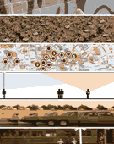
Thoughtful Transmissions
There are a handful of digital art and culture journals currently accessible online. A few of them occasionally pair critical texts with thematic volumes of interactive projects. Since its launch in the Winter of 2005, the web-based academic journal Vectors has explored the possibilities of combining audio-visual interactivity and analytical writings. The publication's USC-based editorial/creative team, consisting of new media theorists and practitioners Tara McPherson, Steve Anderson, Raegan Kelly, Eric Loyer, and Craig Dietrich, have recently released their second issue, titled 'Mobility.' The journal provides a multifaceted look at this concept, from David Lloyd's projection of 19th Century Irish migrant workers, in 'Mobile Figures,' to Todd Presner's 'Hypermedia Berlin,' a layered mapping of the city through historical and subjective filters. Other contributions, such as Lisa Lynch and Elena Razlogova's 'The Guantanomobile Project' and Julian Bleeker's 'WiFi.Bedouin,' tackle mobility within the politicized contexts of global information access. But unlike many of its academic journal relatives, Vectors turns new media in on itself, where the critical potential of the form isn't left to mere descriptions. - Ryan Griffis, Net Art News, Rhizome.
Posted by jo at 11:26 AM | Comments (0)
Floating Points 3: Ubiquitous Computing
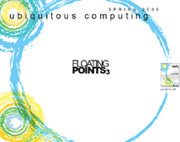
Panel 1: Responsive Environments and Systems
DATE: February 8th, 7:00 p.m.
PLACE: Emerson College, Bill Bordy Theatre, 216 Tremont Street, Boston, and LIVE ONLINE
Panelists: Mark Goulthorpe, Susan Kozel and Chris Salter
Moderator: Helen Thorington
Co-presented by Emerson College and Turbulence.org
Emerson College and New Radio and Performing Arts, Inc./Turbulence.org announce a new speaker series, Floating Points 3 [FP3] that will address the subject of "Ubiquitous Computing" or "Ubicomp", where computing and wireless capabilities are so integrated into the fabric of everyday life (clothing, cars, homes, and offices) that the technologies recede into the background and become indistinguishable from everyday activities.
Mark Goulthorpe: In 1991, architect Mark Goulthorpe established the dECOi atelier to undertake a series of largely theoretical architectural competitions. Today, dECOi is an established architectural/design practice that takes a fresh, exploratory approach to design. Goulthorpe will discuss his interactive Aegis Hyposurface which dynamically mediates events happening inside and outside of buildings. Goulthorpe currently divides his time between the School of Architecture and the Media Lab at MIT.
Susan Kozel is a dancer, choreographer, writer and Associate Professor at the School of Interactive Arts and Technology (SIAT) at Simon Fraser University in Canada. Kozel has a PhD in Philosophy and is co-founder of Mesh Performance Practices. Her research combines a broad range of interactive and responsive systems with performative practices (telematics, motion capture, sensing, wearables). All of her work is about exploring and expanding our physical and creative interface with technology. She will discuss her current project "other stories" which utilizes the Vicon motion capture system. http://www.meshperformance.org/
Chris Salter is a media artist, director and composer based in Montreal, Canada and Berlin, Germany. He develops and produces large-scale, multi-media and interactive environments that merge space, vision and sound. These environments respond in complex and subtle ways to audience presence and activities. He is also a professor in the Design and Computation Department at Concordia University. He will discuss his large scale installation "Suspension/Threshold." http://www.sponge.org/
Helen Thorington is co-director of New Radio and Performing Arts, Inc. /Turbulence.org
Floating Points is co-presented by Emerson College and New Radio and Performing Arts, Inc. (NRPA), a not-for-profit media organization with offices in Boston and New York. It is funded by Emerson College's Office of Academic Affairs, Institute for Liberal Arts and Interdisciplinary Studies, School of the Arts, and Department of Visual and Media Arts.
[Related >>
Posted by jo at 10:09 AM | Comments (0)
February 03, 2006
Helen Thorington
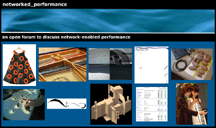
Music, Sound and the Networked Performance Blog
"...The concept of the "new" that most of us carry with us is one in which something that has existed (the old) is replaced with something that has come into existence only recently. It's a sort of "either-or" model. Digital media, however, are about intermingling and fusion. They are about "both-and". As a colleague recently remarked, the overlapping of differences [and similarities] that Digital Media allow [makes for] a staggering hybridity of not only art forms but of just about everything amenable to the digital…This activity, however, creates its own ruptures, its own "newness" and unrecognizables.
Is this new? Well yes and no. Anyone familiar with the work of Dick Higgens will remember that while he did not use the word "hybrid," he did identify "fusion," not only as a basic hunger in us all, but as a characteristic of the new arts of his time: He spoke of happenings, for instance, as a three-way fusion between theater, music and visual art. He suggested that "… art performances, so prevalent just now," might be a five way fusion, between theater, literature, music, visual art, and life?"" From Music, Sound and the Networked_Performance Blog [PDF] by Helen Thorington.
Posted by jo at 11:29 AM | Comments (0)
Helping Hands

Artists Burnish RFID's Image
In Artists Burnish RFID's Image, Mark Baard conjures RFID as rather complex social and cultural assemblages:
"[A]rtists in the United States and Europe are adding RFID to their palettes as well. They're drawing hip crowds as well as the attention of the RFID industry, which hopes to gain some good publicity for its controversial tracking technology. 'There is a lot of public aversion to RFID because of privacy issues,' said Paul Stam de Jonge, global RFID solutions director at LogicaCMG, a large European technology services company. 'And anything that will bring to it a more positive attitude will be beneficial.' [...]
The RFID industry seems to be cautiously reaching out to artists. The trade publication RFID Journal recently invited artists from the RFID-Lab in The Hague to its European industry conference last fall...'It was quite remarkable to have been invited to this rather closed and expensive conference for executives,' said RFID-Lab organizer Pawel Pokutycki.
Accenture Technology Labs senior manager Dadong Wan said he's pleased the artists are drawing positive attention to RFID. 'Artists definitely have a role in facilitating and accelerating the technology by raising (the public's) awareness,' Wong said."
The inter-dependence of artists and technology industries is clear, but the politics and ethics perhaps less so. While not wanting to ignore the history of net-art and critical internet culture, it seems to me that wireless art is offering a special challenge to traditional leftist critique-at-a-distance.
By actively and explicitly embracing their inevitable interconnectedness, both artists and corporations are able to achieve things that are not possible if either resists or retreats from the other. This sense of communal exchange need not imply collusion or assimilation - although both are, of course, possible - and it need not imply consensus either. Convergence alone is politically and ethically worthwhile.
But "public awareness" is a funny thing, not at all homogenous or equal, and certainly not to be confused with "consciousness raising". [blogged by Anne on Purse Lips Square Jaw]
Posted by jo at 11:16 AM | Comments (0)
Exchange 2006
LOOKING FOR VENUES TO HOST AN EXCHANGE EVENT
For More Information: PDF; Word.doc
Exchange 2006 (blogged here yesterday) is a cross-border art performance combining surveillance technology, a full-size transport truck, and all Nancy Nisbet's personal belongings. The project launches in Vancouver, Canada on May 1, 2006. "In this sustained performance, my belongings are inventoried, ID tagged and freely traded with individuals encountered during a six month road-trip circumnavigating Canada, the United States and Mexico. Using cultural resistance, this art project unsettles relationships between international politics, technological surveillance, and identity construction.
"Exchange Events" are fully contained, coordinated and collaborative events with galleries and other institutions/venues along the trip route. The performance takes place directly out of a full size 18-wheel transport truck. The event is intended to be like an "opening / swapmeet". I am looking for venues that can provide space to park the transport truck, local event announcements, and some assistance during the event. I am available to speak about the project and related issues if desired."
EXCHANGE Route Cities and Dates (some flexibility). NB. Route and dates are only scheduled until Mid-August (Miami) at this time. The Mexican and West US coast portions of the trip will be scheduled in March, 2006.
Vancouver, BC, May 1
Kamloops, BC, May 2
Edmonton, AB, May 5
Calgary, AB, May 8
Medicine Hat, AB, May 10
Swift Current, SK, May 11
Saskatoon, SK, May 12
Regina, SK, May 15
Brandon, MN, May 17
Winnipeg, May 18
Minneapolis, MN, May 23
Madison, WI, May 25
Chicago, IL, May 29
Cleveland, OH, June 1
Buffalo, NY, June 2
Toronto, ON, June 4
Ottawa, ON, June 6
Montreal, QC, June 9
Quebec City, QC, June 13
Fredricton, NB, June 17
Moncton, NB, June 18
Halifax, NS, June 19
St. John, NB, June 2
Portsmouth, NH, June 28
Boston, MA, June 29
Providence, RI, July 3
New Haven, CT, July 4
New York, NY, July 5
Philadelphia, July 8
Baltimore, MD, July 10
Washington DC, July 12
Wilmington, NC, July 18
Charleston, SC, July 19
Augusta, GA, July 21
Savannah, GA, July 24
Jacksonville, FL, July 26
Daytona Beach, FL, July 28
Orlando, FL, July 30
Miami, FL, August 5
Posted by jo at 09:42 AM | Comments (0)
[iDC] The Social Machine of Events

We Don't Need Event Divas!!
Event organizing. Over the past year many experiments with conferencing formats took place. They were aimed at escaping the same old predicaments. People are fed up with the orthodoxy of traditional, hierarchical proceedings of keynote speakers, panels, and unconcentrated topical orientation! There is the soporific style of delivering a 30-page paper to an audience that could have read this text online beforehand. Paperism! There is the work-shy re-inscription of yet the same players of the virtual intelligentsia over and over again! Peeps and masters! Why look at proposals of the "young nothings" if we can have trophy names to pull people into the touristy event spectacle? The big names are all that matters, never mind if it is just another check off on someone's resume.
Who cares if they have nothing to say. And let's just safely assume that people in the audience (stashed away in the deep dark of the auditorium) cannot possibly be experts at what the well-lid pundits on stage talk about. Who cares if that speaker is a good speaker as long as she comes from a long-established group of colleges? All that matters is splashy, energetic performativity of ideas. "Performances are judged in terms of their "felicity," that is, rather in terms of rules and styles than of meanings." (Ludwig Pfeiffer) Who cares about meaning?
Curators visualize their networks. Events become similar to an edited book or a mailing list. They are the spatialization of a social network. That is why it is important to have a small group of curators being in charge of an event rather than a single individual. After the event participants will mostly write glaring summaries not to mess up the chance of getting invited again. But to what extent does that help in the evolution of new media discourse and the development of event-based practice? Let's stop the sing-along choir! Have a walk on the dark side. (Who are the Darth Vaders of new media?) Let's call presentations spineless, lazy, and substandard if they were!
What we want is the right, fast-talking *style.* Just throw in the right new media speak du jour and you will be OK! We want to be wowed by charismatic, odd figures. "Wow! Did you see that! That presenter amazed me. I could not tell you what she said but she was a-m-a-z-i-n-g." It's the domination of affect over content! "Communication is envisaged less as an exchange of meanings, of ideas about..., and more as performance propelled into movement by variously materialized signifiers" (Pfeiffer).
Peeps and masters. The renowned masters never have to worry again. They can say whatever they want and the event flock will bow. Who cares if they feel too snazzy to actually stay after their presentation and pay attention to their fellow presenters? And, no sweat: Just a few PowerPoint slides will do. (Yes, the lecturer apologized for not using the politically correct open source program that is not stable enough to hold two hundred images). Or, maybe just pull up a website quickly- that will do! We don't need event divas!! We lack contributors who can improvise and are sensitive to the needs of an event...
Diversity. Who gets invited? The male whiteness that the Guerilla Girls railed against in the art world of the 80s is boldly represented at today¹s new media events. Ok, it's tough. We don't care about skin color or gender-- all we care about is expertise. I heard those argument endless times. Well, thatis just flat out ignorant! Expertise takes all kind of forms. But also don't fall int the trap of tokenism.
If you put your ear to the ground of new media events (and like John, I have been at very many) you hear the same problems over and over again. Organizers try to squeeze in as many insightful presenters as they can get. Attendees become deeply frustrated by such over-programming and surely miss something they came to see. This phenomenon can be called *audience tournament.* Even perceptive and sharp-witted presentations get few, if any 'patrons' because the event planners did not accentuate that 'slot.' You see a few people far away with their faces lid by the screens of their laptop spread all over the huge auditorium.
And in the end the logic of funding demands that the event was a stunning and total success! No experiments please! Failure (even partial) is not an option! It does not really matter if the participants walked away energized. How would they recognize each other anyway at the event? How would you know that the person next to you just drops a tea bag into a double espresso next to you to overcome her jet lag. You would not know it is her! Forget about nametags. They usually disappear under coats or hang down on bags. As Marc affirmed, the best thing about conferences, or so we are told, are the coffee breaks. Because what most people actually try to get out of these occasions, cut out of their daily routine, is inspiration, continuing education and perhaps exchange, and dialogue. There is not much room for that if lecturers go on for 50 minutes.
Crediting economies! Just like in the film industry the production of a project is enormously work intensive and always collaborative. Free Cooperation was a 24/7 nine-month job. And of course, nobody can pull that of alone (or in that case: 2 people can't pull that off on their own). Events are always group efforts. But all too often the invisible labor is just an addendum in the event notes. a comment at the last day of the conference. How do you differentiate contributions? Hollywood rattles down unending credits at the end of each film. They specify exactly what each person did. But the role models of the director and producer are not established yet in event organizing. A problematic example of that sort was the Utopia Station at the Venice Biennial. The names of the curators appeared in the height of a house while the artist names (printed on 8x11 handouts) disappeared in some corner.
Events can be precious moments of collectivity! There we are- forty or so of us, all in one location at a time. What a potential! This latent opportunity gets lost at most discursive events. That, of course, only matters if something is at stake! Otherwise, we should just go home! Getting together means that we can highlight a topic that is overlooked or ignored or silenced! We can mobilize discourse outside of corporate structures. You can absolutely organize discourse without company or university funding. There are plenty of examples in which consequential debates took place in backrooms of apartments or community centers. Resource scarcity is met with self-organized cultural activities. At such events there is an enormous chance to get something rolling! We can put a topic on the map! We can put our intellect, experience and feelings together! In the worst-case scenario, a given symposium was just initiated to add a line to the organizers and participants' curriculum vitae. It was instigated to artificially make them appear at the center of a debate. But a gathering of people can introduce a tremendous degree of expertise in a fairly focused debate, coming from different disciplines. There is an awe-inspiring potential that is hardly ever fully tapped into. How can events really become boiling pots of ideas that steam over with discourse and results in follow-up initiatives? Sure. Locking up two people in a barn can create a productive situation. Conferencing formats matter! Surprising models for discussion can be invigorating. Food helps to get tongues untied. Parties are great. In his book "Discourse Networks" the German media theorist Friedrich Kittler looks at the influence of the materiality of the machines of communication (typewriter etc) on the formation of discourses. Equally, event formats: the *social machine* of an event shapes the way we talk. Event formats sculpt their content.
The link to actual organizations dealing with a topic at hand is also useful. Example:
Right2Fight focused on police violence. Human rights organizations came to the Sarah Lawrence campus as much as parents whose children were shut by the NYPD. Students who were moved by the topics, the net art, the poetry, the Afro-Beat band Antiballas were able to make contact with organizations like the October 27 coalition right there. And they did. And money was generated for these organizations! (http://www.molodiez.org/right2fight/SLC_press_release.html)
How could the knowledge that scholars, activists, engineers, and technologists bring to an event actually be brought out? How could it be mapped effectively? Online knowledge repositories (like wikis or blogs) are one response. Audio blogs and video blogs are another. For "Share, Share Widely" (a conference on new media education, http://newmediaeducation.org) I used the latter participatory design formats to bring in presentations from people who were relevant to the topic but geographically too far away to fly them in on the available shoe string budget. That worked very well! The site is a useful resource now. Results of events matter a great deal. TATE Modern fully understands that. Their online resources are exceptional (http://www.tate.org.uk/onlineevents/archive/).
Likewise, pre-event discussion is critical! While the complete virtualization of conferences (term by Andreas Broeckman) seems to rarely work-- the link-up of virtual and embodied components works very well. What is the point of sitting behind a table with a few people whom you barely know talking about a topic that has little or nothing to do with your research? Such get-together is merely a going through preconceived academic motions. If you are a good listener you perhaps pick up on what the speaker before you talked about. But you may also think already about what you will contribute. So, there will be little or no connection. If you are lucky you remember the names of the co-presenters.
For such discussions *mailing lists* still seem best suited. I say this with full awareness of the wide variety of social software out there. Mailing lists push messages onto the screens of your daily life. In the face of massive information overload such self-assertion is necessary. Short biographical introductions, followed by brief, provocative comments seem to stir up participation on lists. But over the many months prior to events these lists can also serve to inform participants about research interests. And indeed: Spare us from reciting your lengthy paper at our event! Post it to the list! We will read on the plane! We promise.
My experience with instant messaging is strange. You may have three or four windows open at once. All kinds of different discussion strings co-exist. That at least is what I notice about the way this communication format is utilized. I recently contributed to such forum as part of the Istanbul (Web) Biennial (Steve, maybe you can comment as well). There were five or six of us. The tone of incoming super-short messages set a rhythm for the fast paced conversation. There surely was no time to think. It was a very spontaneous, gut-level response. I decided to speak to one engaging point that was brought up. But the stream of messages mercilessly continued. Once I was done typing two sentences that made some sense to me, the question to which I responded was old news. I was at least ten messages behind. I can see that such uninvolved rapid response systems can be good for organizational exchanges or life sharing. I have my doubts about their effectiveness for thoughtful debate.
An event is an event is an event. Each one is different. This is not a call for a new orthodoxy. There are no foolproof recipes for success! But we should demand thoughtful, concentrated, dialogical, and well-organized events that have urgency!
Trebor Scholz [via thing]
_thick.memoir.cableing.nost[||neur]algia.bloody_
http://www.hotkey.net.au/~netwurker/
http://www.livejournal.com/users/netwurker/
Brian Holmes' response:
This thread raises real questions. The formats of what Kodwo Eshun calls "the rubber chicken guru circuit" are definitely impoverished. But I would say, in every direction. Why should those who are really interested in constructed discourse have to pretend to be spontaneous? Why should those who are really interested in direct expression pretend to construct discourse? Why should anyone have to be the same all the time?
The following, from my angle, is not enough:
> As speakers, we talk as if our audience were disembodied absent
> readers. We act as if we were alone, scribbling in a garrett or typing
> on a laptop, and not enacting ourselves in the living, sweaty, twitching
> presence of actual people in need of food, smoke, love, meaning – not
> abstractly but here, now, this very moment. Paperism is the literate
> condition that privileges knowledge products over knowledge processes,
> seeking to turn every event into an artifact, a disembodied,
> decontextualized book on a dusty shelf rather than a communal
> psycho-kinetic collision.
Honestly, that sounds rather foolish. One of the traps of the performance ethos has been just blah blah blah. Constructed discourse is not always dusty and decontextualized - it can also be vital, passionate and to the point.
> That we haven't quite figured out
> how to effectively replace antique top-down ideals at conferences and
> festivals with collaborative catalytic networks isn't surprising, for we
> remain stuck in our highly literate skins.
Actually I'm quite fond of my literate skin and prefer it to all kinds of other skins I could put on, or be cloaked in. The business about the problem being paper, and all the subsequent repetitions of that theme, sounds from my perspective like self-promotional digital BS, sorry. You might be surprised how much dialogic experience you can get through print, through literary forms, through philosophical argument, through the social sciences - hmm, these are often very interesting things, coming from very interesting people. I've often thought that Borges had to be an interesting guy. Despite the Library of Babel and the circular ruins. But the challenge of how to create situations for complex and also light, innovative interactions - it's a good thing to go after.
I was thinking, why not engage a process, using the pre-event list technique, and maybe other media, so that people could collectively invent some formats? For instance, I would propose some live discussions on the basis of shared readings of texts, or shared consideration of visual or sound or audio-visual work - open meetings that anyone could come to, but where the understanding would be that a certain number of people who had agreed to beforehand during the list process, were going to start from some deep and prolonged contact with an existing piece of work. In that way you could start from something a little more engaging than how's the weather or what's the latest fashion or watch my stage moves. Of course, I would propose this, and surely the proposal would change as people received it, and in the end, through affinity and metamorphosis, something different would come out. Which wouldn't necessarily prohibit other proposals, or prohibit the event hosts from being more voluntaristic about certain proposals, or anything, really. Obviously each person might succeed in getting through the beginnings of one proposal, but they would also definitely want to hook up with many other proposals to avoid being like, totally bored at the conference. Of course the results would be totally risky but also fully experimental. And why not? Once the "event" has been sold to its funders, it doesn't really matter what you do.
Just a thought.
all the best, Brian
[via Ryan Griffis on Rhizome]
Posted by jo at 09:38 AM | Comments (0)
Aurora Live
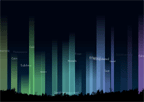
Conjuring the Northern Lights
We invite you to participate in the Aurora Live online project on February 5, 2006; Time: 2:30 pm - 5:30 pm GMT+2 / 7:30 am -10:30 am EST (Time varies by geographic time zone, please confirm your regional start time).
Aurora Live is part of The Aurora Feast Public Art Project, a collaborative exhibition currently featured at Heureka the Finnish Science Centre in Vanta, Finland. Aurora Live is an interactive, real-time, web-based visualization of personal and cross-cultural interpretations of the Northern Lights (Aurora) phenomenon. In a single word, what does Aurora conjure in you? Is it a feeling, a sensation? An image, a vision? A memory, a thought? A place or a dream? Tell us!
On Sunday, February 5, 2005, your one-word descriptions of the northern lights can be submitted globally, on location, and in various languages. Send us your Aurora word via SMS or web-form on the Aurora Feast website. Your interpretive words are passed through our database, onto a web-accessible site. Our interactive program will integrate your singular word contribution and enlighten it within the transformative display of the Aurora Live site.
Send us a little Aurora energy in one word, and we'll infuse it into our Aurora big picture. Please submit your word ON SUNDAY, FEBRUARY 5 via our website or Submit your word via SMS messages to: +358-50-4316621. We hope to hear from you!
The Aurora Live Collaborative Team: Nina Czegledy, Daniel Barber, Seken Chung, Trevor Haldenby, Chris Hession, Deborah Hession, Greg Judelman, Duncan Kushnir, Caitlin O'Donovan
Posted by jo at 09:16 AM | Comments (0)
Haile/Pow
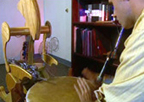
The Robotic Percussionist
Let's imagine a typical situation: a jam session where talented musicians play all their creativity improvising, listening to each other and reacting to inputs. However let's think about the trio (AKA triumvirate) consisting of Ellington and Mingus with a variation at the drums: not Max Roach but Haile, the robotic percussionist. Defining it as a drum machine would be an understatement, because the prototype developed by Gil Winberg and Scott Driscoll at the Georgia Institute of Technology is an anthropomorphic robot that uses computational power and numerical algorithms to listen to live players, analyze their music in real-time, and play with them in an improvisational manner.
According to Winberg, Haile can generate music that has never been played before, creating a new kind of human-machine interaction able to lead to an innovative sound. This peculiarity would be due to the acoustic and analogue dimension that digital music would start having, reproduced not through speakers but played live - using in this case a Native American Pow-wow drum. The analogue-digital combination emerges also from the wooden texture of the prototype, designed with the collaboration of the College of Architecture, whom the Music Dept. belongs to. The project is part of a research trend, that include experiments like GuitarBot and P.E.A.R.T., aimed to satisfy the intimate desire of many electronic musicians of having an anthropomorphic partner."-Valentina Culatti, neural.
Posted by jo at 08:47 AM | Comments (0)
ARTECONTEXTO
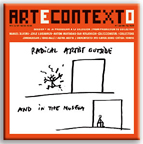
Issue 9: Dossier: Artistic Production and Collecting
ARTECONTEXTO, art culture and new media is a magazine about the art of today that is intended to stimulate discussion and theoretical analysis of artistic practices in the international context. It pays particular attention to new media and net.art. ARTECONTEXTO is a bridge connecting Europe and Latin America.
The profound changes that the world of art is undergoing call for new approaches. Artistic practices are now affected by formulas coming from other fields which call for greater complexity in their analysis and new and different tools of understanding. ARTECONTEXTO takes up and reflects this complexity and constitutes a new critical space in progress.
Issue 9: Dossier: Artistic Production and Collecting--+ Intervention in Space: Dan Perjovschi + Antoni Muntadas + John Baldessari + Ignasi Aballì + Austria in ARCO 06 + Entrevistas + Cybercontext + Info + Books + Reviews.
ARTECONTEXTO is a quarterly publication in Spanish and English. 156 pages in colour. Distributed around the world in specialised bookstores. Publisher and Managing Editor: Alicia Murría; Subscribe before 15th February at a 10% discount.
Posted by jo at 08:26 AM | Comments (0)
The Museum of the Essential and Beyond
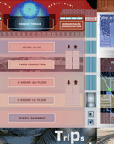
The Museum at the End of Cyberspace
Since 2002, The Museum of the Essential and Beyond has amassed an enormous collection of online artworks. Housed in a labyrinthine virtual building, it's tended to with great devotion by the museum's creator, Regina Célia Pinto. As it's easy to get lost in this wondrous playground, Pinto has created a visual map of the museum: visitors can take a lift from the basement to the attic and browse the works on offer at each level. More than a hundred artists are represented, including Anna Maria Uribe, Stelarc, Jimpunk, Jess Loseby, Nicolas Clauss, Maya Kalogera, Millie Niss, Geert Deekers, and Annie Abrahams--to name but a few. The home page offers a number of ways into the collection besides the map. Once inside, visitors will be seduced by beautiful dances, sidetracked by interactive games, and mesmerised by virtual train trips. Thoughtfully, the museum has a restaurant and bathrooms, so all your needs can be met while you forget your deadlines and appointments and abandon yourself in the museum with no admission lines. - Helen Varley Jamieson, Net Art News, Rhizome.
Posted by jo at 08:06 AM | Comments (0)
February 02, 2006
February 2006 on -empyre- soft-skinned space

Sedition
Australia's recently enacted Sedition Act undermines the right of free speech, which has "ever been justly deemed the only effectual guardian of any other right" --James Madison (Fourth President of the United States and an author of the US Constitution). This month on -empyre-, the discussion will focus on the legal term sedition, and its political impact on global media and culture. Our guests this month: Critical Art Ensemble (CAE) members Lucia Sommer and Claire Pentecost (US), Nicholas Ruiz (US), and Ben Saul (AU). Please join our guests for conversation on 'sedition' at http://www.subtle.net/empyre
On an international scale, the prosecution of Steve Kurtz from Critical Art Ensemble is a case in point. The ongoing court case with the US Justice Department has demonstrated the effect that the "war on terror "has had on limiting free speech, particularly in the arts.
In December 2005, the Anti-Terrorism Bill was pushed through the Australian Parliament. This legislation has met with much concern from the cultural sector and human rights and freedom of speech advocates. On 27 October 2005, Chris Connolly from the University of New South Wales, in a Submission to the Senate Legal and Constitutional Committee, outlined many issues that were raised in regard to Sedition. In his appendix regarding "Sedition in the Arts" he makes the comment that the best known use of sedition laws was during the period of McCarthyism in the USA in the 1950s.
Is this where we are headed? -empyre- in February asks the question. as artists and cultural producers are we losing our right to express ourselves and comment on the state of our society?
The discussion will also look at how sedition laws could affect online activist networks like Indymedia and Znet. As such network operate as open publishing systems, will there be limitations in the capacity to publish and disseminate content?
Guest Bios:
Lucia Sommer is an artist, writer, and activist whose work is concerned with pleasure in everyday life and the creation of critical ephemeral publics. Since 1994 she has taught art in various settings from public school to museum, and her work has been shown individually and as part of the cyberfeminist collective subRosa in Europe and North America. Currently she is pursuing a PhD in Visual and Cultural Studies at the University of Rochester, NY.
Claire Pentecost is an artist and writer, engaging a variety of media to interrogate the imaginative and institutional structures that organize divisions of knowledge. Having spent years tinkering in a conceptual laboratory for ideas about the natural and the artificial, her most recent projects concentrate on industrial and bioengineered agriculture, the alternatives and the trade regimes that force one over the other. She has been an active member of the Critical Art Ensemble defense fund (www.caedefensefund.org).
Nicholas Ruiz III was born in New York City. His work has appeared in Noema Tecnologie e Society, Rhizomes.net, Media/Culture.org.au, The International Journal of Baudrillard Studies, Reconstruction, Public Resistance and elsewhere. He is also the editor of Kritikos: http://garnet.acns.fsu.edu/~nr03/
Dr. Ben Saul is a Lecturer in the Faculty of Law at the University of New South Wales, the Director of the Bill of Rights Project at the Gilbert + Tobin Centre for Public Law, and an Associate of the Australian Human Rights Centre.
empyre forum
empyre[at]lists.cofa.unsw.edu.au
http://www.subtle.net/empyre
Posted by jo at 06:08 PM | Comments (0)
The Exchange Project
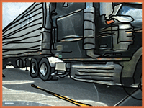
Performance of Technology Tracked Free Trade
The Exchange Project--by Nancy Nisbet--is an artistic inquiry that uses cultural resistance to unsettle questionable relationships between international politics, technological surveillance, and identity construction. Specifically this project addresses 1. The politics of trade agreements such as the North American Free Trade Agreement (NAFTA), 2. Myths of increased national security through technological surveillance of people and commodities and 3. Identity construction based on collections of economic and surveillance data. One outstanding feature of the Exchange project is a cross-border performance that combines Radio Frequency Identification (RFID) surveillance technology, a full-size transport truck, and all of Nisbet’s personal belongings.
In this sustained performance, Nisbet’s things will be inventoried, radio frequency tagged and freely traded with individuals encountered during the six month trip that circumnavigates Canada, the United States and Mexico. This project exchanges the studio for the roads, truck stops, border crossings and cities of North America. “Exchange” creates through the untidy weaving of politics, surveillance technology and identity construction. From the spaces between these coarse threads will emerge resistance, solidarity, vulnerability and moments of human connection.
BIOGRAPHY: Nancy Nisbet is a Vancouver-based artist. From a disturbing paintball gun performance enacting the chaotic fluctuation in the cost of crude oil during the lead up to the US-led War in Iraq/ War on Terror to the surgical implantation of 'identity' micropchips into her hands, much of her work considers the political, the technological and the personal. Of specific consideration in her mixed-media work are issues of power, economics, and surveillance and their cultural influences on entertainment/leisure, identity and community. Exchange 2006 is a large scale project currently underway.
Nisbet received her MFA in Photography from the California Institute of the Arts. She is currently Assistant Professor of Visual Art in the Department of Art History, Visual Arts & Theory at the University of British Columbia.
Launching May 1, 2006 at the Richmond Art Gallery. More information here [PDF]
Posted by jo at 05:00 PM | Comments (0)
UBERMORGEN.COM
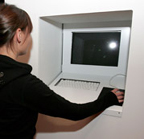
G3 – Bureaucrazy
What does the term "authenticity" amount to in the age of digital replication? In their installation G3-Bureaucrazy the Austrian artists group UBERMORGEN.COM investigates this question. The suggestion of bureaucratic lunacy is meant to be taken completely seriously. With the help of four software generators, including an injunction generator and a bank statement generator, digital documents like bank statements, identity papers and court judgments are produced in personalised form and can be printed out on the spot. By characterising these documents as being no more than ink on paper, UBERMORGEN.COM call into question the arbitrary authority of every bureaucratic system. The installation forms part of the polemical series [F]originals – forged original documents. At Transmediale 06.
Posted by jo at 03:58 PM | Comments (0)
Jean Pierre Gauthier at Transmediale 06
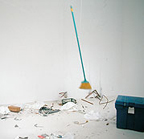
Household Objects Revolt!
Jean-Pierre Gauthier's mobile sound installations express the delights of disorder. He takes daily objects out of their context, rearranges them and sets them going in autonomous movement sequences. Most of the works of Gauthier consist of objects which can be identified, but which do not trigger any emotional or cultural associations. A characteristic feature of his installations is the use of household articles and cleaning products, which may be read as a kind of commentary on prevailing social circumstances. The things make themselves independent, declare revolt and bear a symbolic reference, as a closed microsystem, to aspects of commercial exploitation and economic cycles. In his installation Remue-ménage the artist also succeeds in involving the residual waste of the exhibition's architecture. The analog animation movements of the gadgets lend the installation a faintly antiquated character – an altogether unusual, but deliberately chosen form in contrast to the technological development. At Transmediale 06.
Posted by jo at 03:43 PM | Comments (0)
Transmediale 06: Maurice Benayoun
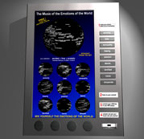
Emotion Vending Machine 2006
Also at Transmediale 06: Maurice Benayoun's Emotion Vending Machine--The mechanics of the world’s emotions evolve in the zone where economics and politics converge, in the world of product placement. Through its concept of artistic merchandizing, the Emotion Vending Machine deals with the production of emotions in an ironic way. The Machine takes Internet data as a global pool of emotions. Users can select up to three emotions from a list of nine emotional states, including hate, desire, or despair. The emotions are represented by 3D-maps of word clusters, extracted from the web and generated in realtime.
These maps show the emotions of the world as they are present on the web at that moment, mapped onto the actual position of major cities on the globe, a mix which can also be read like a music score. The musical interpretation deciphers the cities and their emotional polarity to produce a specific musical result by adapting rhythm, coloration and evolution to the selection of the emotional states made by the user. After listening to the personal result through the integrated speakers, users can plug in their USB stick or MP3 player to load their emotional sound remix.
Music: Jean-Baptiste Barrière; Software: Birgit Lichtenegger, Artem Baguinsky, Marloes de Valk (V2); Production: CITU, Paris.
Posted by jo at 03:32 PM | Comments (0)
g.volt
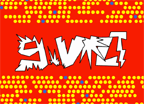
Girls Engaged in the Digital Art R/Evolution
Announcing a collaborative faculty and student web project sponsored by the Center for Women's Intercultural Leadership (Saint Mary's College, Notre Dame, Indiana):
Saint Mary's College Department of Art faculty and students--Profs. Julie Tourtillotte and Krista Hoefle with students Emily Fannon and Kristin Stransky--will be attending the Transmediale Digital Art Festival in Berlin, Germany as g.volt--girls engaged in the digital art r/evolution--from February 2-8, 2006. Track their ongoing adventures via blog, photos, and virtual maps updated regularly at their website--www.gvolt.org--beginning Thursday, Feb. 2nd.
Please contribute to our database of emerging digital media artists by submitting your url...follow the "submit this" button off of our splash page at www.gvolt.org!
Posted by jo at 03:22 PM | Comments (0)
System for Multiple Compositions on a Theme
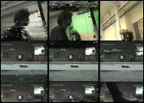
Co-Authors/Users, Separated/Distributed, Across Space/Places
System for Multiple Compositions on a Theme--by Garrett Lynch--is a series of videos shot and edited on analog equipment in 1995 for the sole purpose of experimenting with editing video to create audio compositions. Rather than the norm of composing a video, the image, into a sequence, here the audio was composed and the accompanying image became incidental, secondary. The re-presentation of the video experiments on the internet not alone document and expose them to a wider audience than the original analog cassettes but also serves as a means to progress the early video experiments as a website experiment.
The network provides a means to reconfigure the way the work is viewed by changing the artist's (sole author of the art work) relationship with his audience. The artist, rather than defining a narrative, defines a framework for the art to work within. Experimentation with methods of sending, retrieving and presenting information on the internet, such as the use of html forms and server side scripting allows him to this time construct a system for controlling / viewing the art work rather than an art work that is simply to be viewed. The spectacle of cinema and its audience is replaced by individual user's, separated and distributed across many spaces / places, each as co-author's / contributor's with the artist to their viewing and interpretation of his work.
The composition creation interface on the website, allows users to actively participate in the composition of the experiments and experience an approximation of the act of originally editing these experiments by the artist. It consists of a grid of nine positions, three across and three down, where any position on the grid can be occupied by any of the nine videos any number of times. This gives a possible 2318107019760 combinations, where...
18 + 182 + 183 + 184 + 185 + 186 + 187 + 188 = 2318107019760
Videos can be given a parameter to loop, loop back and forth (palindrome) or not loop. Lag, download speed on the internet, as well as video duration is used as a means to offset how the videos will sound / display within the website creating an overlap that is never quite the same.
Reviewed in neural by Valentina Culatti:
The combines, from Duchamp to Raushenberg, have always been an inspirational form of expression for audio visual digital art. However the word 'composition' has different meanings: it is the combining of distinct parts or elements to form a whole; it is the art or act of composing a musical or literary work; it is also a synonym of short essay. With 'System for Multiple Compositions on a Theme' Garrett Lynch (aka asquare.org) tries to synthesize all these meanings in one project. The artwork is a series of videos shot and edited on analog equipment in 1995 for the sole purpose of experimenting with editing video to create audio compositions. After ten years the shot material has been re-presented on the web using an interface that allow users to take part in the composition choosing among 9x9 options for combining the available clips. Repetition and dislocation, made easy by javascript, are the tools to experiment non linear narration and author-users interaction. However video leads audio on the web. And this is a weak point of the project because keeping an inverted relation would have been an original element in an artwork that, even if inspired by artists like Peter Horvath or Christan Marclay, doesn't have the same innovative value.
Posted by jo at 02:50 PM | Comments (0)
The Snow Show 2006
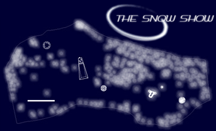
Bridging Art and Architecture
The Snow Show explores the issues related to Art and Architectural investigation by creating works from the ephemeral materials of snow and ice. An artist was partnered with an architect and invited to develop a work together—this conversation created a bridged between the art and architectural worlds. The teamed participants include Kiki Smith and Lebbeus Woods, Yoko Ono and Arata Isozaki, Carsten Höller and Williams & Tsien, Daniel Buren and Patrick Bouchain, Paola Pivi and Cliostraat, Jaume Plensa and Norman Foster.
Where are you by Jaume Plensa and Norman Foster: The white austerity of snow transforms the landscape profoundly. Like in a desert of sand, snow eliminates whatever narrative element there might be in the landscape, to give us the soul of the place in all its purity. GPS technology can give us our precise geographical position, a location in motion. This new form of portrait (of the landscape as much as the body) is, like snow, a metaphor of the ephemeral.
Conceived in 2000 by independent curator Lance Fung, The Snow Show has since constructed seventeen structures that furthered the discussion of interdisciplinary collaboration and set the tone for the current Snow Show. This year, the artists and architects have created interactive experiences inspired by the dramatic natural beauty of Sestriere and the athletic competitions of the Olympics.
03 February - 19 March 2006.
Sestriere, Turin
Posted by jo at 01:43 PM | Comments (0)
Call for Submissions
![]()
Definition 2006: Digital Media Festival
We’re looking for creative, innovative, and unique HD submissions for the Banff New Media Institute (BNMI) Accelerator’s Digital Media Festival! The Definition 2006: Digital Media Festival will be held during the Accelerator’s Definition 2006: HD Summit from April 20 - 22, 2006 at The Banff Centre. The festival is a juried event bringing the best works in HD media from around the world to Banff, Alberta.
Entries can be of any duration in any genre including narrative, story, documentary, animated or experimental, and can be submitted by professional or amateur contributors. An international jury will choose works from those submitted for entry in the festival. Creators of works selected for the festival will receive free tuition and on campus accommodation in Banff during the HD Summit in April. All selected works will be screened at the Definition 2006: Digital Media Festival. Entry Deadline: March 15, 5 p.m. Mountain Standard Time.
For more information contact:
Amy Inkster, Banff New Media Institute Accelerator Program
Phone: 1.403.762.7500
Email: definition[at]banffcentre.ca
Posted by jo at 12:19 PM | Comments (0)
BIP - BUILDING INTERACTIVE PLAYGROUNDS

Do You Want to Play with Space, Time and People?
BIP - BUILDING INTERACTIVE PLAYGROUNDS--2nd edition – Elettrowave, July 14-16 2006 – Arezzo/Italy: We are currently accepting applications to participate in the second edition of BIP, an International Competition for interaction design projects for public events. BIP will happen during Elettrowave, a three day festival of electronic music. Elettrowave is part of Arezzowave, the biggest free music festival in Italy.
01 – WHAT ARE WE LOOKING FOR? If you want to play with space and time and people, if you like crossing barriers and probing around in extreme situations, if you fiddle around with the idea the space can be programmed, if you eat social patterns for your breakfast, if you are not scared by a drunk young audience, if you keep telling your friends that environments are not passive wrappings but active processes, if your perceptions keep shifting, if your projects are about interplay, exploration and humor, if tinkering with technology is your obsession...then... this call for works is your unique chance to experiment with interaction design within the context of an electronic music festival. Nightlife, extreme characters, clubbing freaks, a young, unrespectuful and challenging audience. You know what we are talking about, don’t you?
We are looking for projects. Not vague ideas. Real projects that can substantially and meaningfully enrich the Elettrowave event and strengthen involvement. Clubbing is the context, not the object, of BIP. We’re looking for something innovative, passionate and fresh that can make a difference.
Interactive installations, environments, sound and/or visual projects, etc.
If your project is at an early stage we will consider it only if you can prove you'll be able to produce it within the festival deadline. We may offer production assistance if we fall in love with your project proposal.
Please keep in mind that the projects should be able to stand 3 nights of extremely intense use, in a venue with thousands of people. Please consider production feasibility and all possible setup constraints.
02 – WHO IS ELIGIBLE?
Participation is open to applicants from every country in the world, to (interaction) designers, artists, researchers, architects, students. Participation is free.
03 – SUBMISSION DEADLINE
All project proposals must be postmarked by March 10th, 2006.
Late entries will not be accepted. By submitting a project, the applicant warrants that it is his/her original design.
04 – HOW AND WHEN ARE THE PROJECTS SELECTED?
In March 2006, a panel of jurors will select up to 3 projects.
Winners will be announced during a workshop/event in April. The event will be hosted by Università di Siena, Italy.
05 – AWARDS
Selected projects will be installed for the three nights of Elettrowave 2006. This is a precious opportunity to test your interactive projects in the context of an electronic music festival.
The projects will benefit from a total budget of 10.000 euros offered by BIP. The budget will be divided between the selected projects according to production, transportation and setup costs. BIP will consider supporting production costs of new projects that are being presented to the public for the first time.
Commonly used technology (videoprojectors, screens, audio systems, monitors, mixers, etc.) will be available to the selected projects if required.
06 – HOW MANY PROJECTS CAN I SUBMIT?
Only one project may be submitted per entrant. Teams register with one name only.
07 – SUBMISSION GUIDELINES
The submission form is available for download at http://www.todo.to.it/bip/bip_submission2006.pdf
Please fill out all the information required in the form. Send your submission to:
TODO - BIP 2006
c/o Mail Boxes Etc.
Box 294, Via Boucheron 16
10122 - Torino - Italy
Submissions which do not conform to the rules will be rejected without any notice. There is no legal recourse against this decision.
Submitted material will become part of the festival archives and will not be returned.
08 – ACCURACY AND COPYRIGHT
Any moral and paternity right regarding the project sent in for application is designer’s property.
By participating, you grant BIP the right to edit, publish, promote and otherwise use the entry without further permission, notice or compensation. Credit information may need to be condensed or edited for space.
BIP assumes that all entries are original and are the work and property of the entrant, with all rights granted there-in. BIP is not liable for violations of any third party rights, including, but not limited to, claims of copyright, trademark, patent infringment. BIP assumes that all images provided with entries are free of any third-party rights. BIP will include photographer credits if that information is provided along with the images.
09 – MORE QUESTIONS?
Send inquiries to bip[at]arezzowave.com with "BIP – Call for Works" as the subject line.
10 – ORGANIZATION
BIP is promoted by FAWI (Fondazione Arezzowave Italia) and ARSNOVA.
BIP is realized in partnership with the Università di Siena
The BIP project is managed by TODO interaction design studio.
Posted by jo at 10:26 AM | Comments (0)
February 01, 2006
CONFESS.OR
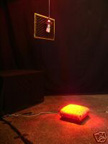
Religion for Rent on eBay
CONFESS.OR is one of the first pieces of Gerhard Schwoiger's ReReligion, a series of works that reflect on the place of religion in everyday life and investigate its Zeitgeist and adaptability.
Upon entering the room the visitor becomes part of an open confessional situation. Once s/he approaches one of the candles or places an ear on it, a single voice can be distinguished from the muddle of voices which forms a wall of noise at a moderate volume. The lattice of the confessional – the single element that is left in its original form – floats over the floor with a microphone in the back part of the room.
Kneeling upon the cushion, summons a female's voice, inviting one to confess. This enables those who avow to make an anonymous confession to the public. Upon leaving the cushion, the confession is automatically over. A confession that manages without the power apparatus of the church, without obligations. Once the confession has been made, it will be meshed with the sounds of previous confessions and omitted out of a few candles in the room. Judgment over the sins of others is placed in the hands of the individual.
Current confessions are available as podcasts (for example for your way to work). You can rent or buy the system on eBay. Acution runs for the next 10 days. Related: Pray as you go, mobile confessions, etc. [blogged by Regine on we-make-money-not-art]
Posted by jo at 11:34 AM | Comments (0)
Women in Games International

Games for and by Women
Games for Women, Games by Women: February 18, San Francisco--The half-day conference includes an opening keynote address, a post-conference networking reception and a recruiter Q&A with resume and portfolio reviews.
Program topics include: Keynote speaker Robin Harper, SVP of Community and Support for Linden Lab, will present "From the Virtual to the Real: How Second Life created an online world and community that strongly appeals to women, and how the virtual world has changed the real life of women participants."
Conference is 12 pm to 7 pm on Saturday, February 18; Fort Mason Conference Center, Landmark Building A. Attendance is $45 and space is limited. [blogged by Erin Dinehart on Interactive Media Division Weblog]
Posted by jo at 11:22 AM | Comments (0)
MOBILEFEST
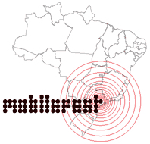
1st Brazilian Festival of Mobile Art
MOBILEFEST is the 1st Brazilian Festival of Mobile Art, based on the sociological implications that mobile phones and mobile technologies have been promoting in our culture. MOBILEFEST will happen in September, 2006 in São Paulo, Brazil, with an agenda composed by two days of cultural and technical activities. MOBILEFEST will include an international symposium, workshops and recognition awarding of the best works and mobile applications developed by Brazilians. Different from other national and international festivals, MOBILEFEST has been designed for the mobile era, that’s why it’s the first festival in the world that only takes submissions of texts, photographs and videos sent via SMS and MMS.
MOBILEFEST CONCEPT: MOBILEFEST was idealized in Brazil from the following reasons and objectives: (1) Popularize the mobile technology as a way to contribute to digital inclusion of those who find difficulties understanding and interacting with these new medium; (2) Promote cultural interchange between national and international researchers of this media; (3) Incentive the promotion of creativity exercise of the 90 million Brazilians that use the mobile technology to transmit much more than voice;
(4) Develop seminars and workshops to guide and stimulate the production of content in the mobile era in Brazil, bringing international experiences and examples; (5) Expand possible software and hardware functions of mobile technology, nourish and incentive scientific thought and production regarding new technologies; and (6) Offer the first awarding specialized in recognizing works that generate mobile technology.
INTERNATIONAL SYMPOSIUM: CALL FOR PAPERS
MOBILEFEST 2006 seeks paper and presentation proposals responding to the
Symposium themes:
How can Mobile Technology contribute to art, culture, democracy, ecology and third sector? Paper presenters will be grouped thematically to encourage discourse that presents divergent perspectives and views that serve as a catalyst for discussion.
Papers submitted are limited to 30 minutes.
Deadline for abstracts: February 28th, 2006.
please send your material to: festival[at]mobilefest.com.br
Posted by jo at 10:59 AM | Comments (0)
Nam June Paik
[Quicktime video] In memoriam Nam June Paik 1932 – 2006:
»There is no rewind button on the Betamax of life.«
Posted by jo at 10:22 AM | Comments (0)
Perplex city
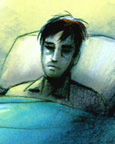
the first self-supporting ARG
Guy says: "Perplex City is a cross between collectible-card game and Alternate Reality Game. It's centered around a stolen artefact, and there's a $200,000 reward for whoever can find it. The cards themselves are rather beautiful and feature a diverse range of mind-bending puzzles, while Anton Bogaty (who you just featured) does much of the artwork for the game. I think it's primarily worth mentioning because it's the first self-supporting ARG, as opposed to marketing something else (or being made on a lo-to-no budget basis.) "Also, Boing Boing itself is on one of the cards!
"There are also some live events coming up in New York and London, making it especially news-worthy right now - anyone can participate, as they aren't especially about PXC, just friendly puzzlin' competitions. Although the London event is closed to sign-ups, after 600 people applied..." (Here is Guy's quick-start guide to the game.) [posted by Mark Frauenfelder on Boing Boing]
Posted by jo at 10:04 AM | Comments (0)
Beatriz da Costa
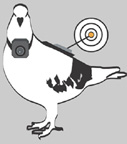
Pigeons that Blog
PigeonBlog--currently being developed by Beatriz da Costa--provides an alternative participatory way to environmental air pollution data gathering. It equips Urban Homing Pigeons with GPS enabled electronic air pollution sensing devices, capable of sending location based air pollution data as well as images to an online Mapping/Blogging Environment in real time....PigeonBlog uses a combination of Siemens’ XT 56 miniature GPS/GSM unit, an electronic automotive CO and NOx sensing unit and the Atmel AVR microprocessor. Detailed tech and datasheet information is forthcoming on this site.
However, in addition to being used for PigeonBlog, Cina Hazegh is currently working on broadening this platform towards a more general Open Source Hardware cell phone project....Pigeons releases will occur once a day throughout the duration of the festival on the ISEA premises. Release location: ClockTower in San Jose. The first release will take place during the opening ceremony of the festival on tuesday evening. Additional “White Dove” releases are planned at strategic high pollutant areas within the San Jose region. Exact locations are to be determined. [blogged by nicolas on pasta and vinegar] Related: Urban Eyes
Posted by jo at 09:29 AM | Comments (0)
Sale Away + Digital Aquarium

Sounding Store Windows
Régine on WMMNA has written up some fabulous interactive shop windows she's read about over the past few months. These two are related to cell phones:
Sale Away: "In Staalplaat's Sale Away, passers-by could conduct an "orchestra" of household devices via their mobile phones on a display window. The mechanical orchestra consisted of flute, organ and brass playing vacuum cleaners, rattling kitchen mixers, buzzing ventilators, radio playing toy trains, wobbling jigsaws, dancing tumble dryers, humming refrigerators and other misused household utilities. [blogged here as well]

The Digital Aquarium: The Digital Aquarium, by Digit, featured 150 pre-programmed mobile phones in a glass tank on display at London's Design Museum in 2002. When viewers dialed the number on the side of the tank, the handsets vibrated, their screens lighted up and each one emited a distinctive ring tone, creating an effect which is meant to look like a school of fish swimming around. (image Sensory Impact). [blogged by Emily on textually]
Posted by jo at 09:09 AM | Comments (0)
Bordergames
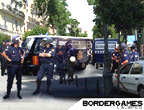
Technology, Games, Empowerment
Bordergames is a series of workshops, a videogame engine and an editor which allows young migrants not only to design a video game where their experiences are the main element, but also to learn the importance of taking over new technologies and using them to self organize and recover the control over their own lives and environments.
Bordergames is a working project directed to young migrants, in this first stage Moroccan teenagers living in Madrid. Our basic tenet is providing a series of tools for them to fully recover their right to their own word and expression, and doing it in a language they feel specially close to them: that of videogames.
Bordergames organizes meetings and workshops...through which the Moroccan kids discuss the stories they want to tell and then learn programming, editing and producing 3D scenarios and characters for the videogame they have decided to produce. Related: mimoSa
Posted by jo at 08:45 AM | Comments (0)
Tempest For Eliza
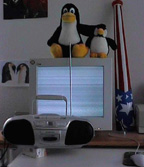
Observe without Touching
Tempest for Eliza, by by Erik Thiele, is a program that uses your computer monitor to send out AM radio signals. You can then hear computer generated music on your radio. You need no additional hardware to understand that it is really possible to observe your computer without physically touching it. (tempest). I wrote this program because it was fun and because it teaches in an amusing way that tempest really exists. I want people to understand that their computers can be observed. And last but not least you can listen to music without a soundcard!
How does this work? All electronic devices send out eletromagnetic waves. So does your monitor. And your monitor does it all the time at very high frequencies, high enough for your short wave AM radio. All you have to do is display the "correct" image on your screen and your monitor will emit the "right" signals. Tempest for Eliza displays pictures on your screen, one for
each note in the song.
Posted by jo at 08:11 AM | Comments (0)

